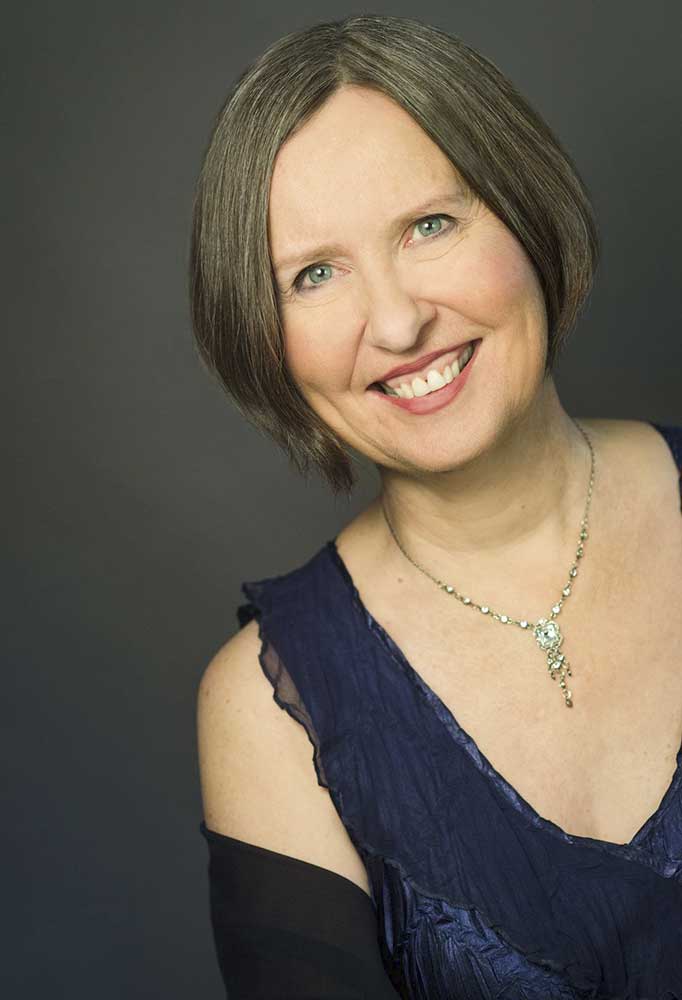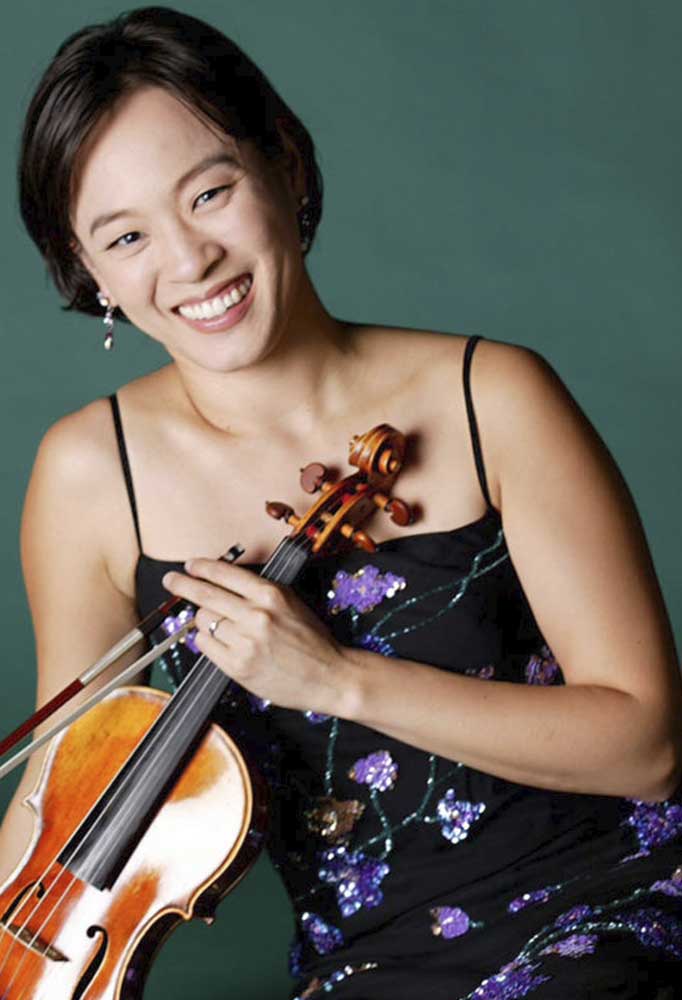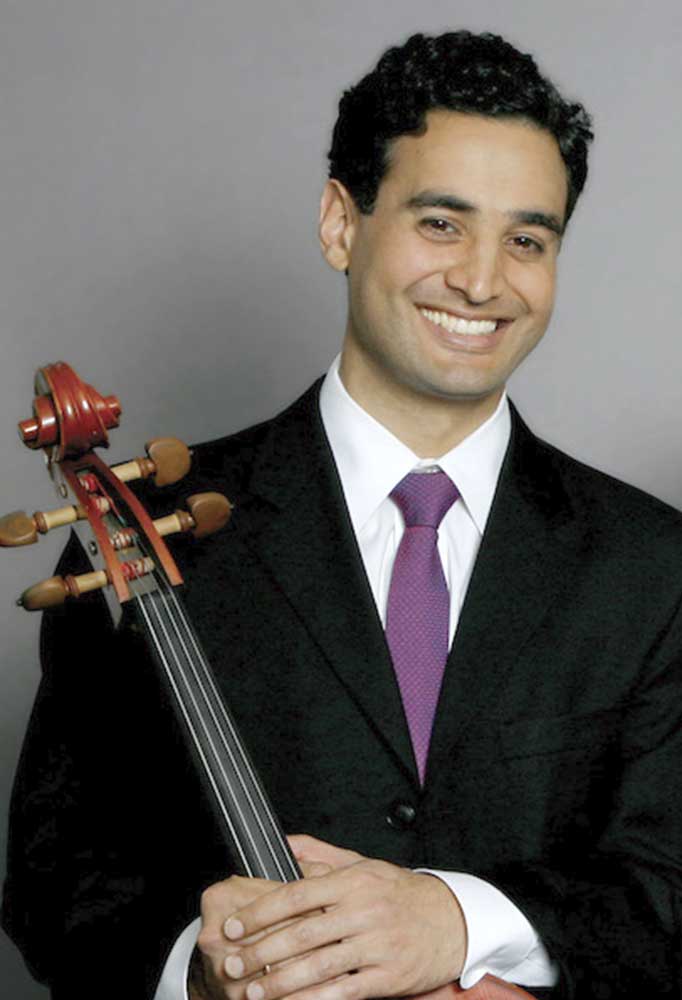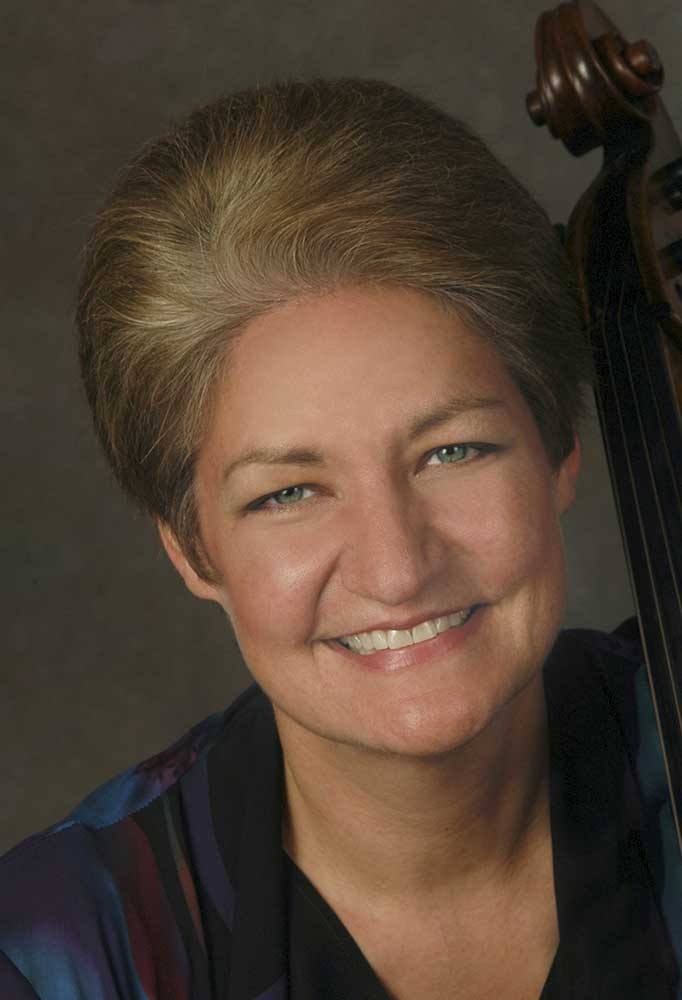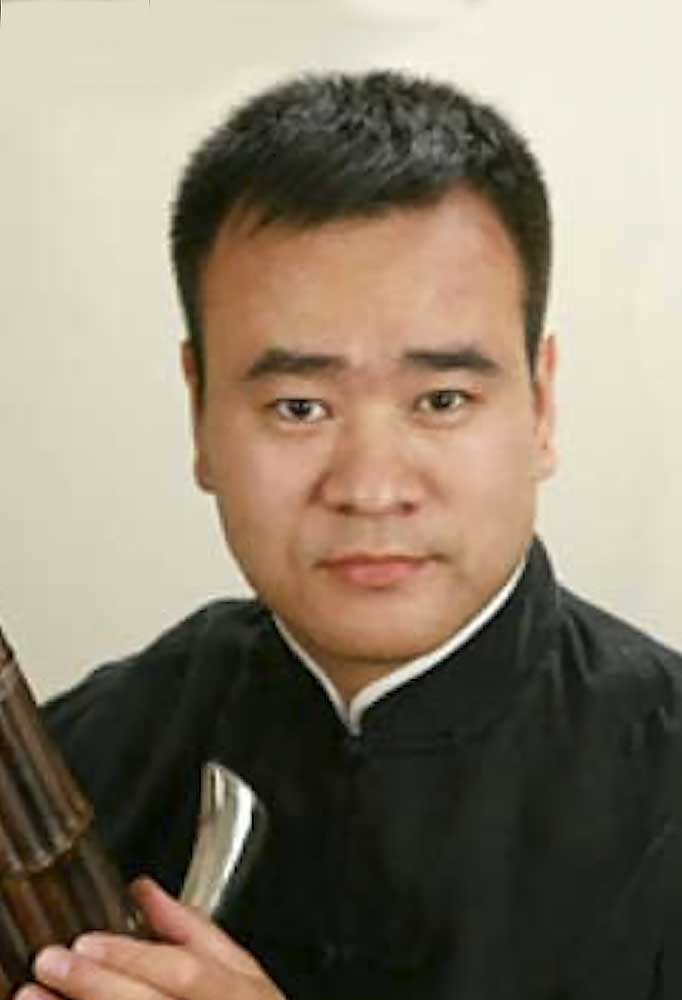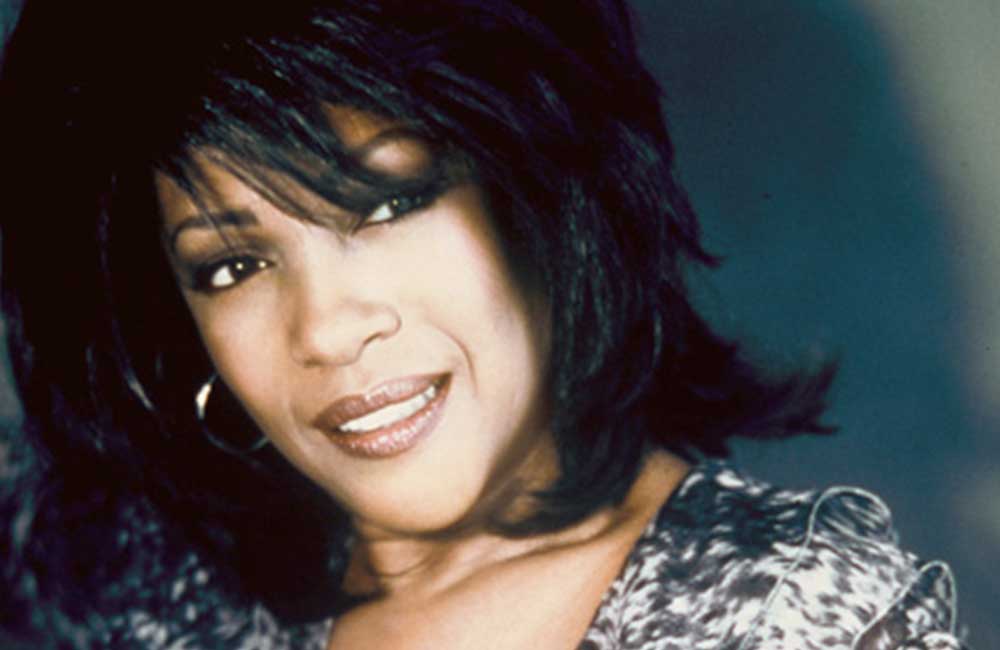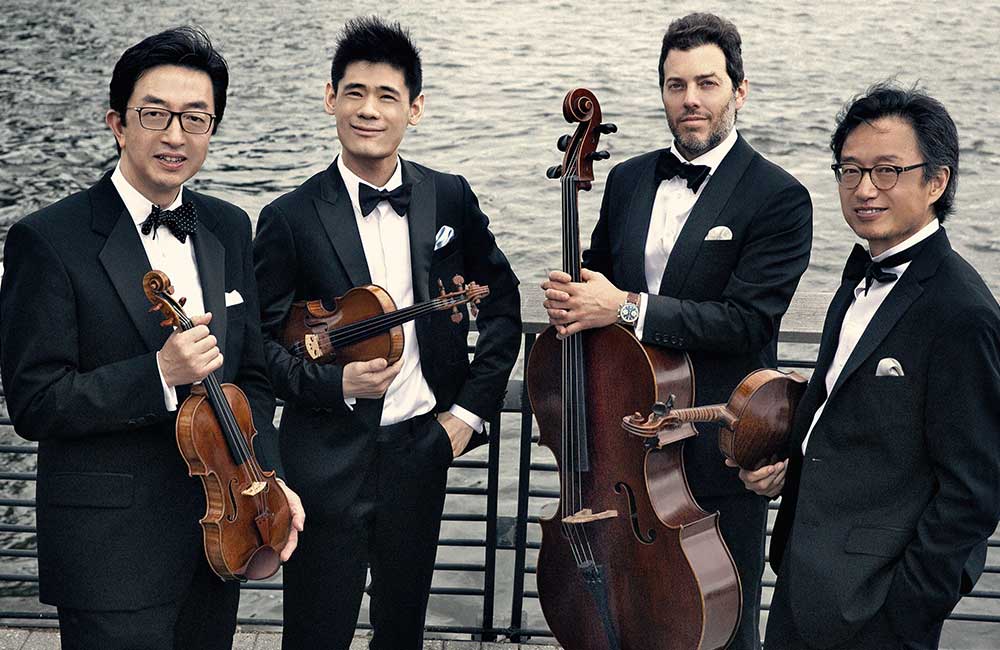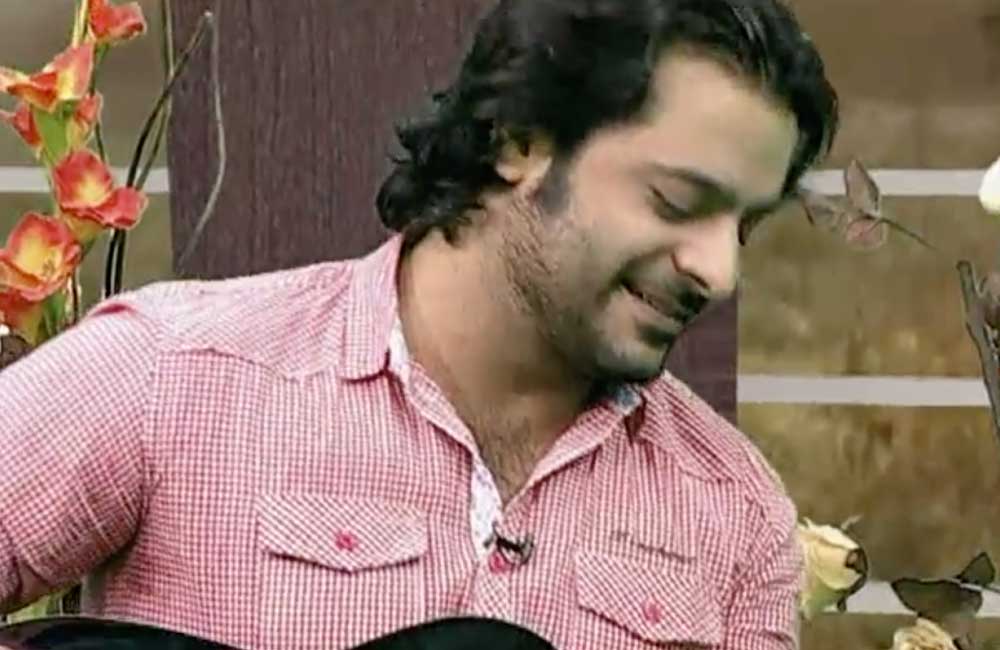
A Look Back
As we look ahead toward our next chapter,
here’s a look back at the concerts and benefits
of Musicians For Harmony’s first decade.

Click an event to see a popup window with photos, captions, and
buttons for viewing the program and promo material.
Click above windows to close.
![]()
CONCERT 2011
Merkin Concert Hall • September 11, 2011
Juilliard Quartet • Kinan Azmeh • Kojiro Umezaki • New York Arabic Orchestra • Bassam Saba
CONCERT 2010
October 19, 2010 • LeFrak Concert Hall • Queens College, Flushing, NY
Diane Walsh • Edward Arron • Catherine Cho • Raman Ramakrishnan • Marcy Rosen • Hu Jianbing
CONCERT 2010
April 8, 2010 • Merkin Concert Hall
Borromeo String Quartet • Imani Winds • Randall Scarlata • Mohammed Fairouz
CONCERT 2009
September 10, 2009 • Merkin Concert Hall
Shanghai Quartet • Ljova & The Kontraband • Mary Wilson • Nauman Khan LaSharie
DAY FOR PEACE CONCERT 2009
March 20, 2009 • Saint Peter’s Church
Kinan Azmeh • Karam Salem
CONCERT 2008
September 11, 2008 • Merkin Concert Hall
Shanghai Quartet • Kinan Azmeh with The Knights • Karim Wasfi
SPRING BENEFIT 2008
May 14, 2008 • Goethe Institut
Eugenia Zukerman • Tara Helen O’Connor • Ursula Oppens
CONCERT 2007
September 11, 2007 • Symphony Space
Shanghai String Quartet • Claude Frank • Wu Man • Musique Sans Frontières
IRAQI SUMMER ARTS ACADEMY • 2007
Allegra Klein returned to Iraq in July 2007 for the first-ever Iraqi Unity Performing Arts Academy.
Read about her trip and view photos and press articles.
SPRING BENEFIT 2007
March 28, 2007 • Steinway Hall
Anne Akiko Meyers • Avram Pengas
CONCERT 2006
September 11, 2006 • Merkin Concert Hall
Orion Quartet • Leon Fleisher • Mark O’Connor • Musique Sans Frontières
SPRING BENEFIT 2006
May 23, 2006 • Goethe Institut
Carter Brey • Bassam Saba
CONCERT 2005
September 13, 2005 • Merkin Concert Hall
Shanghai String Quartet • Members of the Guarneri Quartet with Anna Polonsky
Siamak Jahangiri • Musique Sans Frontières with Avram Pengas
SPRING BENEFIT 2005
May 12, 2005 • Rose Studio at Lincoln Center
Jonathan Biss
CONCERT 2004
September 13, 2004 • Merkin Hall
Shanghai String Quartet • Members of the Guarneri Quartet with Anna Polonsky
Hassan Al-Muftii • Gerard Edery Ensemble • Musique Sans Frontières
SPRING BENEFIT 2004
March 29, 2004 • Steinway Hall
Members of the Iraqi National Symphony Orchestra
TRIP TO IRAQ 2003
Allegra Klein made a special trip to Iraq in November 2003 to deliver badly needed
musical instruments and supplies to the Iraqi National Symphony Orchestra
and Music and Ballet School in Baghdad.
CONCERT 2003
September 10, 2003 • Merkin Concert Hall
Members of the Guarneri Quartet with Anne-Marie McDermott
Juilliard String Quartet • Shanghai String Quartet
Omar Bashir • Musique Sans Frontières with G.E. Smith
CONCERT 2002
September 10, 2002 • Merkin Concert Hall
Guarneri Quartet • Juilliard Quartet • Shanghai Quartet • Musique Sans Frontières
Fall Concert • September 11, 2011
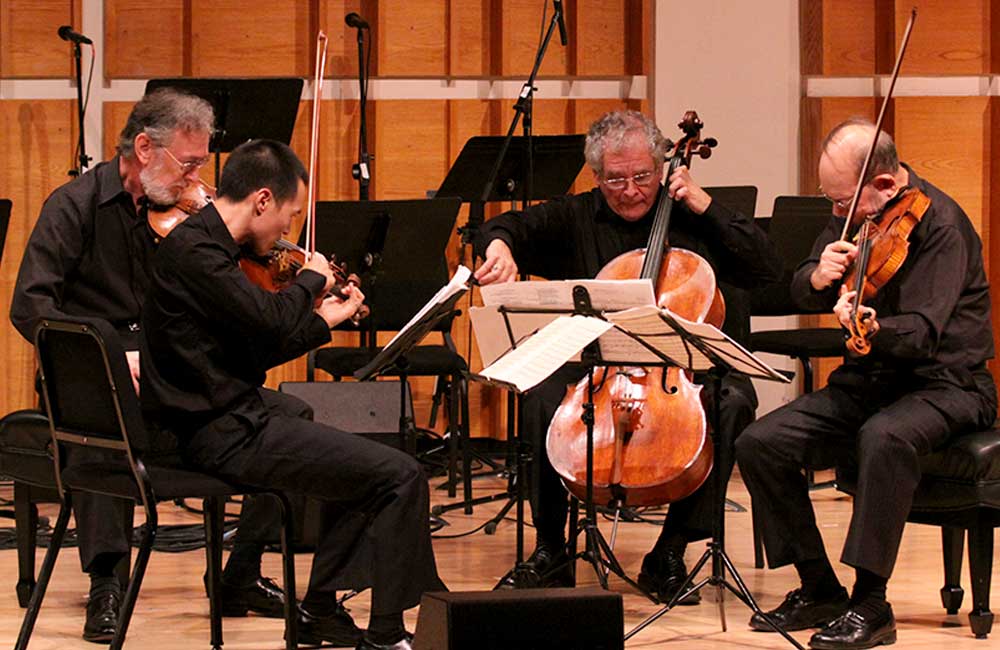
1
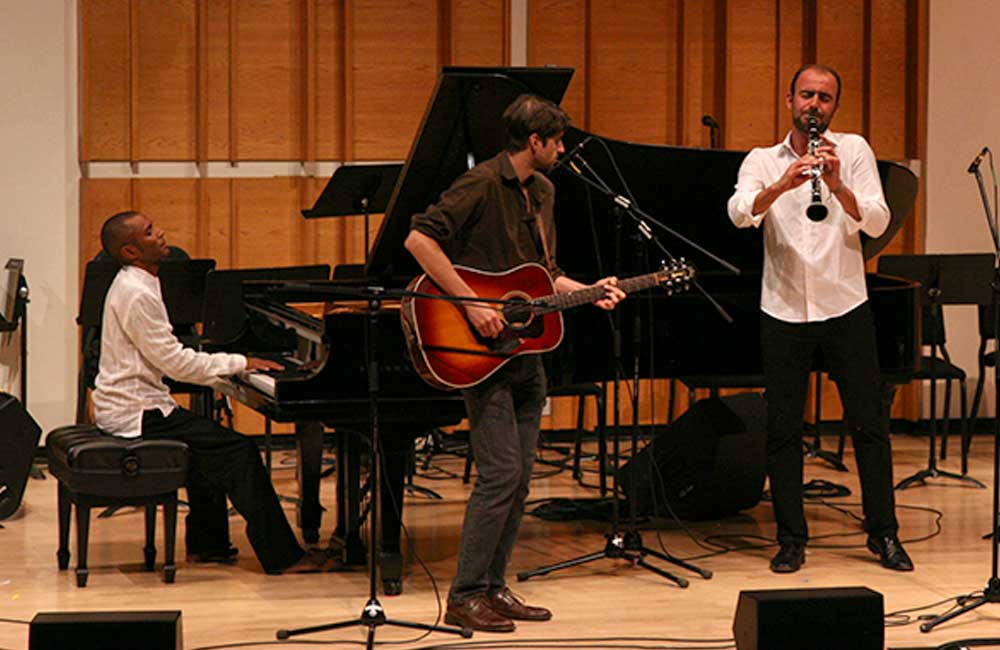
2
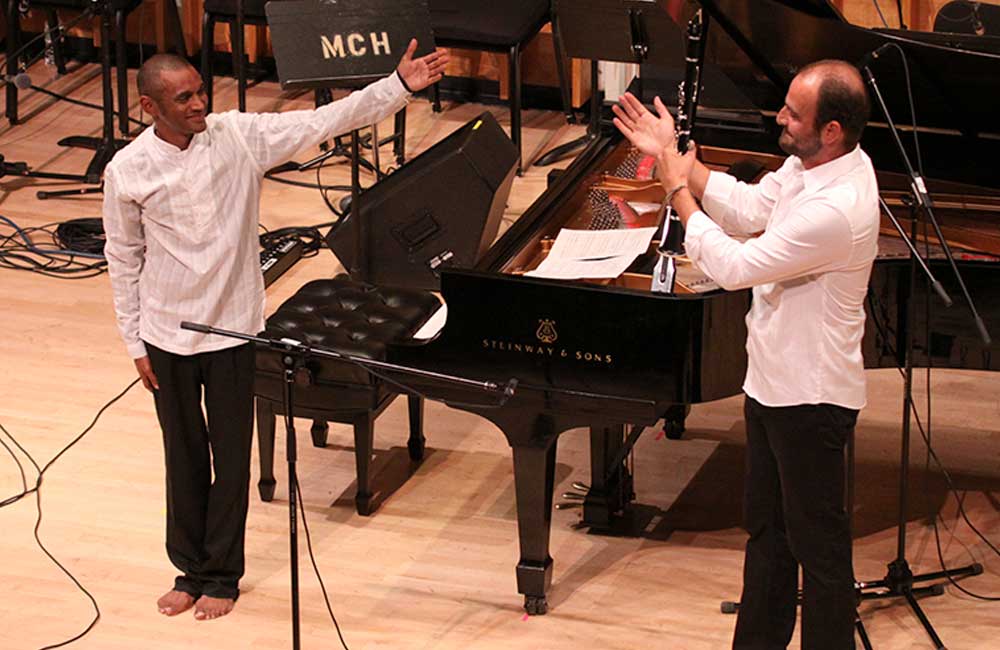
3
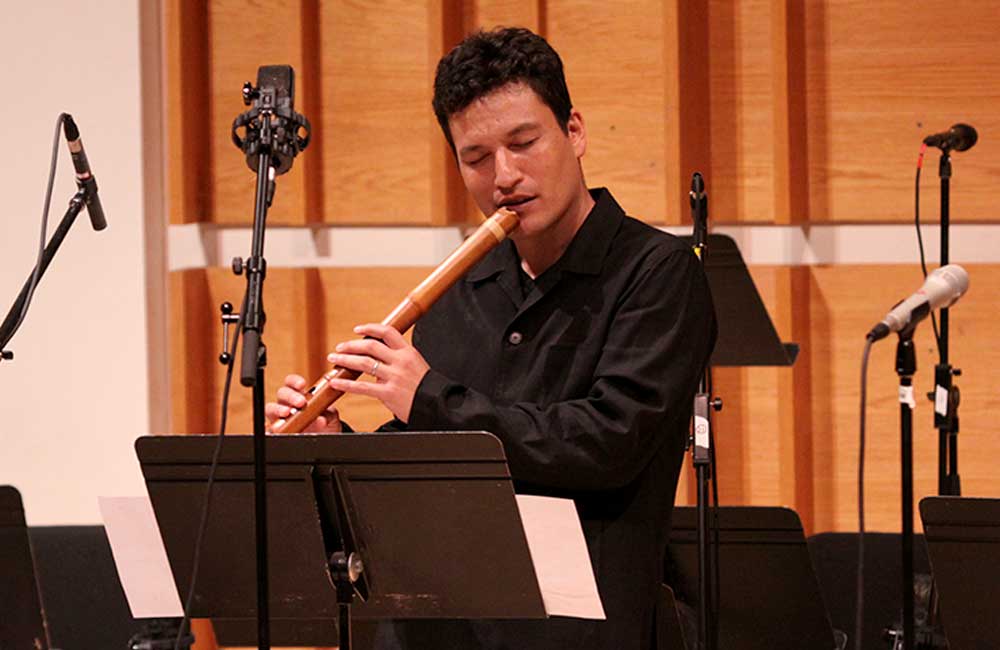
4
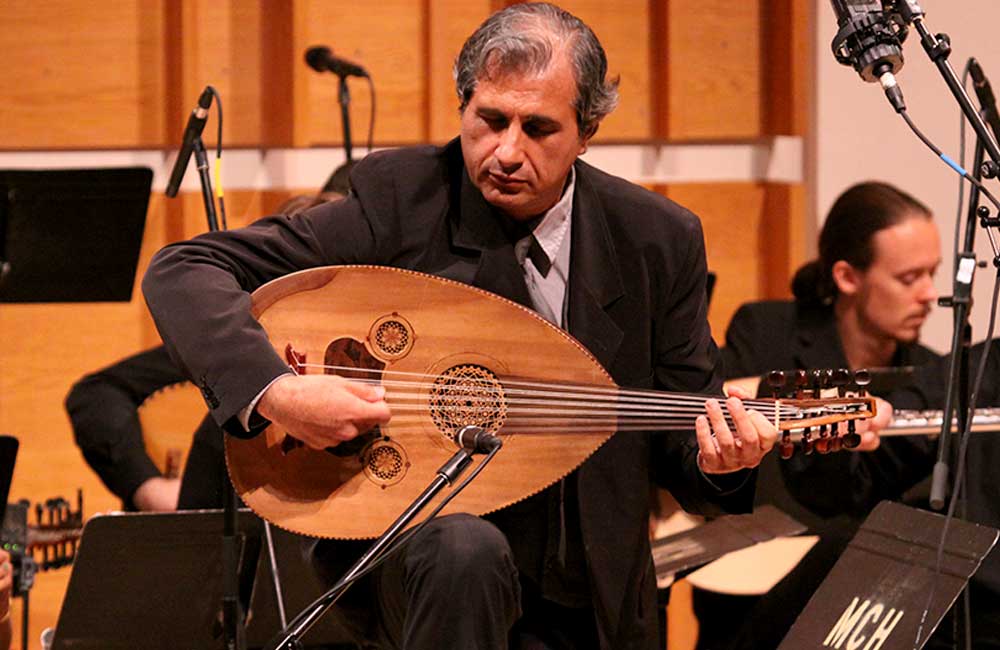
5
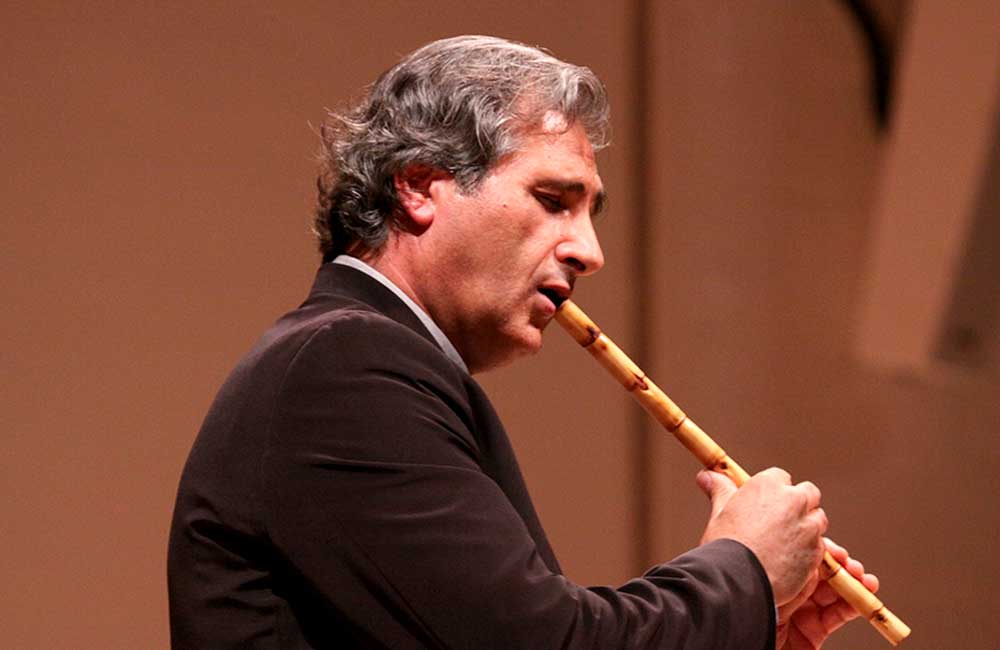
6
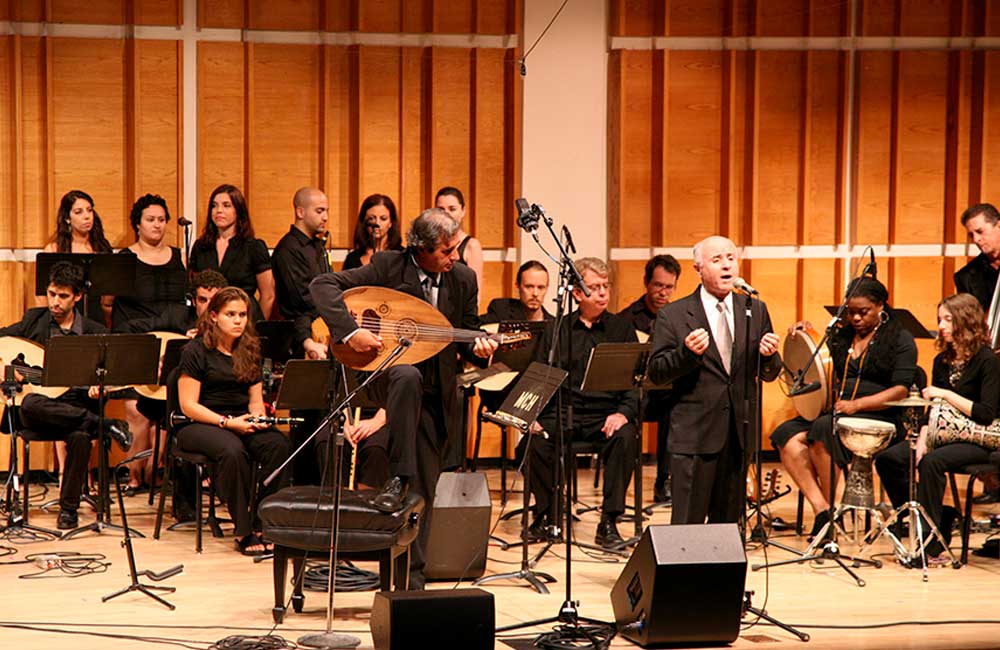
7
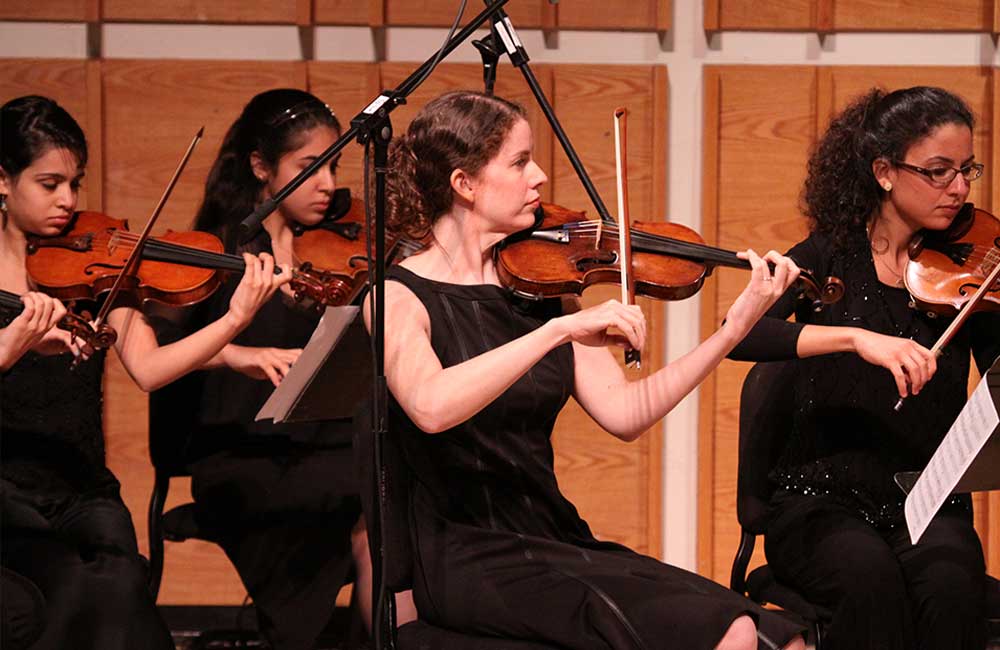
8
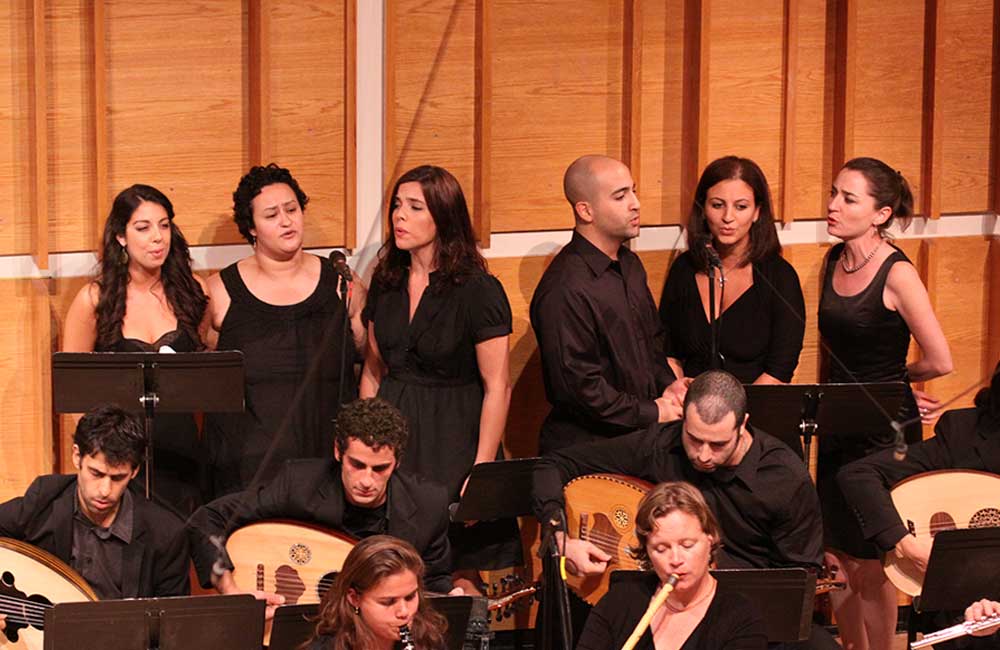
9
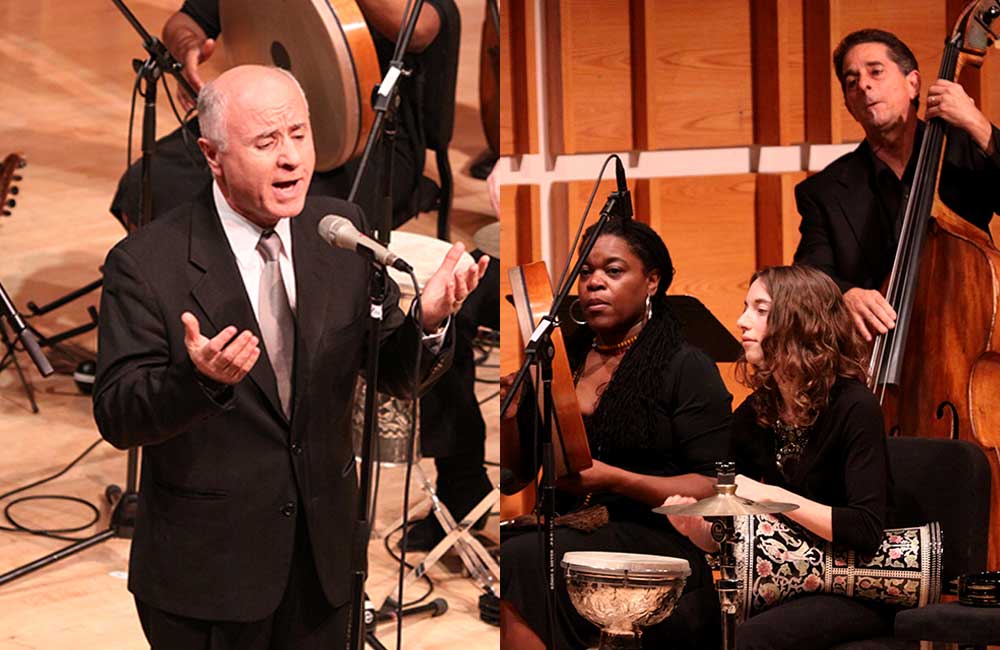
10
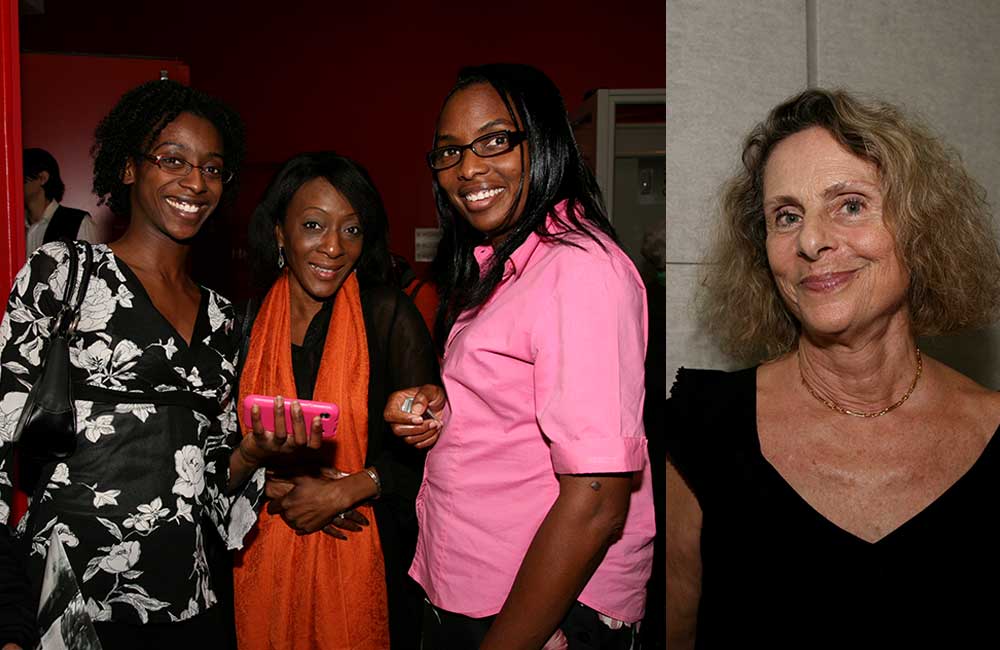
11
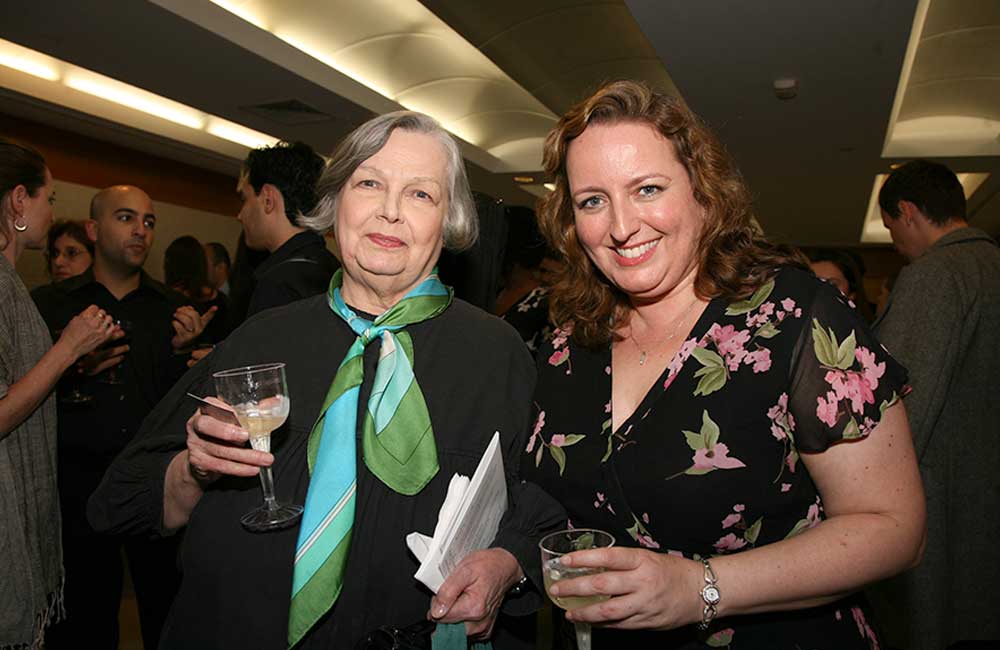
12
Musicians For Harmony celebrated its Tenth Annual Concert for Peace at Merkin Concert Hall in New York City on September 11, 2011.
1) The Juilliard Quartet performs Leos Janacek’s String Quartet No. 2, “Intimate Letters.”
2) & 3) Clarinetist Kinan Azmeh and pianist/composer Dinuk Wijeratne perform original works with guitarist Kyle Sanna.
4) Kojiro Umezaki, shakuhachi player and composer, performs his solo work “..seasons continue, as if none of this ever happened..” which was commissioned for the 2011 M4H concert.
5) & 6) Lebanese musician Bassam Saba, seen here performing on the oud and nay. Mr. Saba, who appeared on several M4H concerts, passed away in 2020 after losing a battle with Covid-19.
7), 8) & 9) New York Arabic Orchestra, led by Bassam Saba.
10) Singer Naji Youseff performs with the New York Arabic Orchestra.
11) Guests at the post-concert reception (l. to r., Jessica Bedney, Hadiza Dockeray, Anne-Marie Bedney and volunteer Babs Kolber).
12) Julie Van Ness and Allegra Klein.
Spring Concert • April 8, 2010
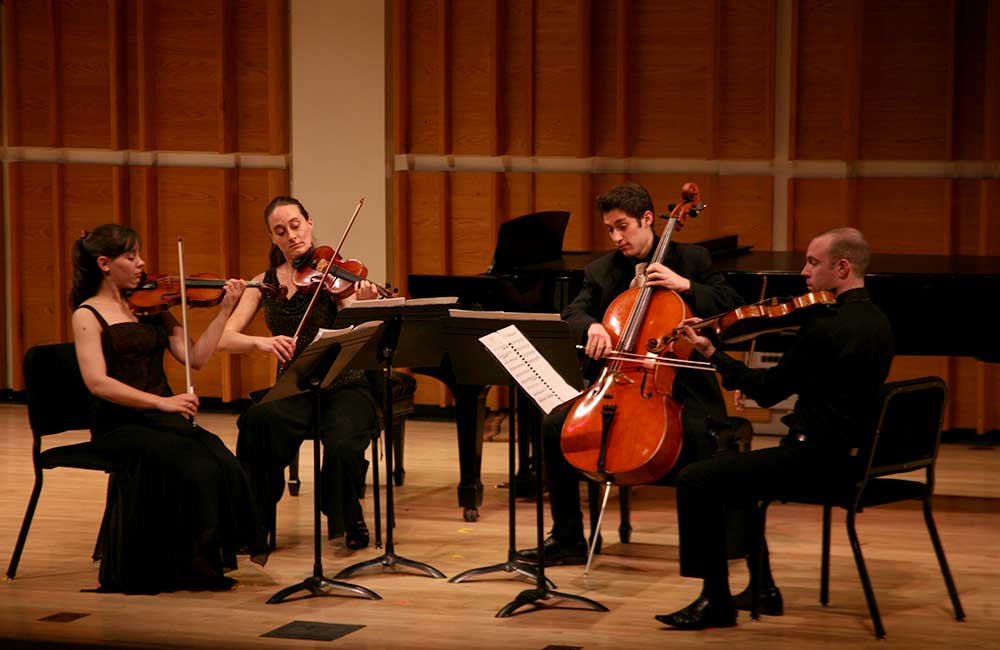
1

2
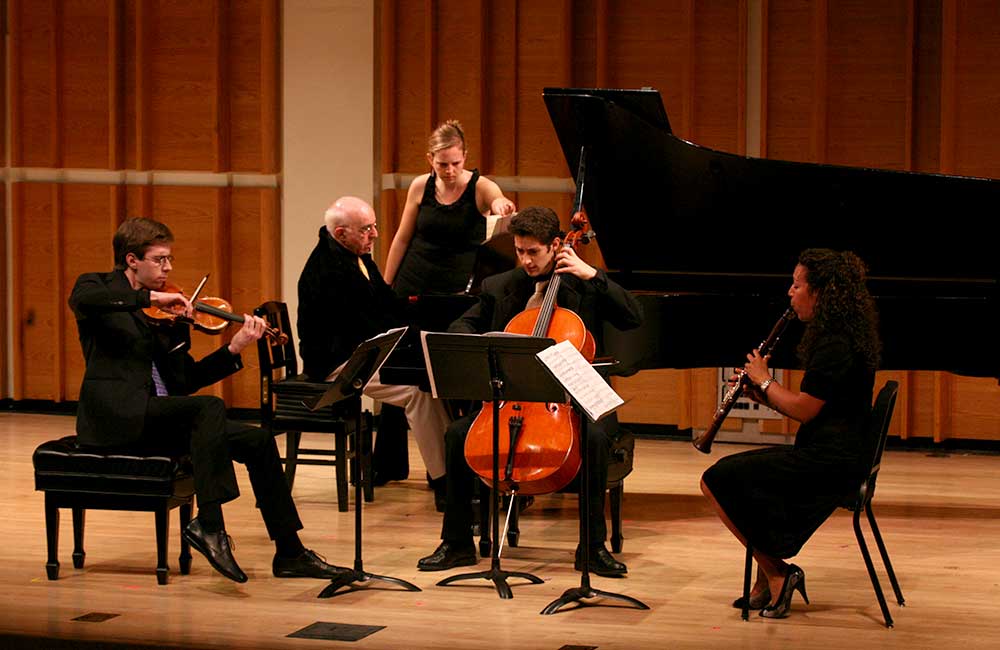
3
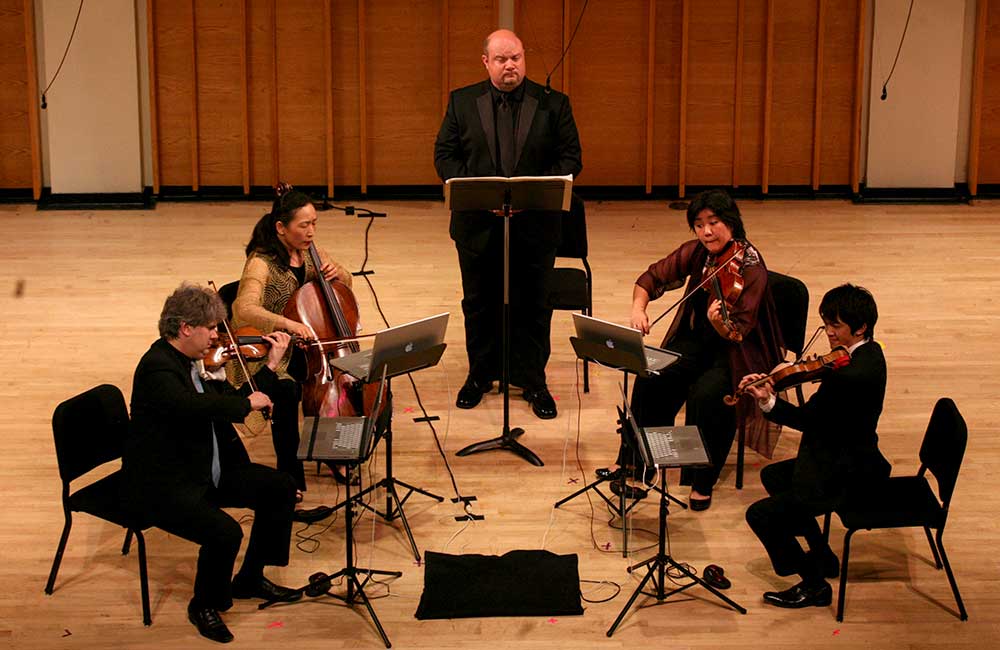
4

5
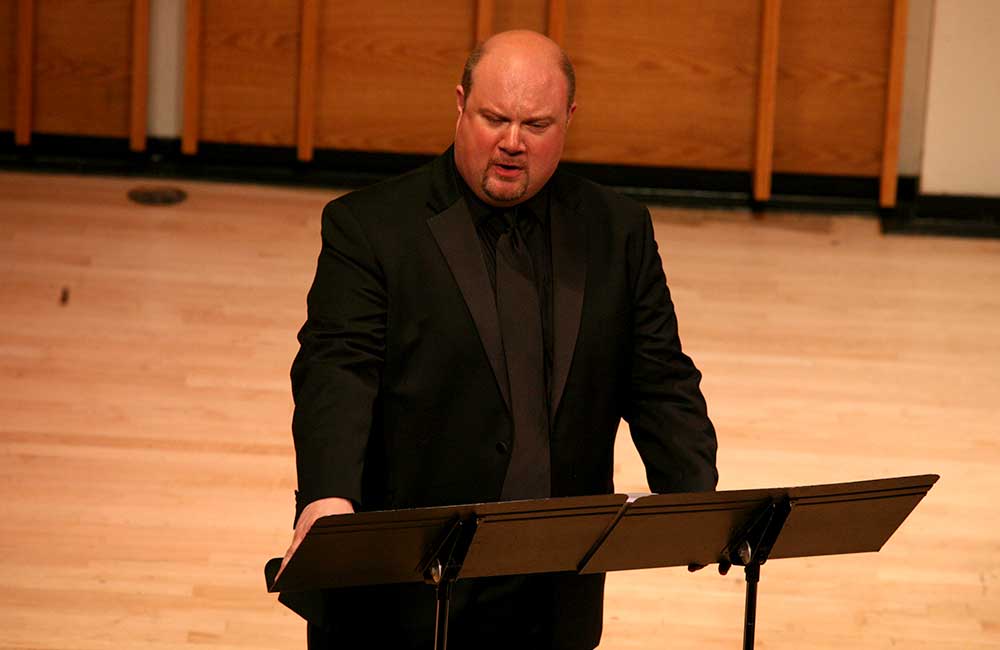
6
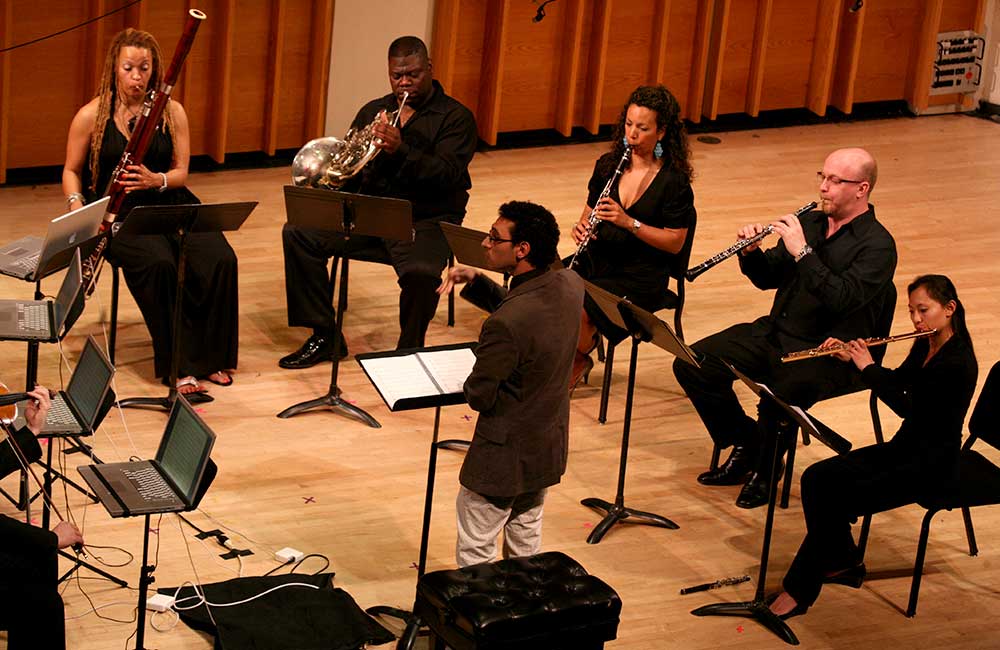
7
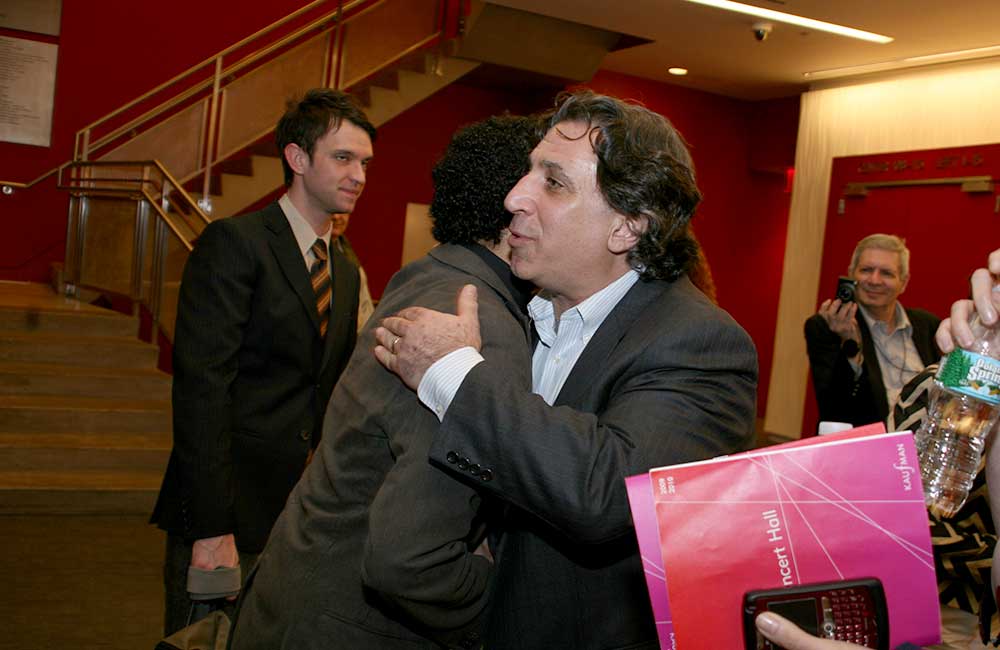
8
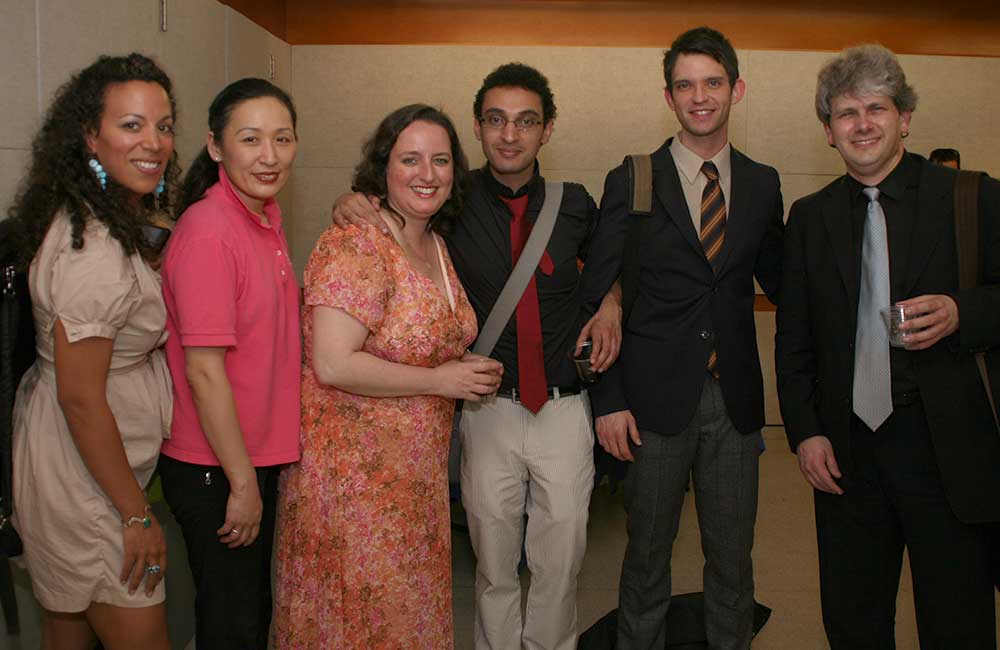
9
In the spring of 2010, Musicians For Harmony presented a concert featuring works by five of the foremost living composers of Jewish and Arab origin.
1) Halim El-Dabh’s “String Quartet: Metamorphoses and Fugue on Egyptian Folklore,” composed in 1951, is performed for M4H by Francesca Anderegg and Claudia Schaer, violins; David Moss, viola; and Michael Katz, cello.
2) Tobias Picker composed “Nova” in 1979 as a companion to Schubert’s Trout Quintet, performed here by Sharon Park, violin; Colin Belisle, viola; Michael Katz, cello; Andrew Dromeley, double bass; and Katie Reimer, piano.
3) Pulitzer Prize-winning composer and pianist Yehudi Wyner performs “Tanz and Máissele,” Yiddish for “Dance and Little Story,” with Mariam Adam, clarinet; David Fulmer, violin; and Michael Katz, cello.
4) Richard Danielpour’s “Third String Quartet,” performed by baritone Randall Scarlata and the Borromeo Quartet, was written in 1994 to commemorate the Holocaust.
5) The Spring 2010 concert featured the world premiere of a song cycle commissioned by Musicians For Harmony from Mohammed Fairouz. Drawing on his Persian Gulf and Palestinian origins, Fairouz incorporated Arabic, Hebrew, and English poetic texts. The work was premiered by Randall Scarlata, baritone; Jessica Han, flute; James Roe, oboe; Mariam Adam, clarinet; Monica Ellis, bassoon; Jeffrey Scott, French horn; and the Borromeo Quartet.
6) Baritone Randall Scarlata, who performed for both the Danielpour and Fairouz works.
7) Fairouz leads his song cycle, accompanied by members of the Imani Winds.
8) Mohammed Fairouz embracing Richard Danielpour after the concert.
9) Allegra Klein and Mohammed Fairouz (center) with musicians from the concert.
Spring Concert • March 20, 2009
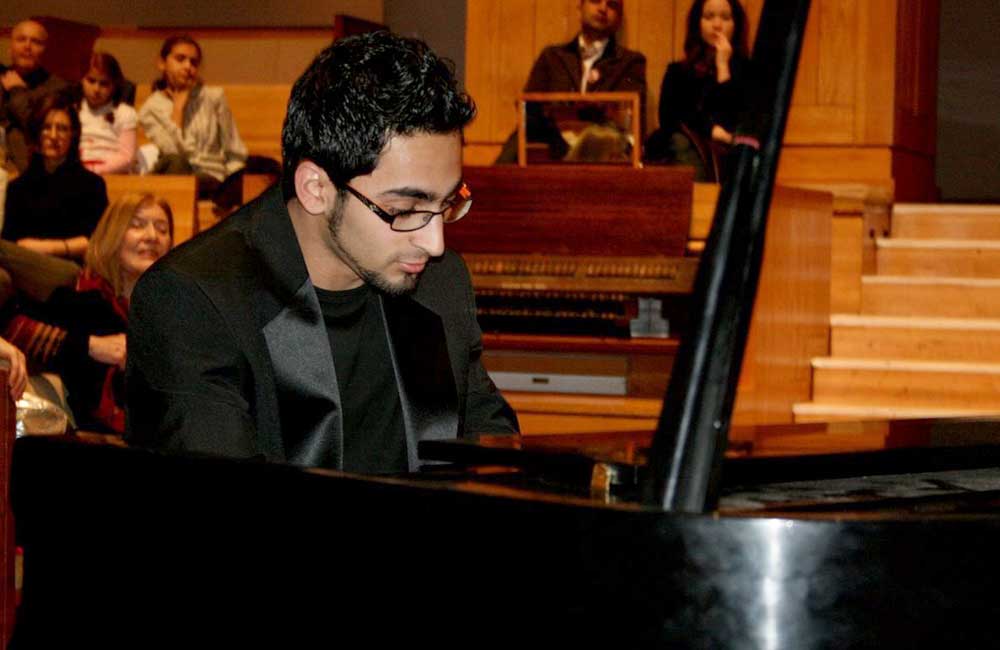
1
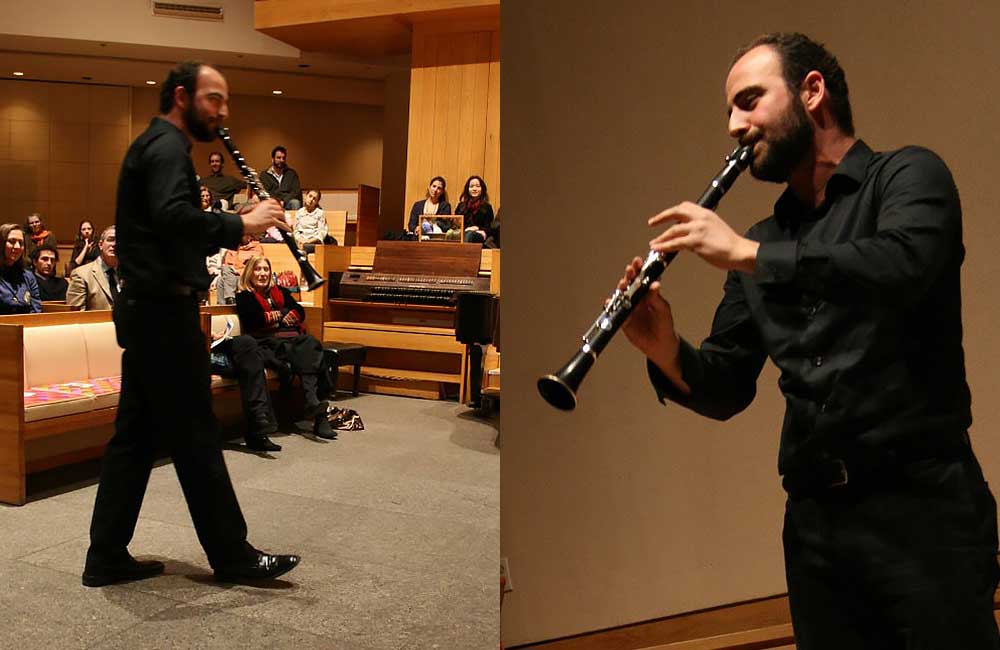
2
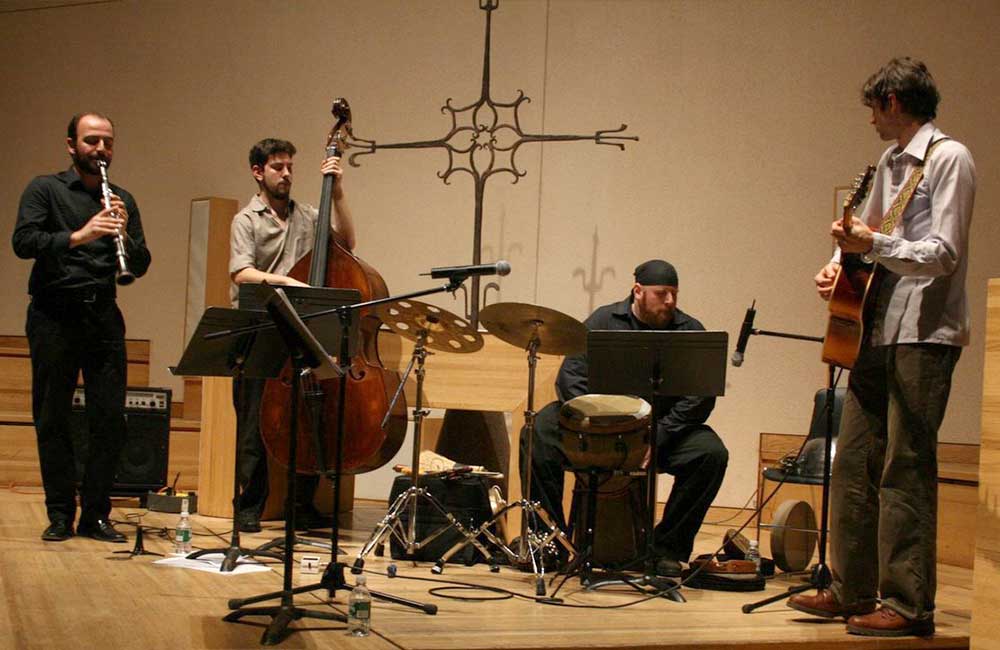
3
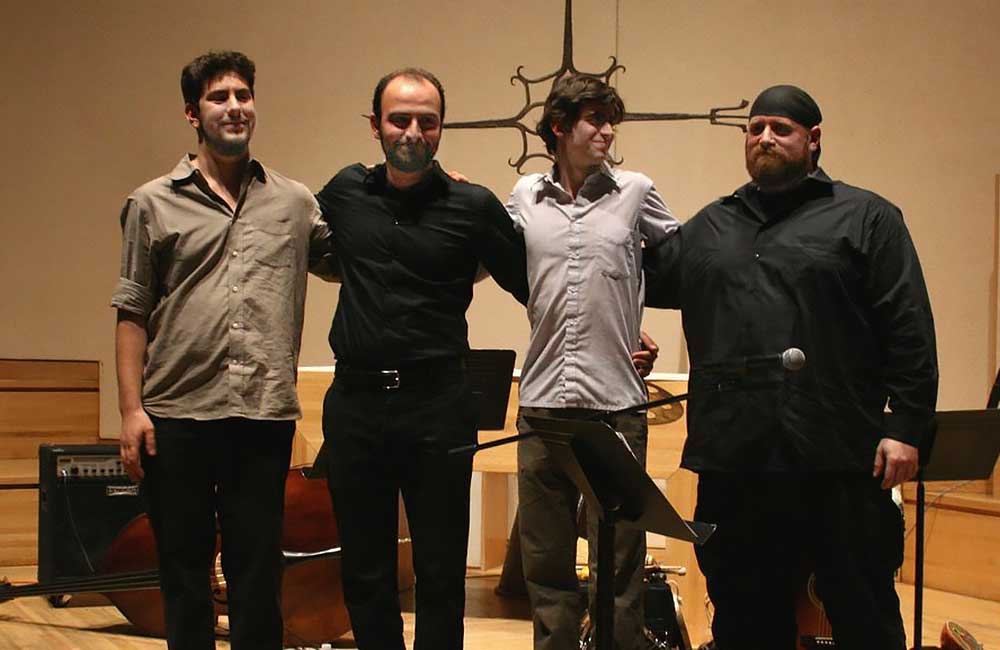
4
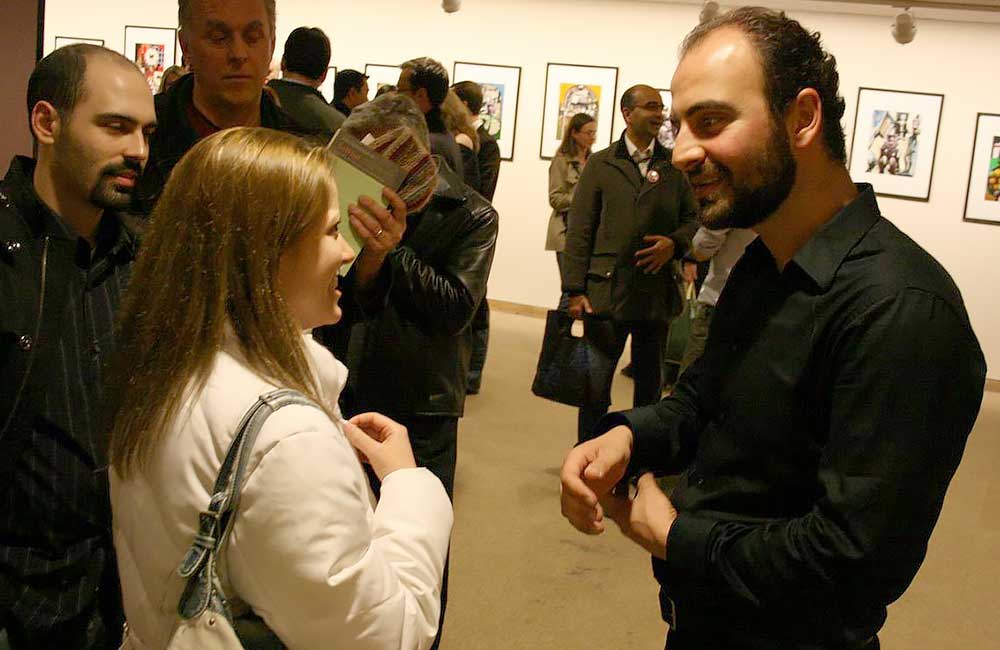
5
1) Iraqi pianist Karam Salem, performing original compositions for Musicians For Harmony’s concert at Saint Peter’s Church in New York City to benefit the Iraqi Student Project organization.
2) Syrian clarinetist Kinan Azmeh was the featured artist at M4H’s performance on March 20, 2009, part of the “Day For Peace” ceremonies hosted by Saint Peter’s Church to commemorate the 6th anniversary of the conflict in Iraq.
3) & 4) The Kinan Azmeh Quartet.
5) Reception following M4H’s Spring 2009 “Day of Peace” Concert at Saint Peter’s Church in New York City.
Photos by Doug Hostetter.
Fall Concert • September 11, 2008
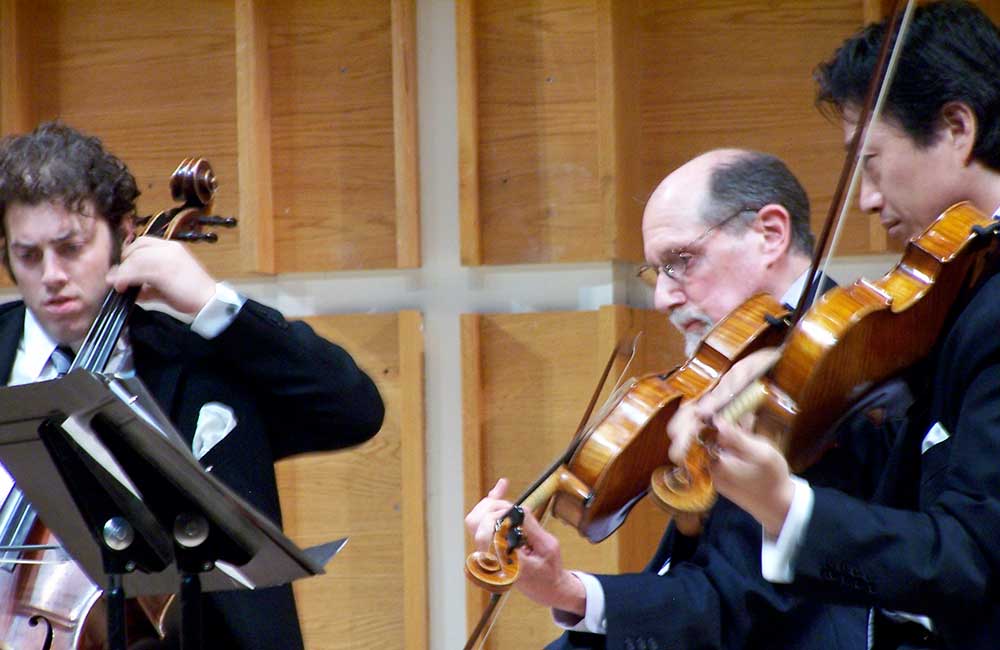
1
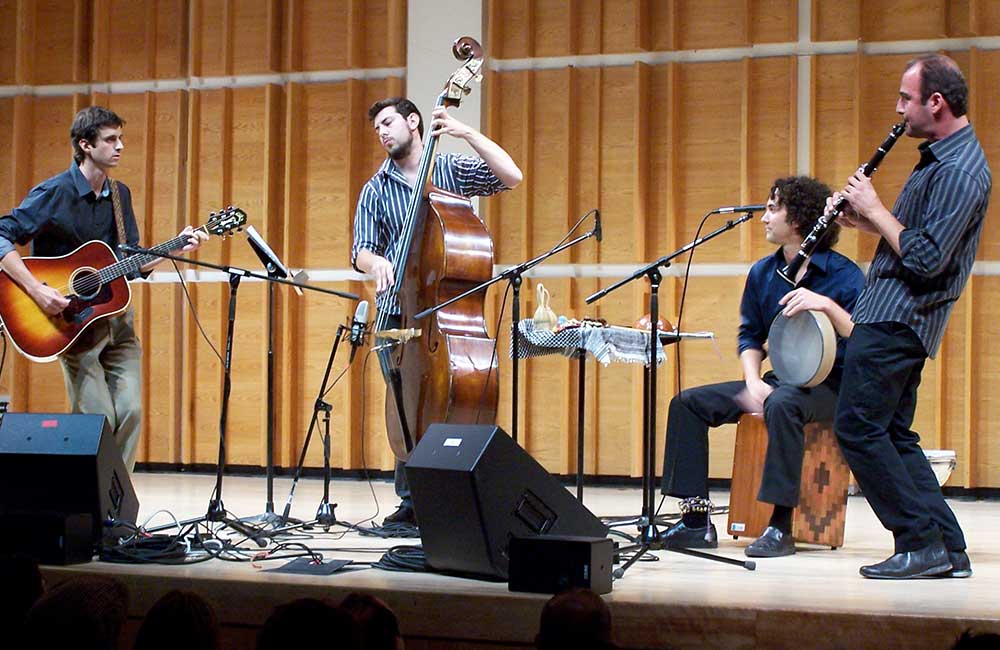
2
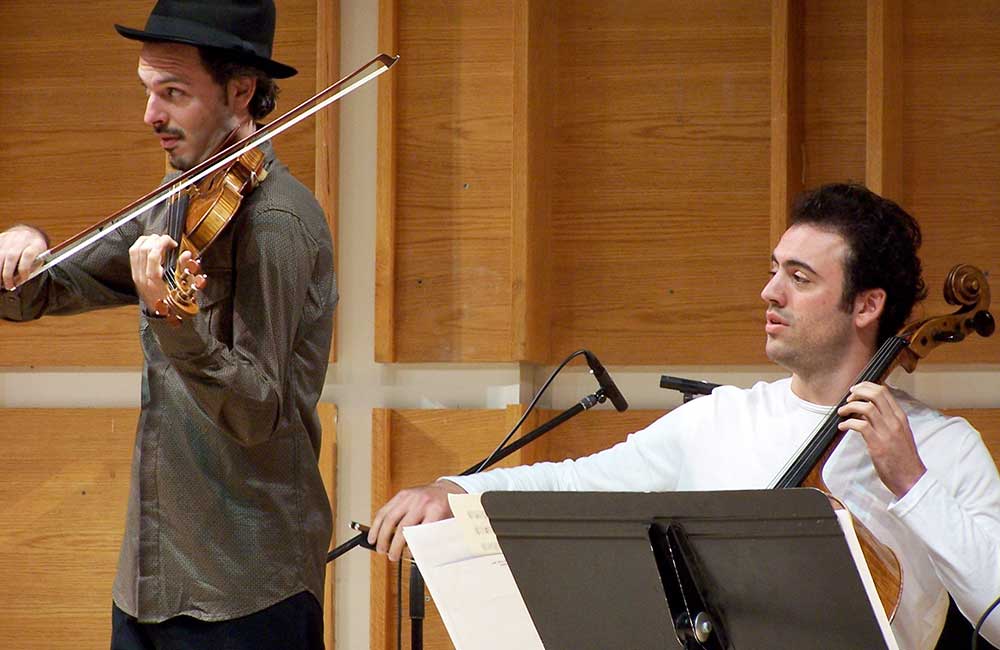
3
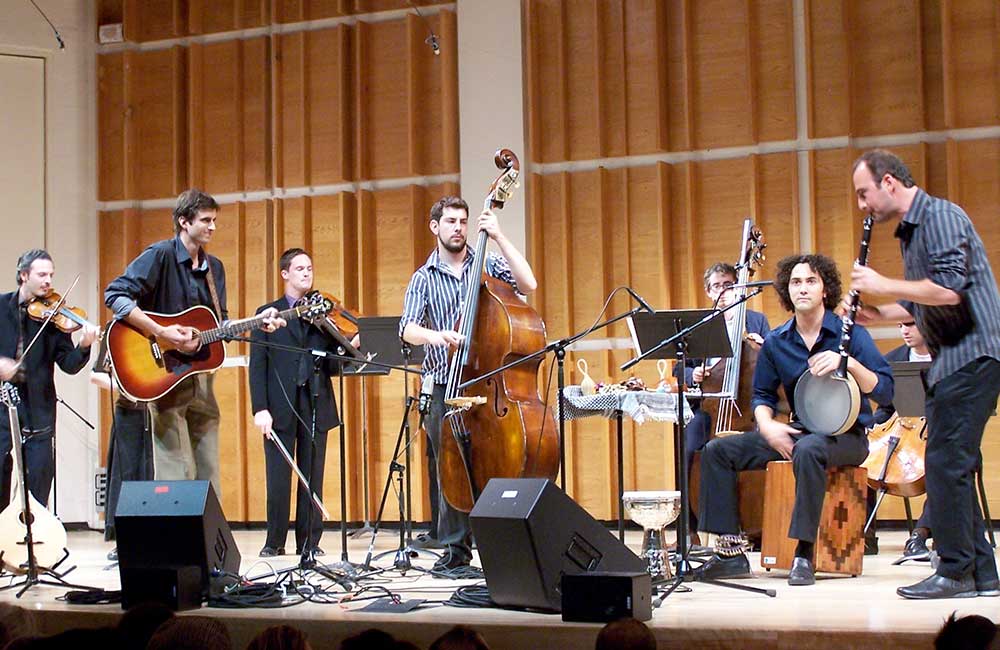
4

5
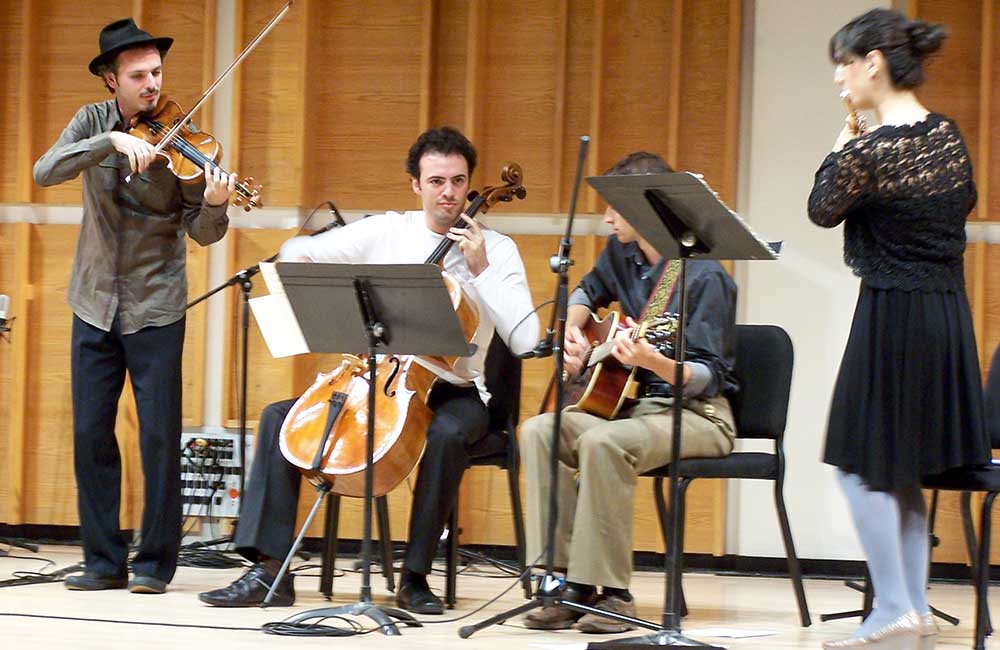
6
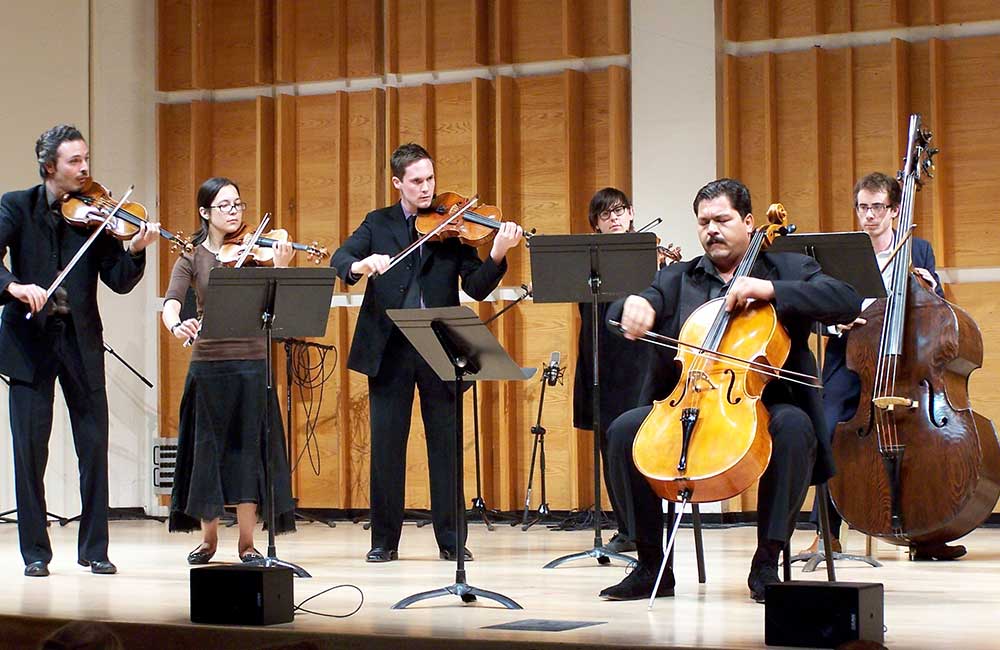
7
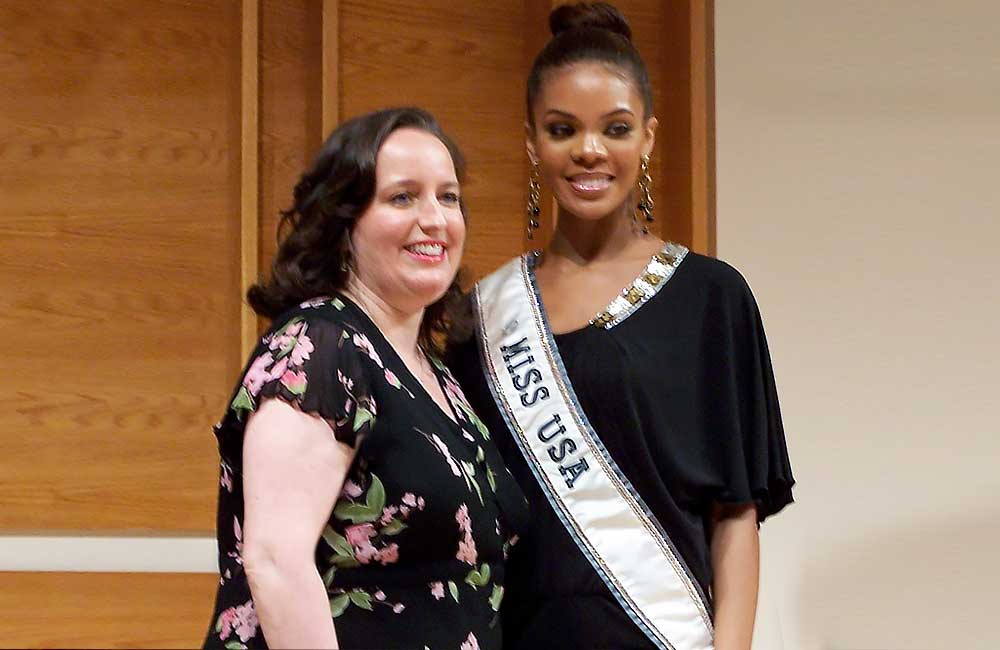
8
1) Members of the Shanghai Quartet with violist Michael Tree (center).
2) (l. to r.) Guitarist Kyle Sanna, bassist Logan Coale, percussionist John Hadfield, and clarinetist Kinan Azmeh.
3) Co-artistic directors Colin Jacobsen, violin, and Eric Jacobsen, cello.
4) Musicians of The Knights performing with Syrian clarinetist Kinan Azmeh.
5) Actors from the Compagnia de’ Colombari performing excerpts of a music-theater piece drawn from Walt Whitman’s 1855 “Song of Myself,” conceived and directed by Karin Coonrod with original music by Colin Jacobsen, Kyle Sanna and Eric Jacobsen.
6) (l. to r.) Colin and Eric Jacobsen, Kyle Sanna, and flutist Alex Sopp.
7) Iraqi cellist Karim Wasfi and The Knights in the U.S. premiere of Mohammed Amin Ezzat’s “Jenan” (Requiem) for String Orchestra.
8) Musicians For Harmony founder Allegra E. Klein with Miss USA 2008 Crystle Stewart.
Spring Benefit • May 14, 2008
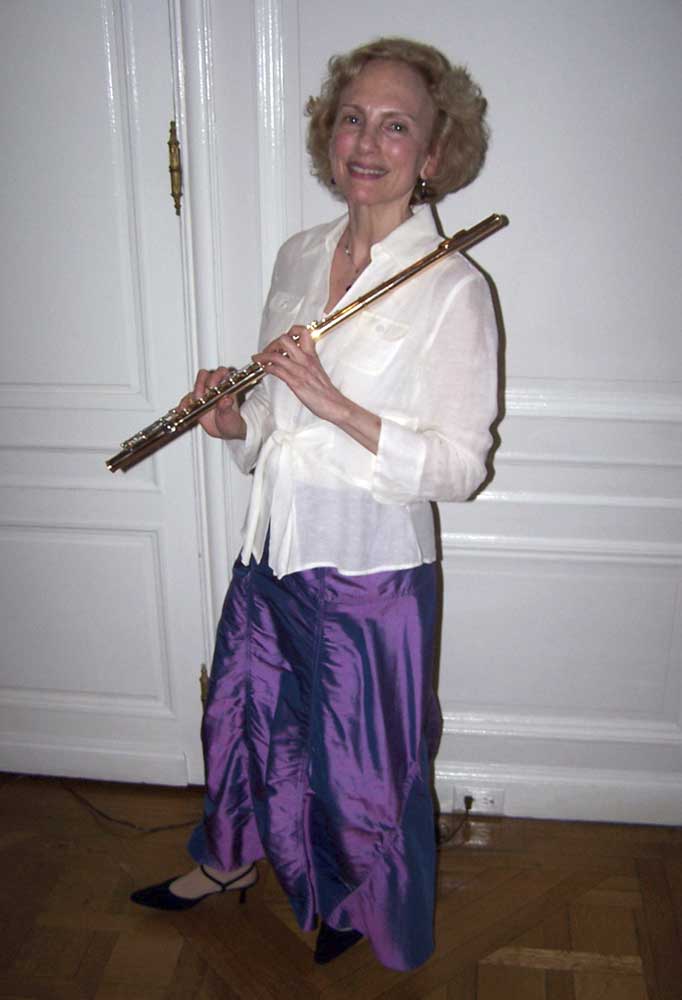
1
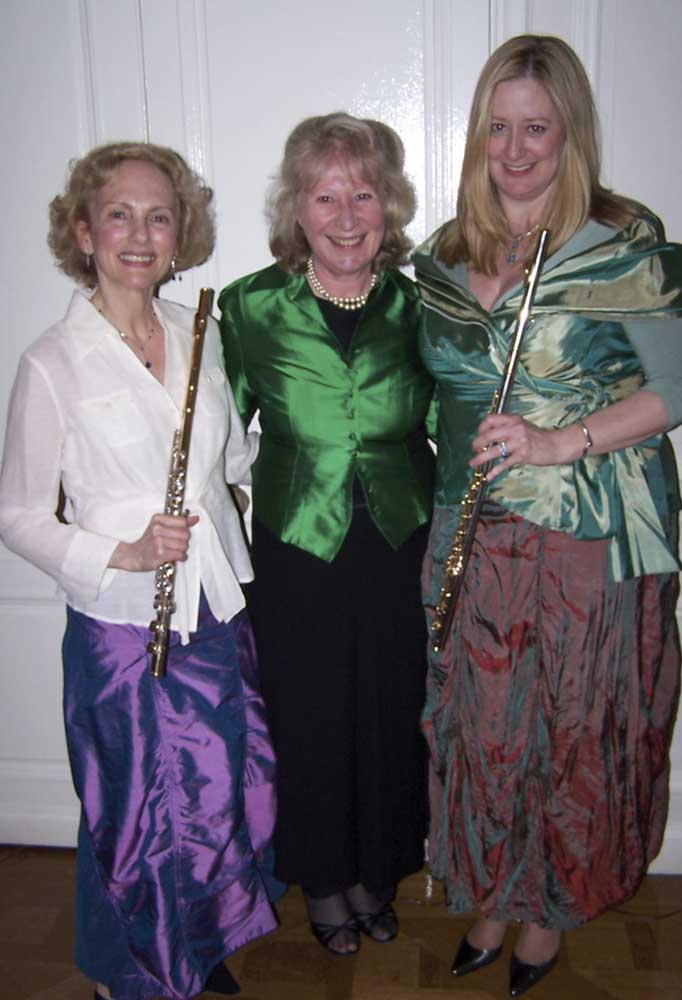
2
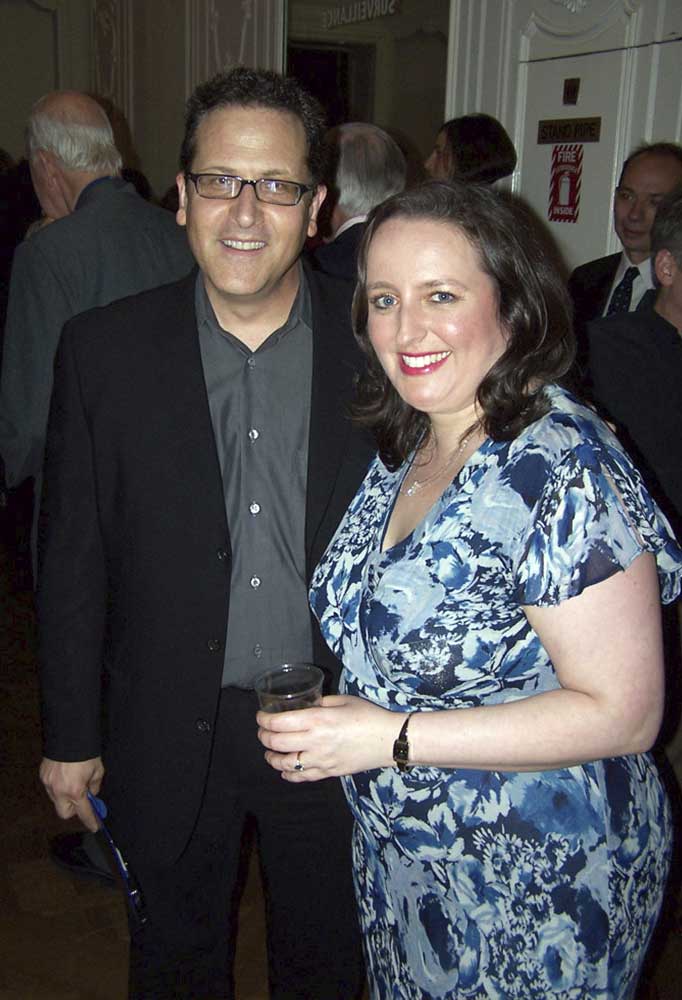
3
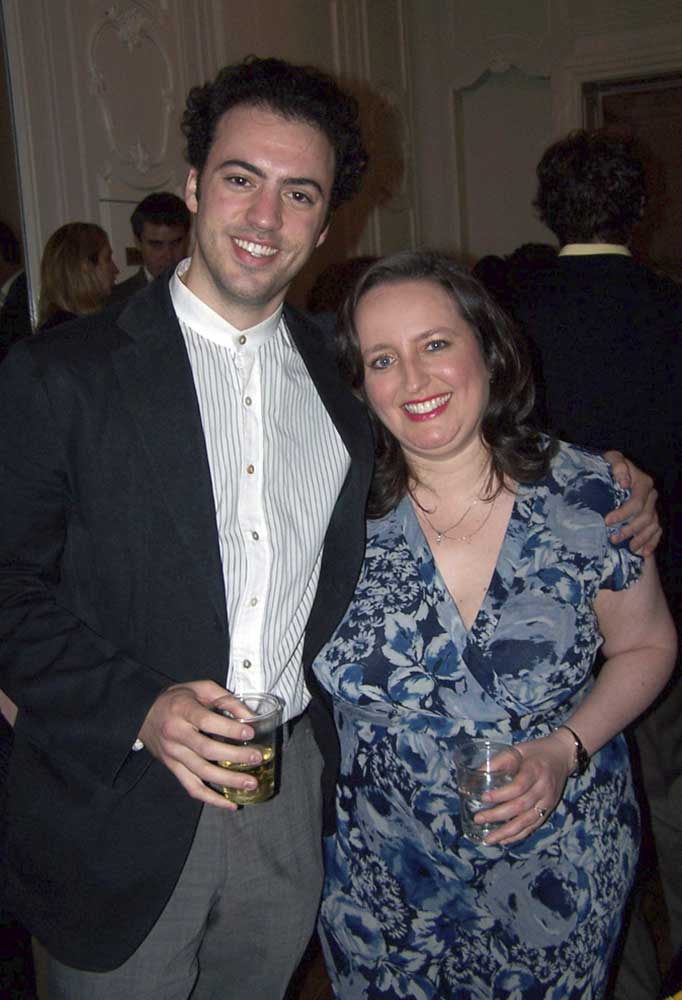
4
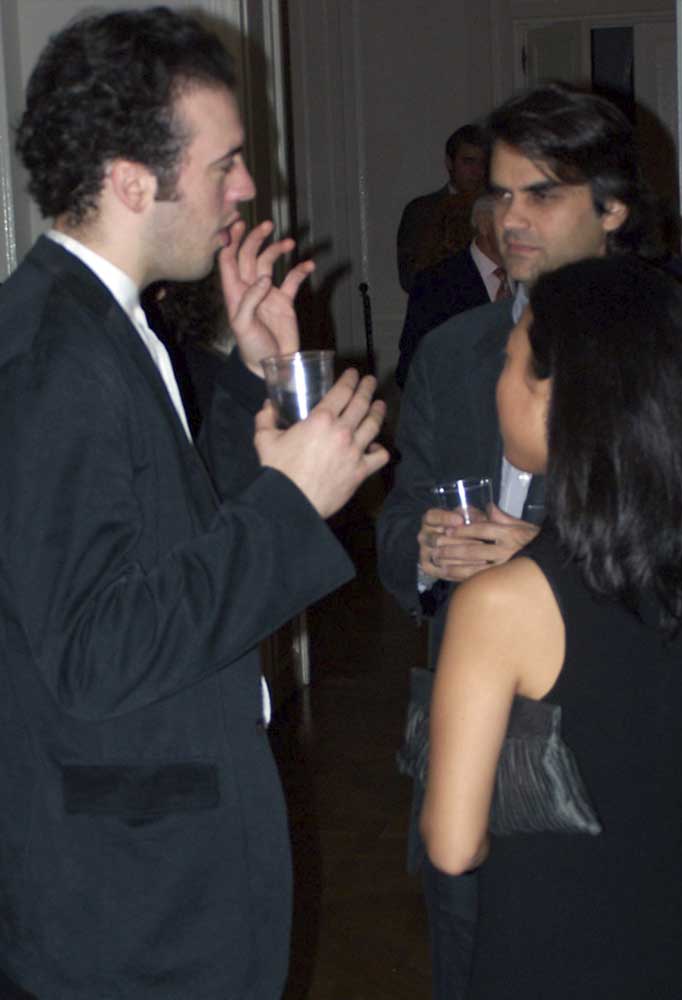
5
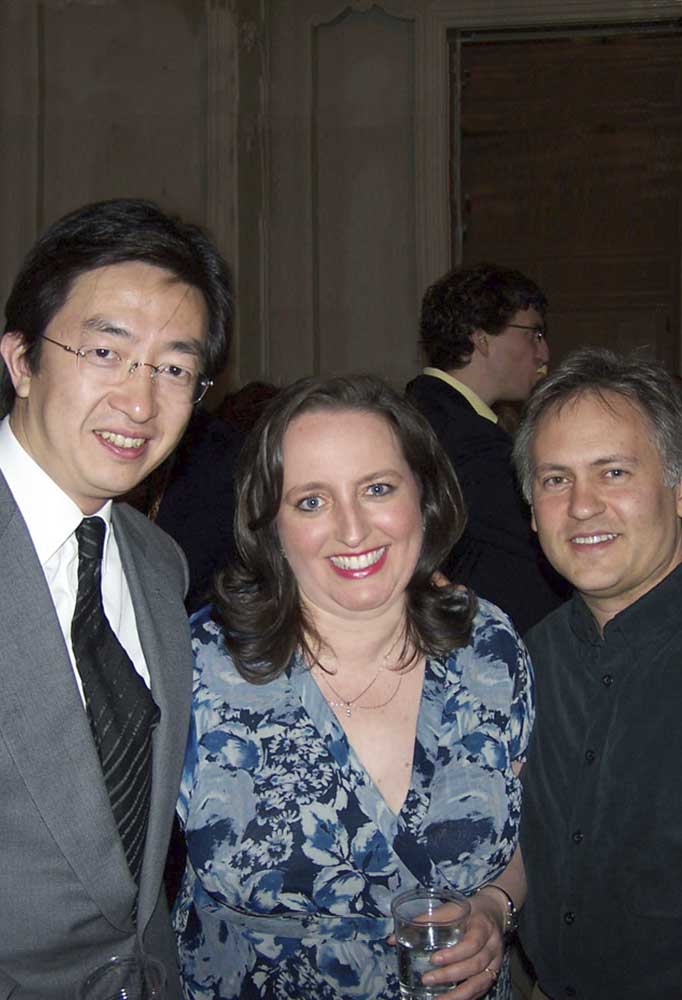
6
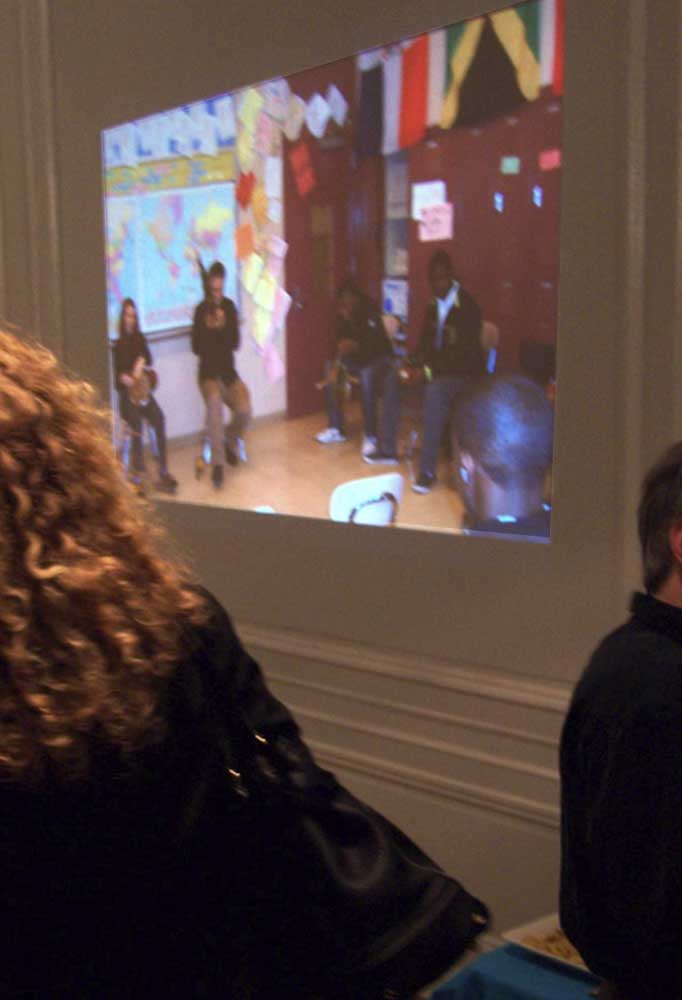
7
1) Flutist Eugenia Zukerman.
2) (l. to r.) Flutist Eugenia Zukerman, pianist Ursula Oppens and flutist Tara Helen O’Connor–featured artists.
3) Peabody Award winning host, interviewer and producer Elliott Forrest with Allegra Klein, Musicians For Harmony’s founder and Executive Director.
4) MFH’s new Co-Artistic Director Eric Jacobsen with Allegra Klein.
5) Eric Jacobsen (left) with Seth Cohen and Ayree Koh.
6) Violinists Weigang Li of the Shanghai Quartet (left) and Todd Phillipsof the Orion Quartet with Allegra Klein.
7) Photo slide show of MFH’s recent “Music of the World” workshops in Brooklyn.
Photos by Mark Rabinow.
Fall Concert • September 11, 2007
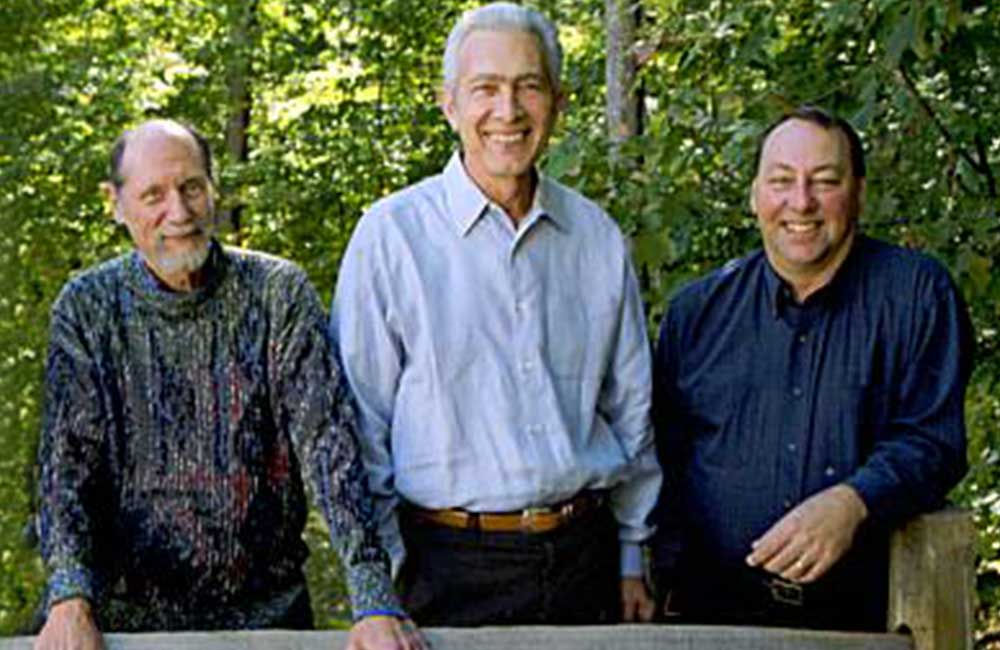
1
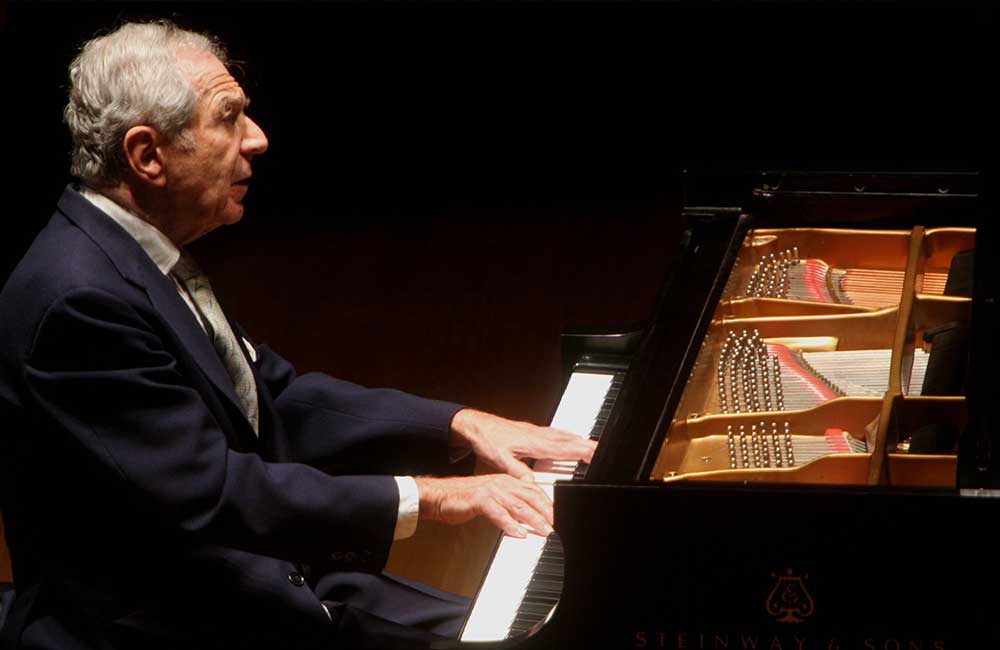
2
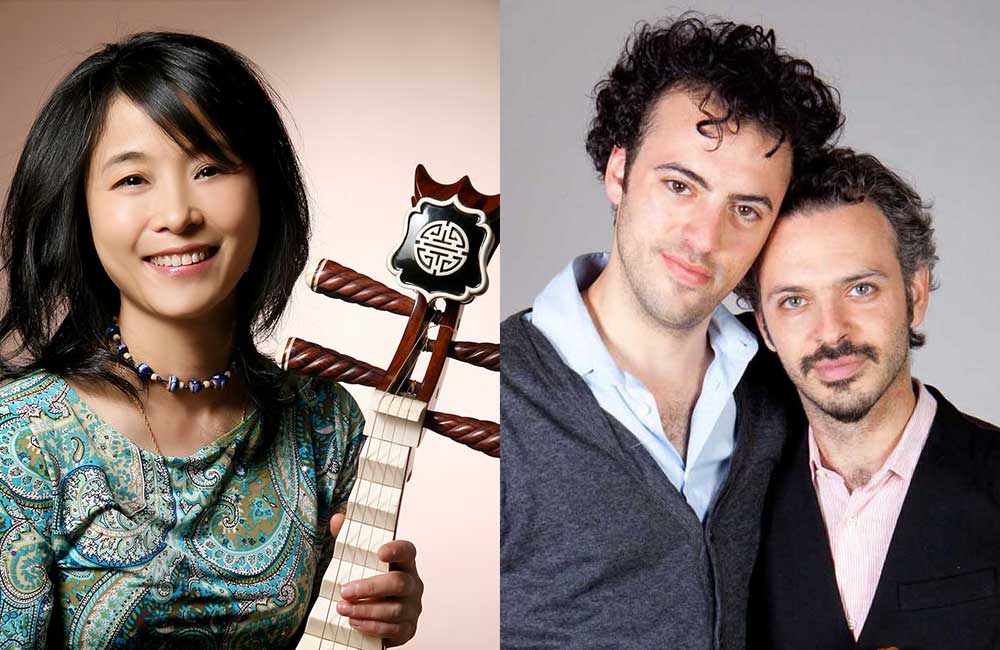
3
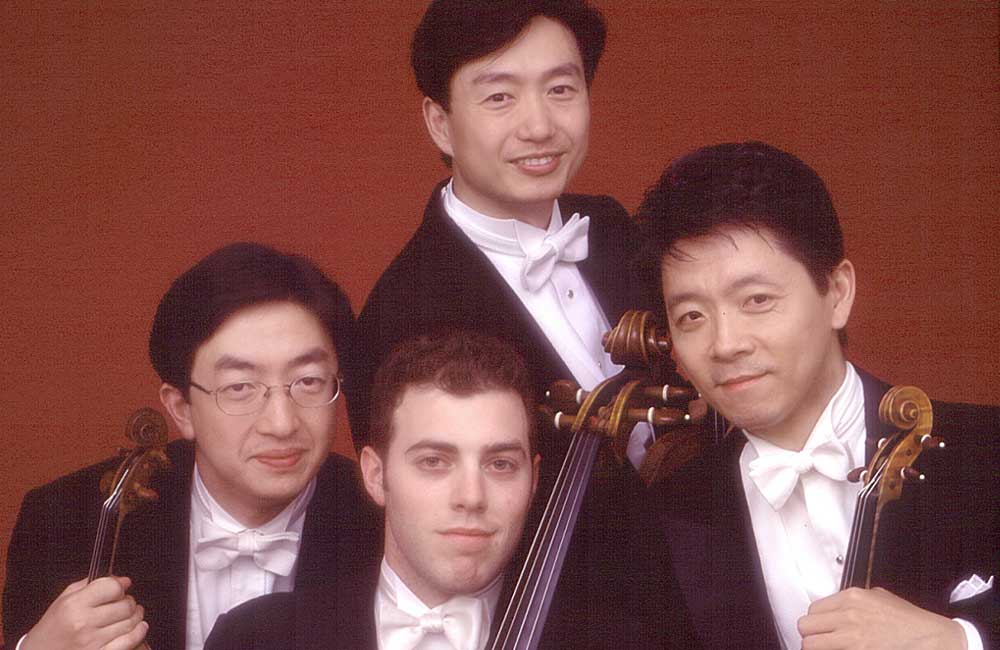
4
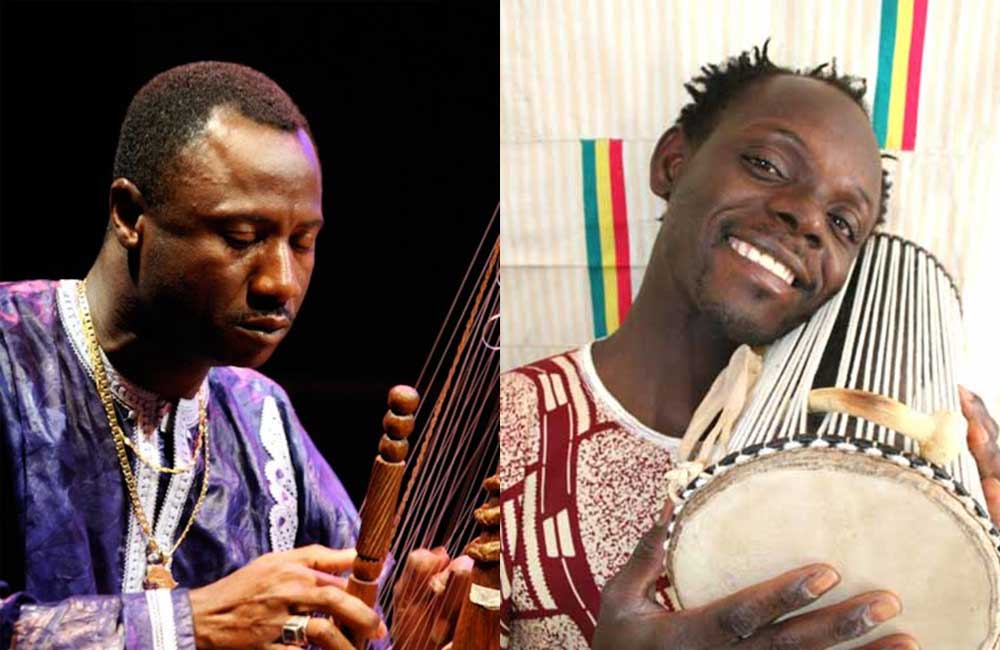
5
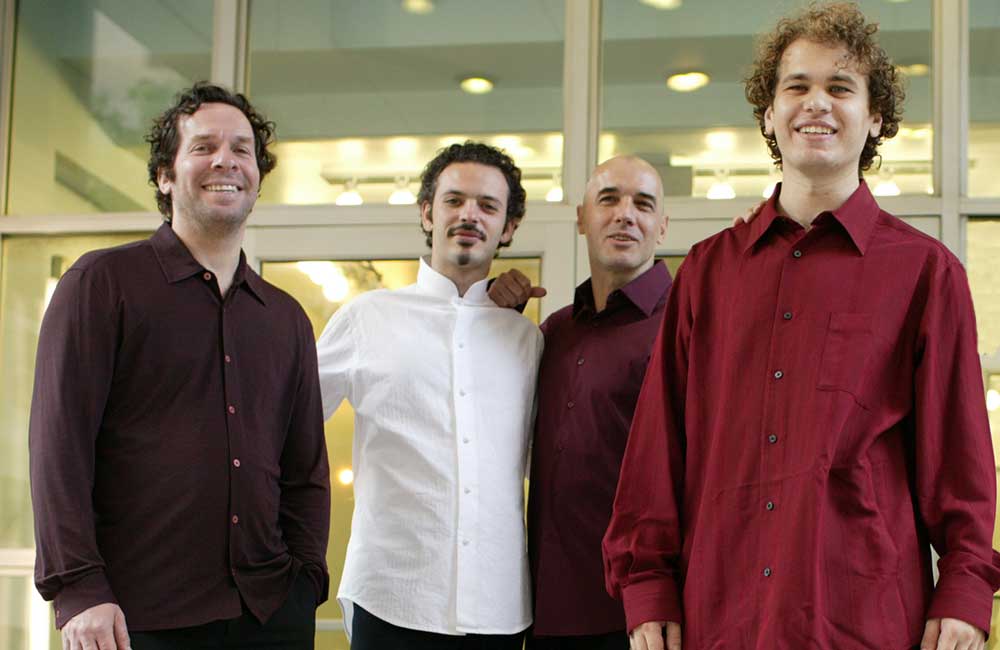
6
Our sixth annual concert was held on September 11, 2007 at Symphony Space, while Merkin Hall was being renovated.
1) Michael Tree, Arnold Steinhardt, and Peter Wiley of the Guarneri Quartet.
2) Claude Frank, who joined the Guarneri Quartet on piano.
3) Wu Ma, who joined Eric (left) and Colin Jacobsen.
4) The Shanghai Quartet.
5) Yacouba Sissoko and Baye Kouyate, who joined Musique Sans Frontières.
6) Benny Koonyevsky, Colin Jacobsen, Patrick Derivaz, and Rubin Kodheli of Musique Sans Frontières.
Iraqi Summer Arts Academy • 2007
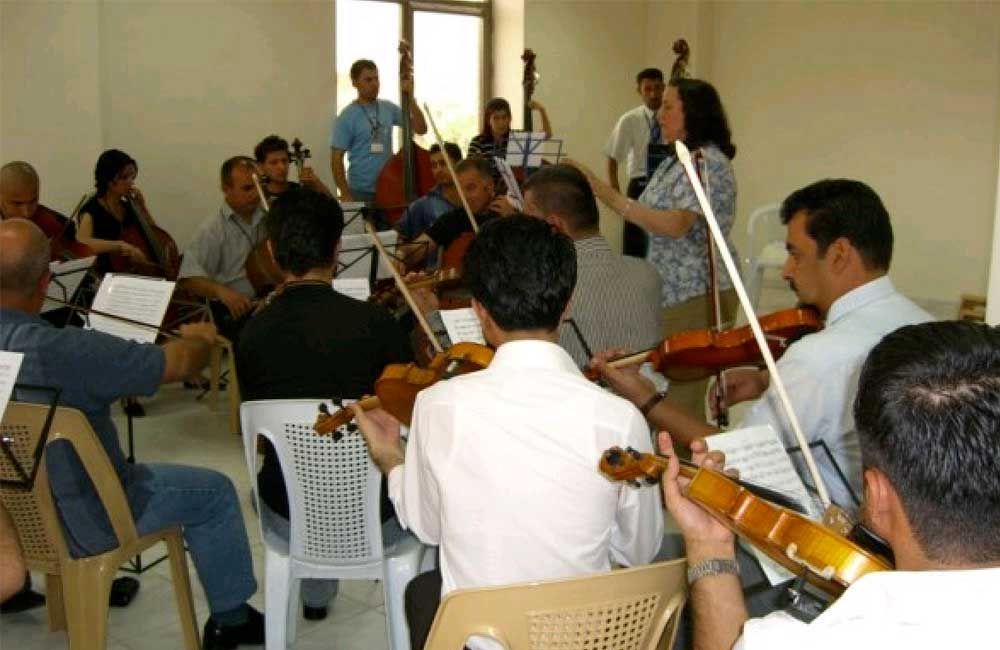
1
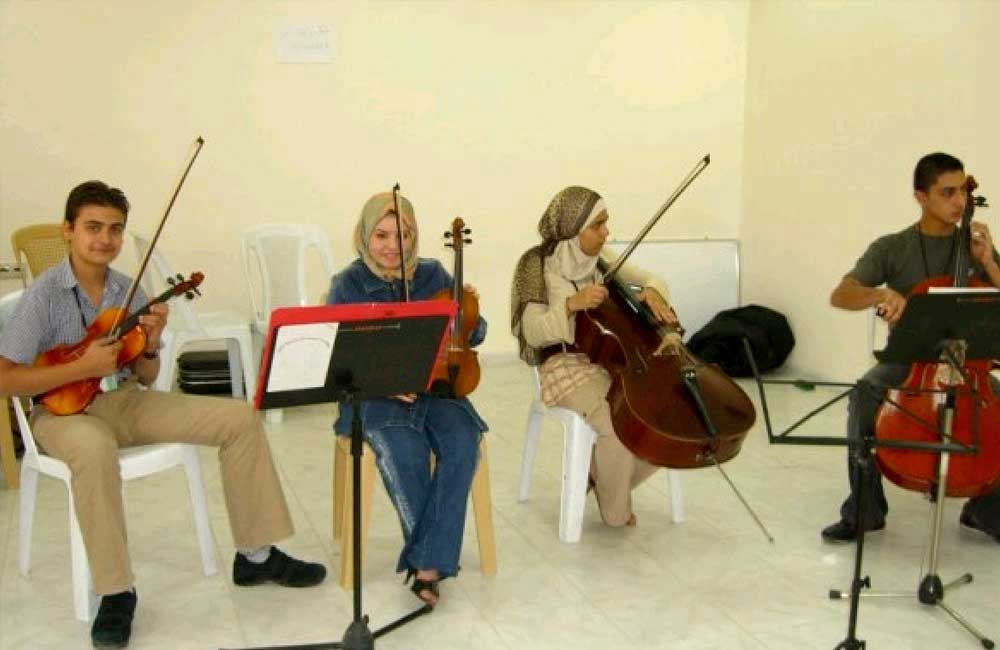
2
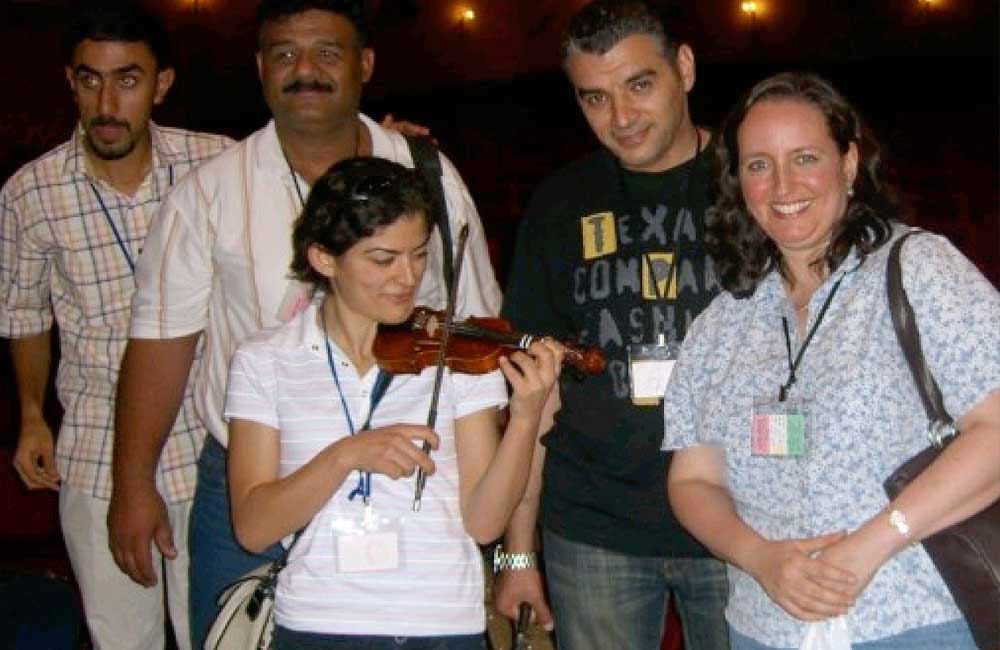
3
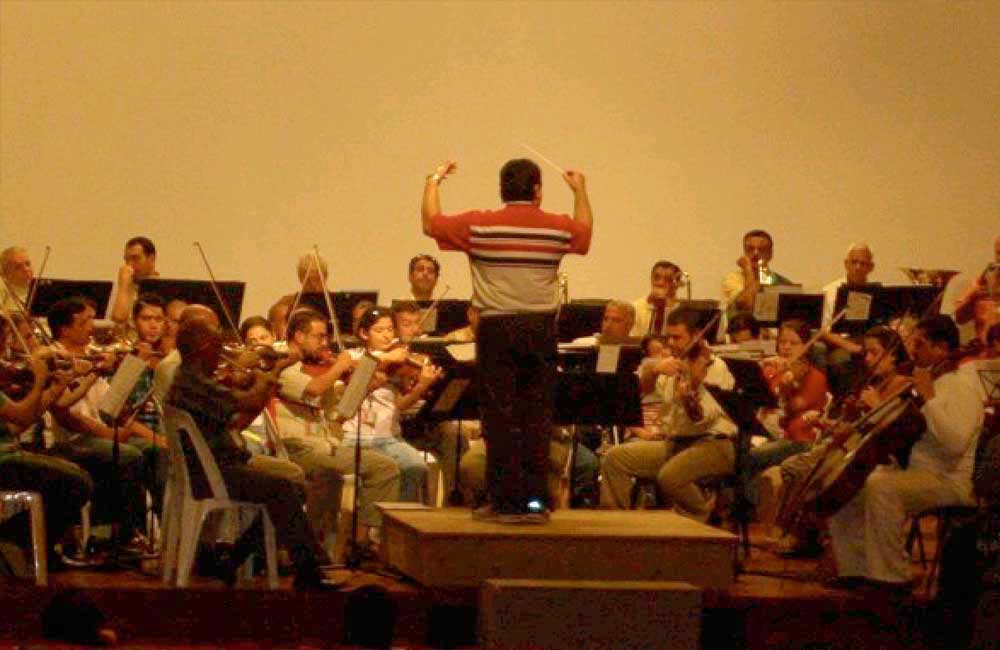
4

5
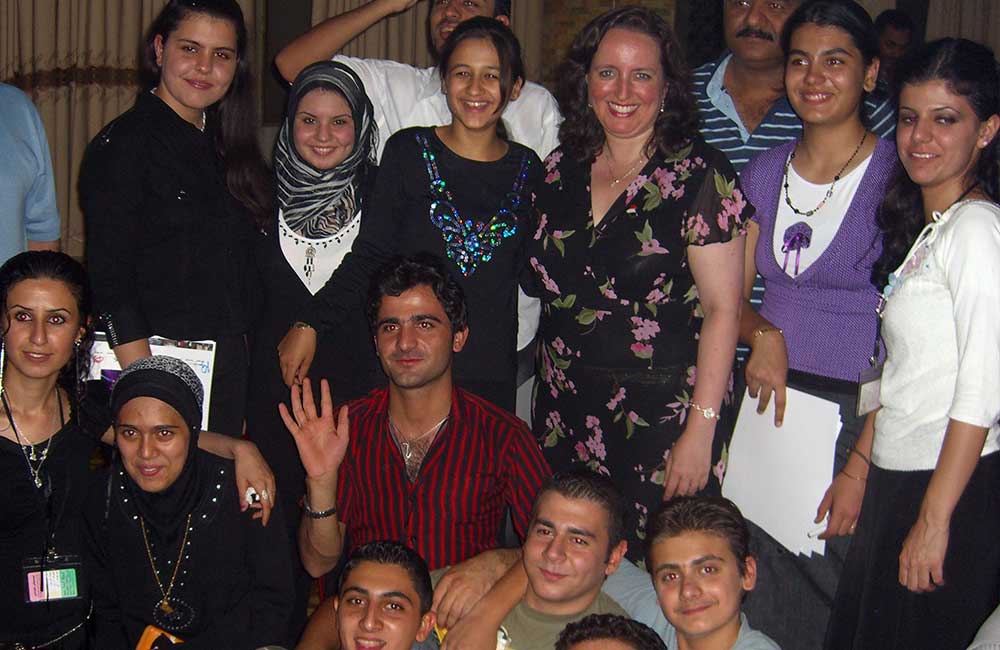
6
1) Allegra Klein works with the Erbil String Orchestra.
2) A string section with members of the Iraqi Unity Youth Orchestra.
3) Donating a 1/16-size violin to Annie Melconian, for her work with children in Baghdad.
4) The Iraqi National Unity Orchestra, led by Mohammed Amin Ezzat (of the Iraqi National Symphony Orchestra).
5) l. to r.: Allegra Klein, Demetrius Fuller (conductor), Kim DuBois (Cultural Attache from Baghdad Embassy), Patricia Butenis (Deputy Ambassador to Iraq), and Tania Azia (Baghdad Embassy).
6) Allegra Klein surrounded by her newest friends – the students of the Iraqi Youth Orchestra.
Letter From Erbil • 2007
In November 2003, MFH founder Allegra Klein attracted international attention by traveling to Baghdad to present much needed funds and musical instruments to the Iraqi National Symphony Orchestra. This July, Klein returned to Iraq to participate in a landmark event — The Iraq Summer Performing and Visual Arts Academy. The Academy — the first project of its kind in the history of Iraq — delivered an American educational experience to nearly 300 of the country’s aspiring performers, including The Music and Ballet School of Baghdad and The IraqiNational Symphony Orchestra.
Letter from Erbil, Iraq
by Allegra Klein
July 24, 2007
It’s over. Flying home from Iraq to New York, high above the Atlantic with the sparkling blue water peeking through the clouds, I am filled with emotion. The thrill of these last 10 days – perhaps the most rewarding and gratifying experience of my life – is tempered only by the sadness of leaving it all behind.
Witnessing the progress and joy of over 300 Iraqi musicians and dancers during the first-ever National Performing Arts Academy in Iraq has been a priceless privilege and inspiration. To be called “Teacher” (in three languages, no less – Kurdish, Arabic, and English) brings back memories of when I taught violin full-time, and of that special satisfaction and sense of accomplishment that surpasses all other types of professional endeavors.
And this was the best kind of teaching, to open hearts and curious minds, to people who are hungering and thirsting for more. It was the first time that Americans came to their part of the world to engage them in serious musical and dance studies. Artists and students from all over Iraq – Baghdad, Erbil, Rania, Dohuk, Suleymaniya – were filled with wonder and anticipation for this opportunity, and seemed to revel in the brief respite from the harsh conditions to which they’ve grown accustomed.
Organized by John Ferguson of American Voices in conjunction with the U.S. Department of State, the Kurdish Ministry of Culture, and several performing arts groups in Iraq, this historic summer academy took place in the relatively safe Kurdish city of Erbil in northern Iraq from July 13 – 23, 2007. Participating teachers included Demetrius Fuller and David Handel (conductors), Marc Thayer and myself (strings), Eugene Aitken and Werner Englert (jazz/winds/brass), Michael Parks Masterson and Quae Simpson (dance), and Carole McCann (musical theater).
The Erbil Players
Over the course of just 10 days, I watched the Erbil String Orchestra – a motley group of rudimentary and intermediate-level string players, who have been without a leader and “on strike” for years now – learn Bach’s Air [from the Suite in D Major] from start to finish and perform it in front of a live audience. The astonishment and delight on their faces that first day, when they discovered they could actually play the opening four measures after we spent an hour and a half putting it together, was an early clue that we were making a real difference with our Iraqi friends. This is the type of “shock and awe” we should aim for all the time…
And it just got better from there, as the Erbil violinists started to replace bad strings with the new ones we’d brought, the cellists figured out how to produce makeshift “rock stops” with their belts to keep their endpins from slipping, and all the musicians gradually reacquainted themselves with their instruments. Leaders began to emerge within each section, and even their principal cellist – an especially gifted musician, who was skeptical at first and only sporadically showed up for rehearsals – eventually took ownership of his position within the orchestra and became a revered teacher himself.
The whole orchestra learned how to set up correctly, how to tune without their electronic tuner (which they’d been worshipping as if it were the “goddess of pitch”), and how to conduct themselves during a concert. By the time of our final performance in front of hundreds of eager listeners, they had become a seasoned and unified group who took great pride in their ability and accomplishments.
Youth Orchestra – in Iraq?
As for my little “Iraqi Unity Youth Orchestra,” I could not have asked for a sweeter or more willing group of youngsters. This 20-piece ensemble was comprised mainly of the most gifted students from the Music and Ballet School in Baghdad, but also included some string players from Erbil and Suley (our nickname for “Suleymaniya”). They were so excited to be there, and many were quite talented. I fell in love with all of them, and they have become my pride and joy.
The students from Baghdad came prepared with a piece called “Variations on an Iraqi Folk Tune,” arranged by a former M&B School teacher named Agnes Bashir. This was a wonderful opportunity for me to learn more about their native music, while coaching them on the finer points of intonation, phrasing, and ensemble playing. I also learned a lot from another of their former teachers, a violinist named Majid Al-Ghazali whom I had met during my first trip to Baghdad in November 2003, and who came all the way from Amman, Jordan, where he now lives, to help the young string players.
After mastering the folk tune, we tackled an arrangement of Beethoven’s “Ode to Joy” from his Symphony No. 9 and even a medley of Leroy Anderson songs – all enthusiastically embraced by these eager young musicians. At the final concert, they performed like a professional orchestra, with the shy young principal violinist, in her traditional Muslim hijab, proudly making her début as the concertmistress of the group. It was a moment I will cherish forever.
Suzuki training, Iraqi-style
In addition to working with these talented but already advanced students, I wanted to introduce the musicians gathered in Erbil to a teaching method for “baby” beginners. The Suzuki violin method is a standardized training system which enables children of all abilities and backgrounds to begin musical studies as early as age three. Formulated in Japan and now widely used in the U.S. and Europe, the Suzuki method revolutionized classical violin teaching, and I hoped that Iraq would become the first country in the Arab world to take hold of this amazing and highly effective training program for small children.
John, our fearless leader, suggested I give a lecture on the topic to the string teachers. I had no idea what kind of reception to expect, but with my “props” (a tiny 1/16-size violin, some teaching books, and audio CDs), a dual Arabic/Kurdish translator, and just a few sketchy notes, we were able to generate quite a bit of excitement. Hundreds of musicians attended the lecture, and dozens rushed the stage afterward hoping to become one of the first teachers in the program. In fact, the frenzy that ensued over who should sign up for training and who should receive the limited quantities of Suzuki materials that I’d brought plagued me for the rest of the week, and was only heightened after we screened the Suzuki film, Nurtured by Love, a couple of days later.
While it was gratifying to witness the enormous excitement and enthusiasm for the Suzuki training – from all quarters, including Baghdad, Erbil, Suley, Rania, etc. – I was also concerned that many did not truly understand the long-term commitment needed to master this teaching method (it took me nearly two years!). They all wanted to get started right away, perhaps because of the ephemeral nature of their fragile existence in a war zone. Although we were not prepared for this, it was quite heartening to see such a tremendous response. I hope we are able to follow through with proper teacher training and more materials in the coming months.
Tangible results
The culminating concerts during the last two days of the Performing Arts Academy were a testament to the dedication and hard work of all the participants and teachers during the eight days prior. How incredible it was to see the fruit of all those 12-hour days, and know that the participants had such a splendid showcase for their efforts! The first performance featured jazz and folk musicians and several types of dance – ballet, folk, children’s theater, and even hip hop. The second was entirely orchestral, featuring the Iraqi National Symphony Orchestra, the Erbil and Suley String Orchestras, the Iraqi National Youth Orchestra, and the Iraqi National Unity Orchestra.
This last group was a huge symphony orchestra made up of all the other orchestras combined – a whopping total of 130 musicians from all over Iraq, plus myself and violinist Marc Thayer, the other string teacher from St. Louis, altogether on one huge stage. All four conductors – Demetrius Fuller (Florida), David Handel (Bolivia), Mohammed Amin Ezzat (Baghdad), and Najat Amin (Suleymaniya) – took turns conducting. This was a monumental experience, representing the unity and harmony of many religious and ethnic entities – Shi’a and Sunni, Christian and Muslim, Kurdish and Arabic, young and old – all coming together in one grand finale for peace. It was a sight to behold.
The flurry of press and political dignitaries was no less impressive. Reporters from at least a dozen Arab and Kurdish T.V. and radio stations were there, as were the Kurdish Minister of Culture and the U.S. Deputy Ambassador to Iraq, Patricia Butenis, who came all the way from Baghdad to attend the final concert. She seemed interested in my idea to bring the Iraqi National Unity Orchestra for a tour of the U.S. next year, and I hope to continue this dialogue with her and others from the States. But it was Carole McCann, our musical theater specialist from Houston who worked with the youngest children, who best summarized our experiences to the visiting dignitaries: “Children everywhere need love, and we should give it to them because they put the smiles on our faces.”
The “rock star” treatment our staff received was another surprise aspect of our time in Erbil. I have never posed for so many pictures nor signed so many autographs in my life. Should one of the teachers slow down long enough in one place, someone would rush up with a camera and ask to have a picture taken with them. And as soon as others saw this, a line would form for them to do the same. Many of our Iraqi friends also gave us gifts at the end, in spite of the hardship of their lives – another indication of their generous and selfless natures. It was hard to believe they had the means and presence of mind to do this, but it meant a lot to us.
Not all was a bed of roses for us in Erbil – there were several challenges and hardships along the way. We faced daily 40-minute commutes, complete with checkpoints, in an un-airconditioned van to and from our “fortified” hotel on the outskirts of the city. There were also regular searches of person and property, the ever-present Kurdish peshmerga (militia) with their AK-47’s, brutal heat (upwards of 120 degrees Fahrenheit), electricity and air conditioning that kept coming and going, inadequate local staff to help with lighting, stage setups, and translating, erratic scheduling on “Iraqi time” (i.e., constantly late), and a lack of proper facilities.
And in spite of bringing more than 35 boxes of music, instruments, and supplies donated by generous friends back in the U.S., we still fell woefully short of the tremendous need of the Iraqi musicians and dancers. They crave so much more, especially good teachers and orchestral conductors who are available year-round for high-quality musical and dance training. Several of the youngsters also deserve a chance to go to Europe or the U.S. for serious professional studies.
What’s more, I worry about what will happen to them now – will the Erbil orchestra move ahead with their work or go back on strike? Will a conductor come forward to lead them, or will they revert back to their “anarchic” state? What will happen to the lovely children of Baghdad? Will they get the education they need, and will we be able to make good on our promise to train the Iraqi teachers in the Suzuki method?
New friends
Our time with them is over – for now, at least – but it’s also just the beginning. “Insha’allah” (let us hope) we will have the opportunity to return there next summer, and maybe even sooner, so that these talented and kind-hearted souls know we really do care and will not forget them. And in the meantime, we will stay in touch with one another and keep the promise and hope of music alive between our two worlds.
…………………………………
Postscript. Upon returning home, I received this email from Zuhal Sultan, the 16-year-old pianist in the Iraqi youth orchestra:
“Just wanted to say hi and to tell you that me and my friends are back safely to Baghdad (thank God) only to find that there was an explosion near my house and my room was full of shattered glass from the broken windows, but thankfully no one was home when it happened so no one got hurt…
All of us miss u here sooo much from the day we arrived to Baghdad, and I just wanted to say that those few days that we spent with u were truly the best of our lives and we won’t forget this experience as long as we live … not only becuz we learned alot from you but we had a good time doing that.”
Spring Benefit • March 28, 2007
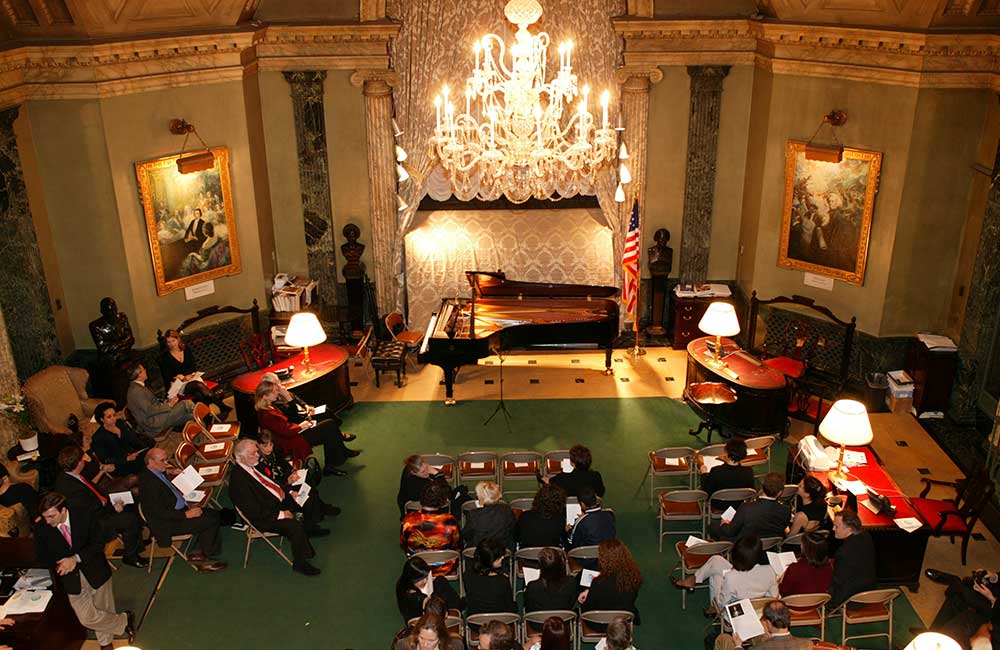
1
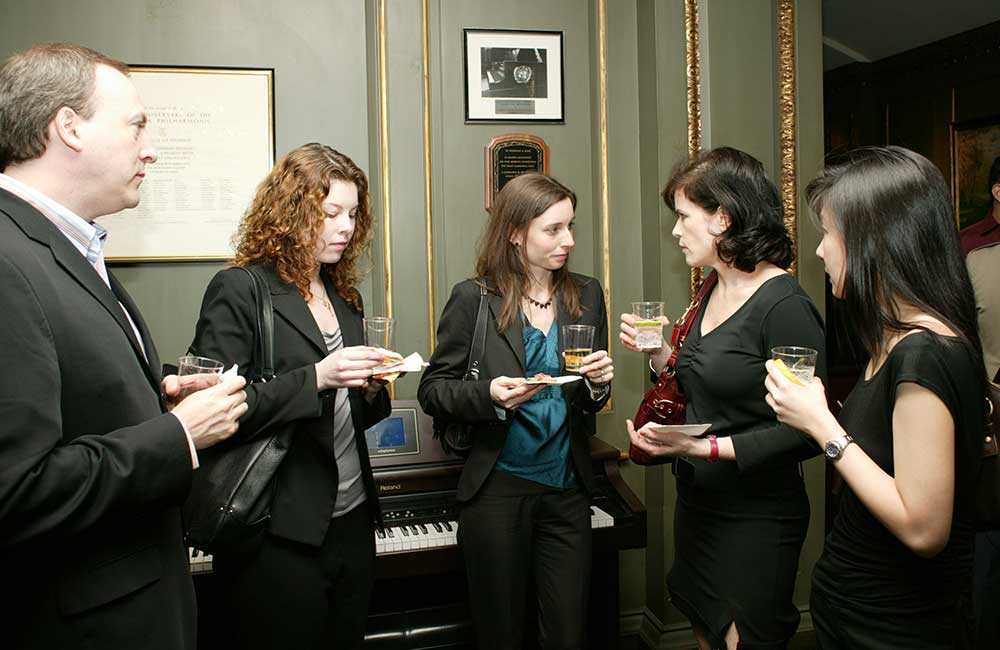
2
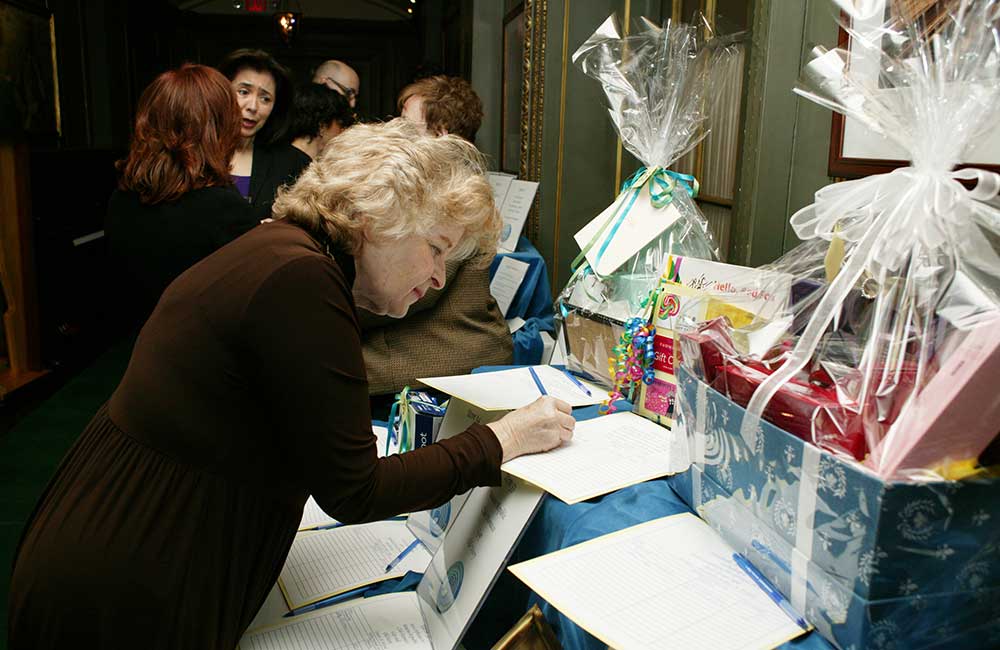
3
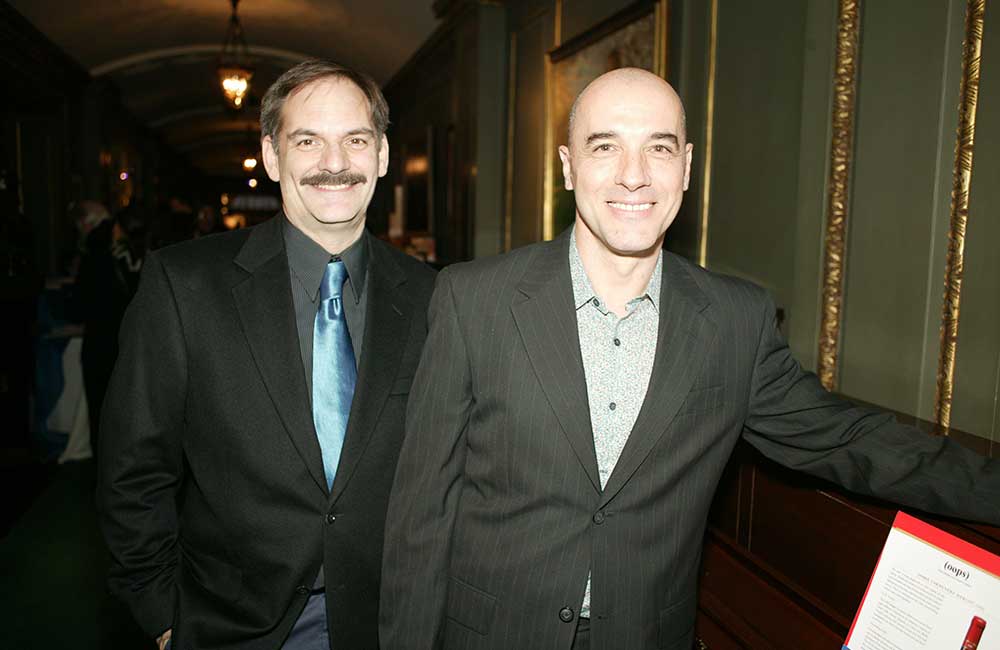
4
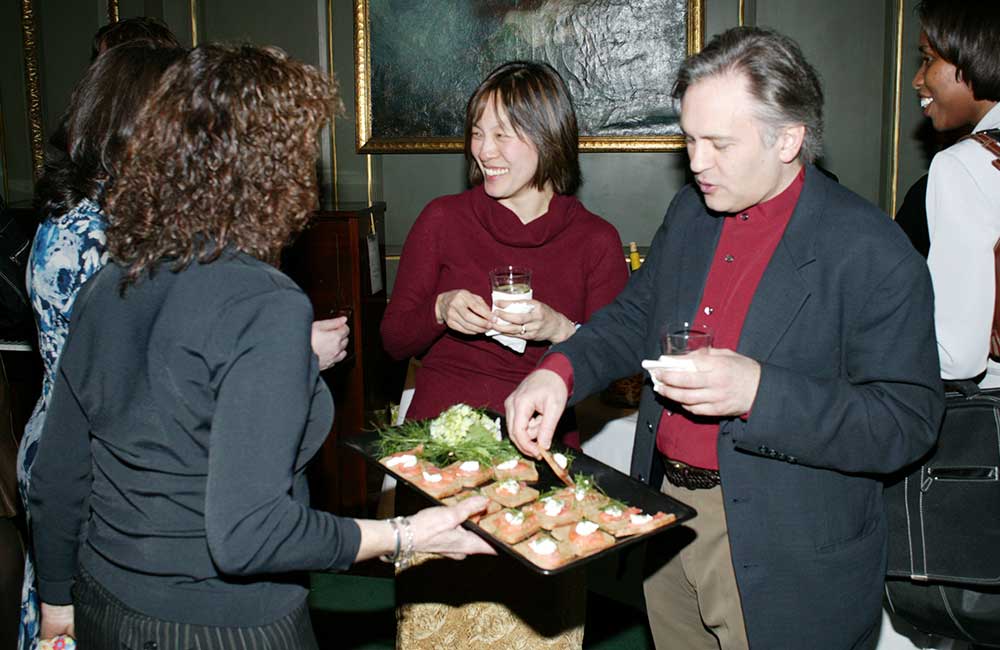
5
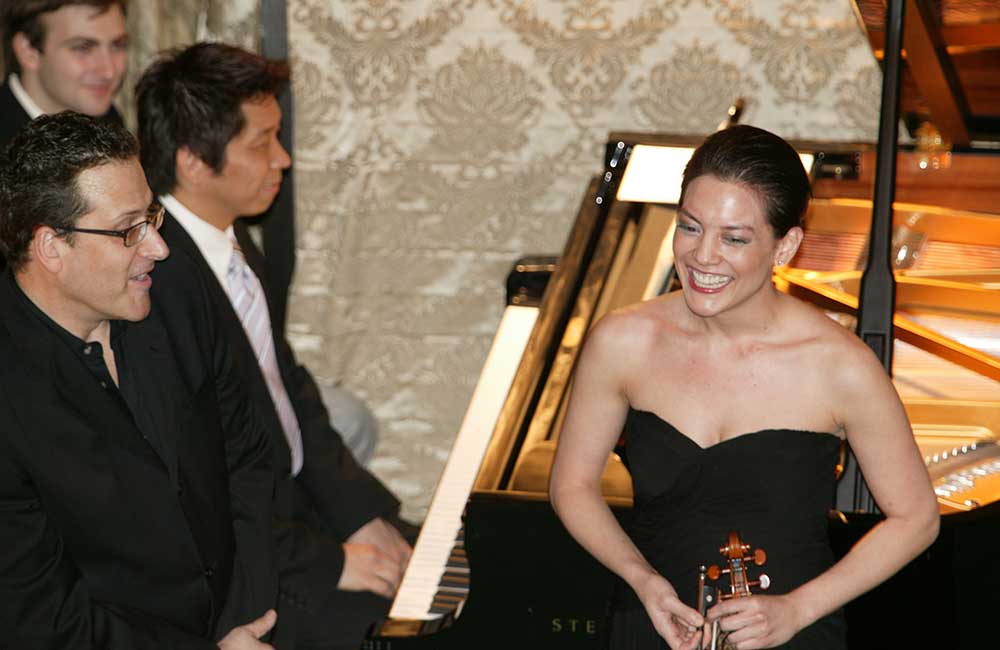
6
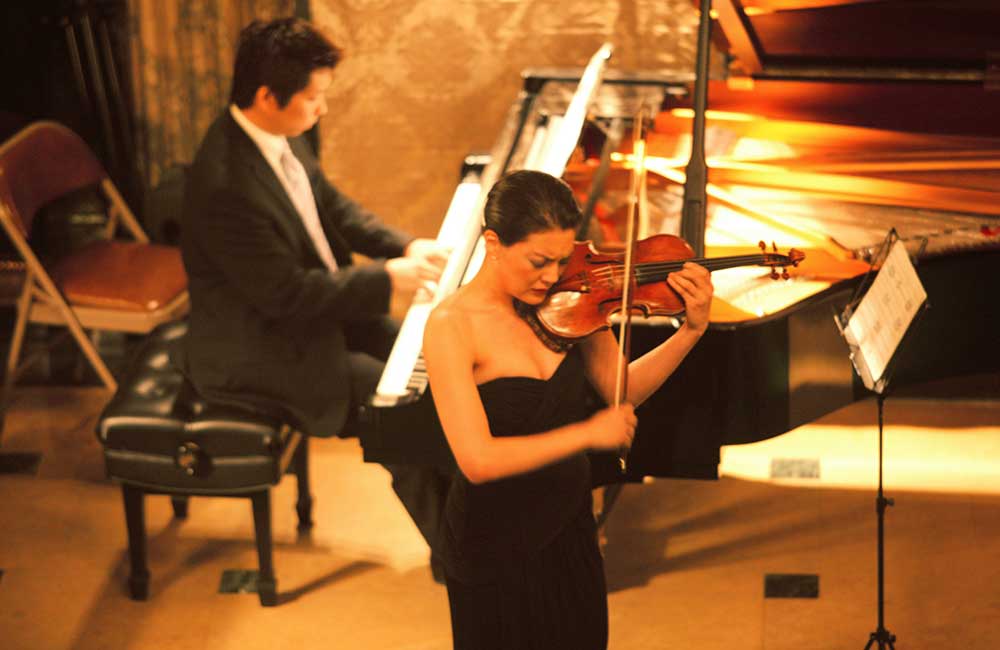
7

8

9
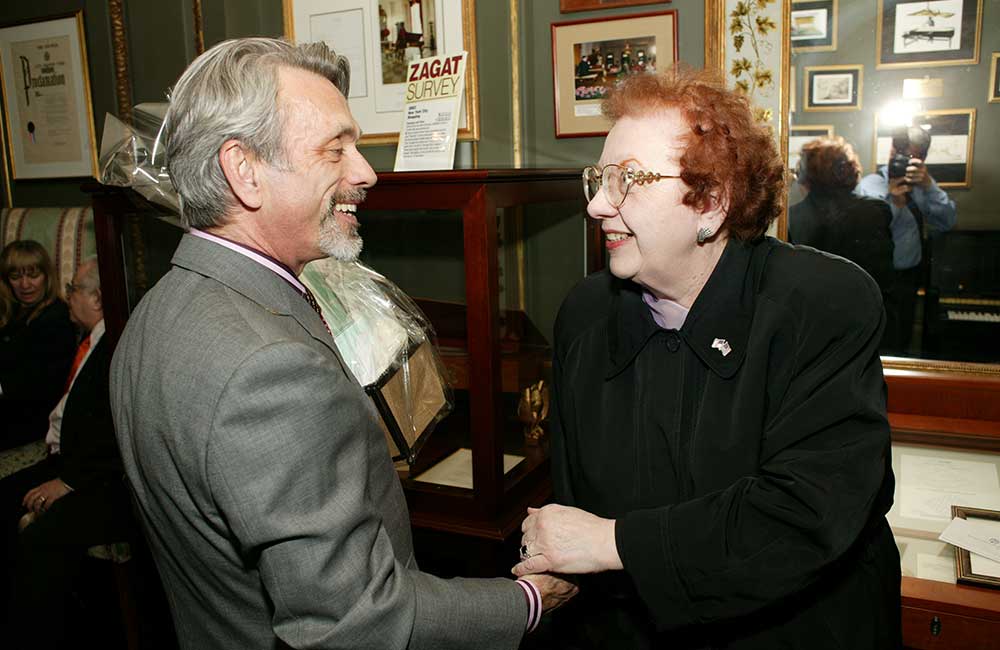
10
1) View of Steinway Hall from above.
2) Guests gather in the hallway.
3) Bidding on auction items.
4) Mark Rabinow, MFH’s Graphic Designer (left), with Patrick Derivaz, Artistic Director.
5) Board member Catherine Cho (center) with her husband,Todd Phillips.
6) Guest Host Elliott Forrest interviews violinist Anne Akiko Meyers just prior to her performance.
7) Anne Akiko Meyers performs in the Concert Hall.
8) Greek bouzouki virtuoso Avram Pengas.
9) Majella Matyas (left) with MFH’s Founder and Executive Director, Allegra Klein.
10) Board member Bruce Tilley with a friend.
Photos by Michael Lisnet.
Fall Concert • September 11, 2006
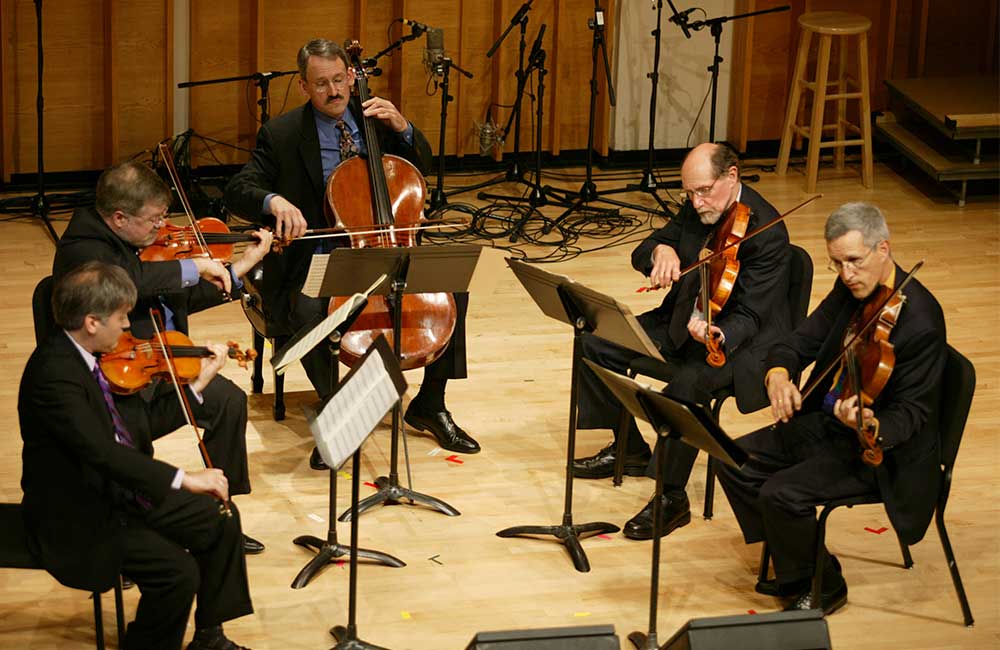
1
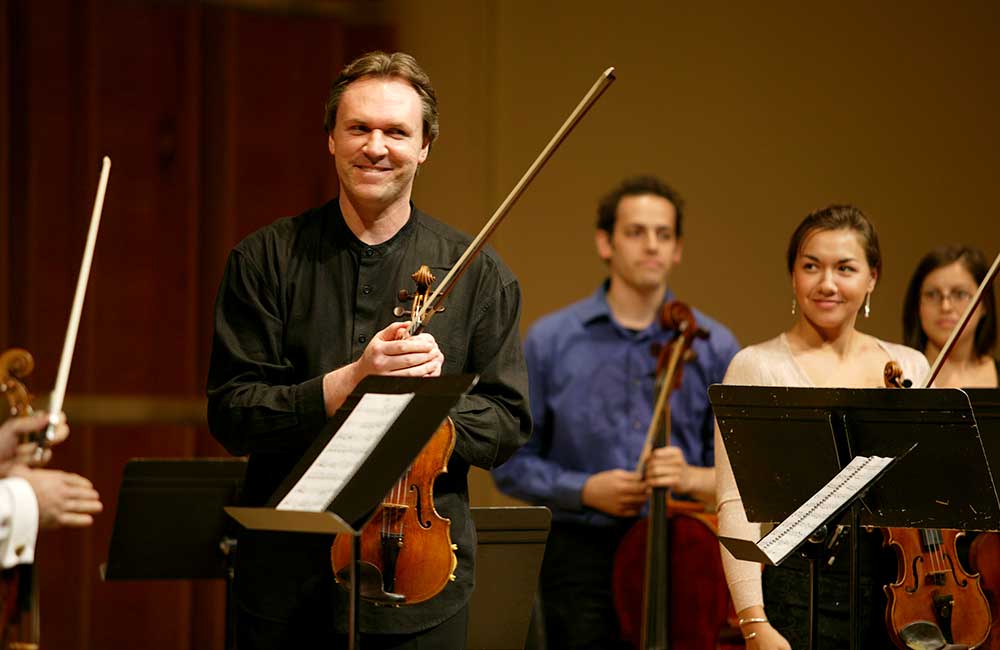
2
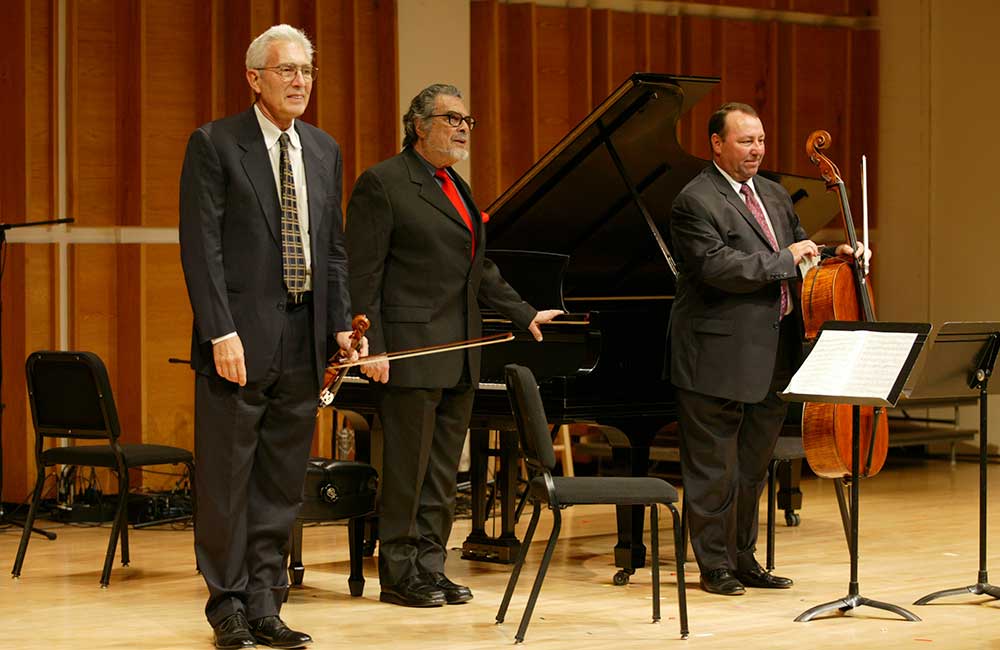
3
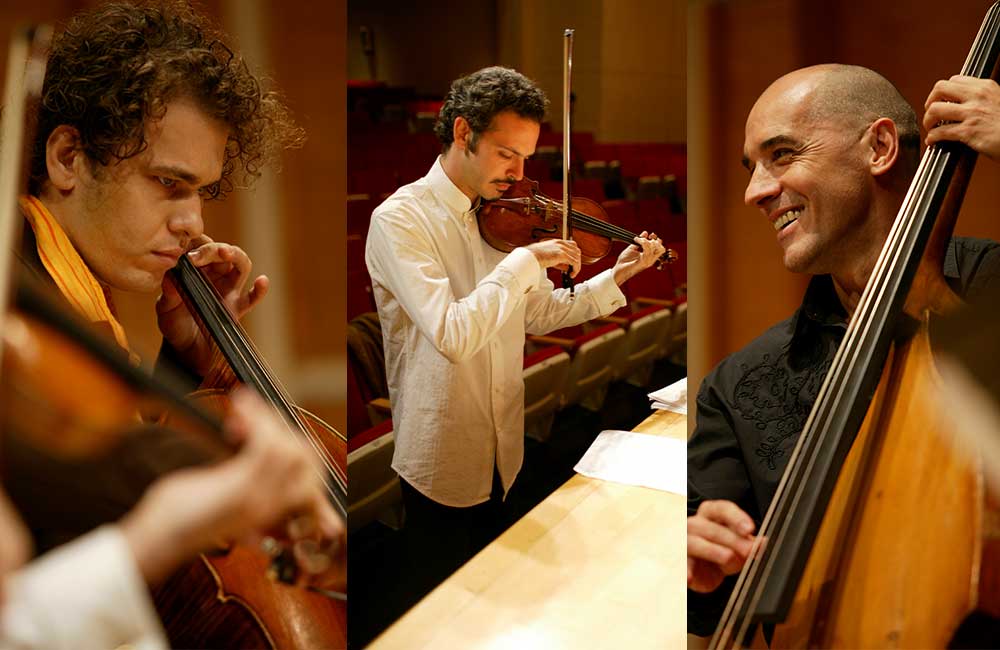
4
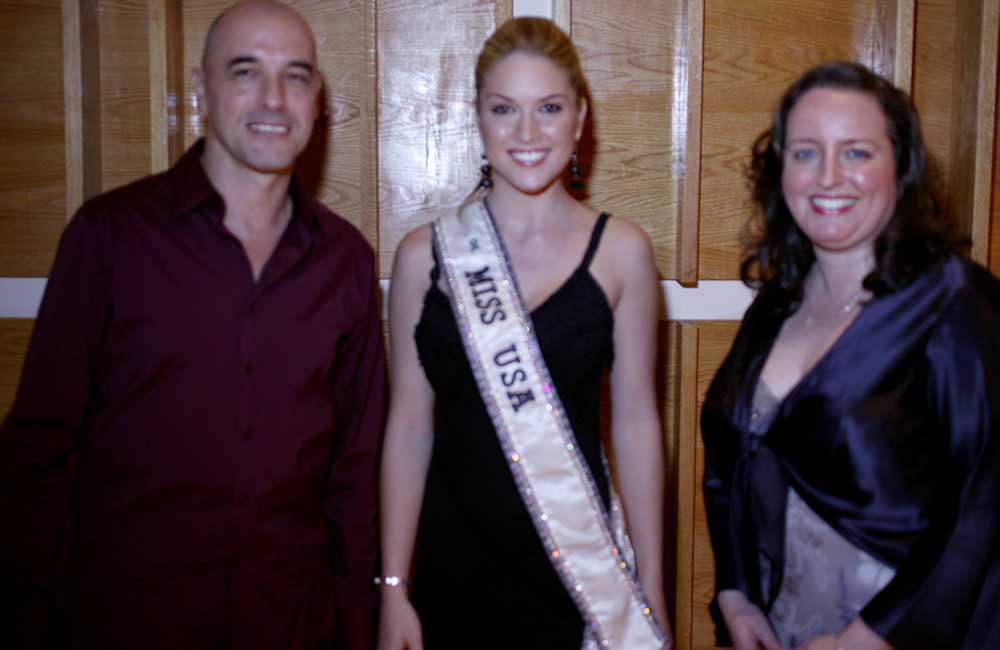
5

6
1) The Orion Quartet performs Mozart’s String Quintet in G minor with Guarneri Quartet violist Michael Tree (second from right).
2) Mark O’Connor premières his “Harmony” with The Knights string orchestra.
3) The Guarneri Quartet’s Arnold Steinhardt and Peter Wiley take a bow with pianist Leon Fleisher (center) after performing Brahms’ Piano Trio in C.
4) Rubin Kodheli, Colin Jacobsen, and artistic director Patrick Derivaz.
5) Miss USA, Tara Conner, poses during intermission with Patrick Derivaz and executive director Allegra Klein.
6) Musique Sans Frontières warms up: (l. to r.) Colin Jacobsen, Rubin Kodheli, Tony Trischka, Patrick Derivaz, Benny Koonyevsky.
Photo 2 by G. Paul Burnett, New York Times. All other photos by Diane Kosup and Michael Lisnet.
Spring Benefit • May 23, 2006

1
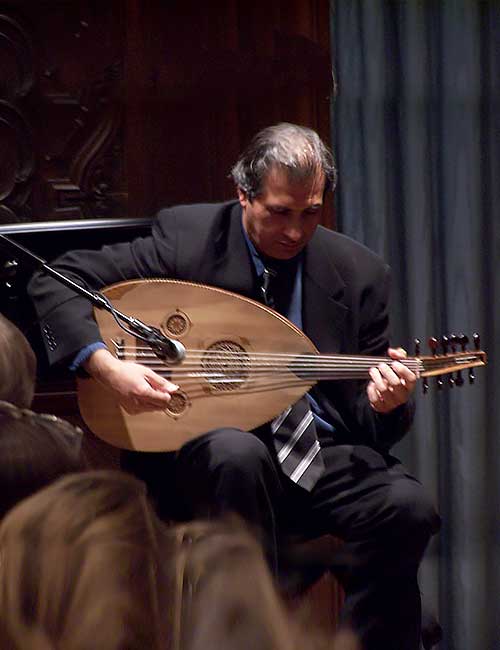
2
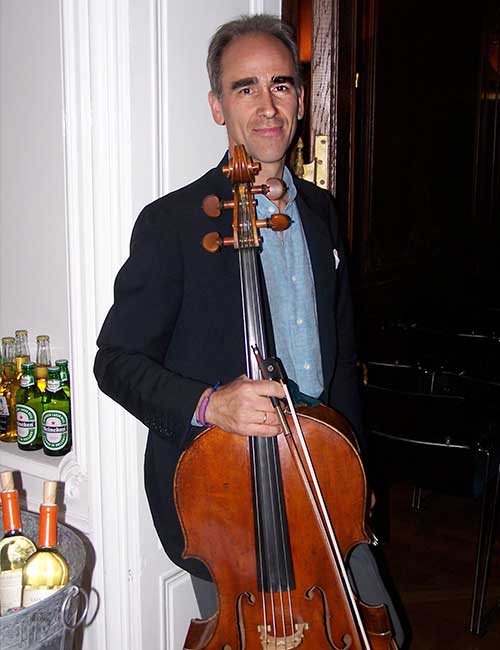
3
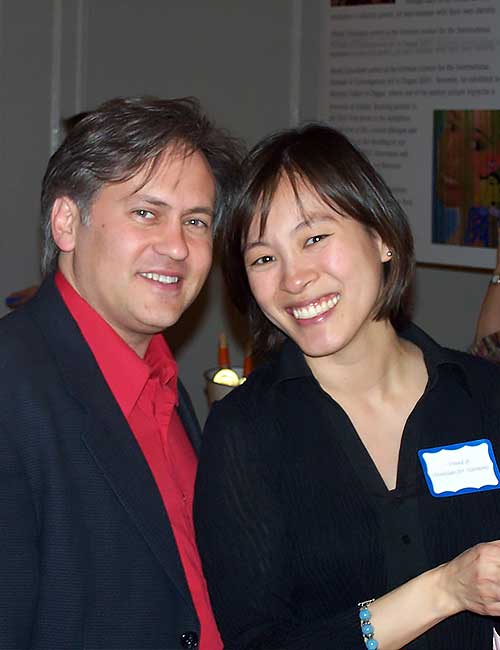
4
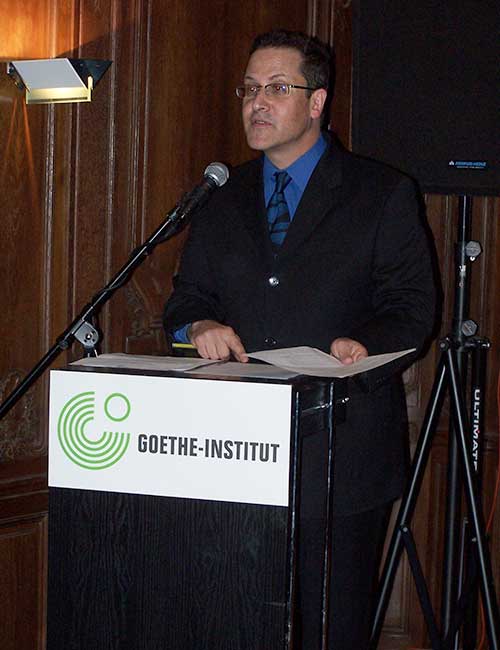
5
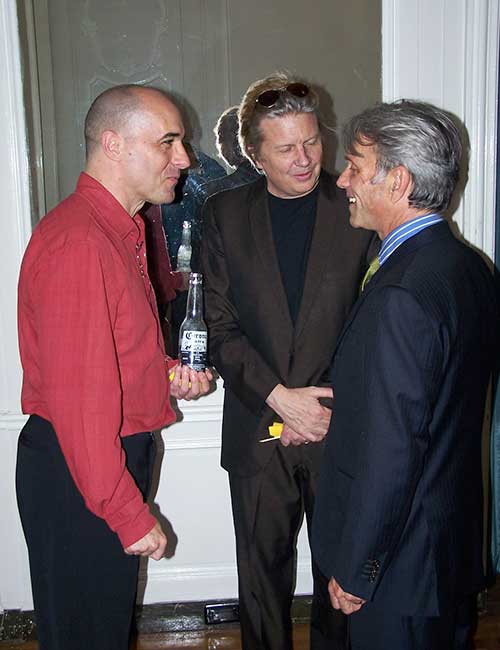
6
(1) Cellist Carter Brey performs for MFH’s Spring Benefit 2006.
(2) Lebanese musician Bassam Saba performs on the oud.
(3) Carter Brey, prinicipal cellist of the New York Philharmonic, following his performance for the Benefit.
(4) MFH Board member Catherine Cho, with her husband Todd Phillips, violinist of the Orion Quartet.
(5) Elliott Forrest, host of WQXR Radio, introduces the performers for the concert.
(6) MFH artistic director Patrick Derivaz (left) talks with guests at the reception.
All photos by Mark Rabinow.
Fall Concert • September 13, 2005
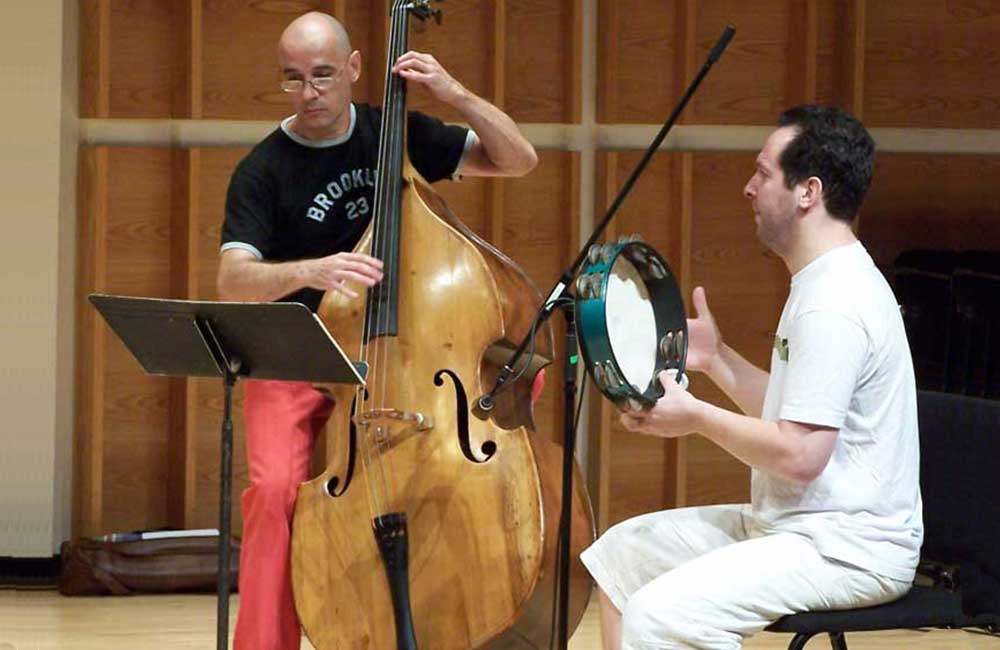
1
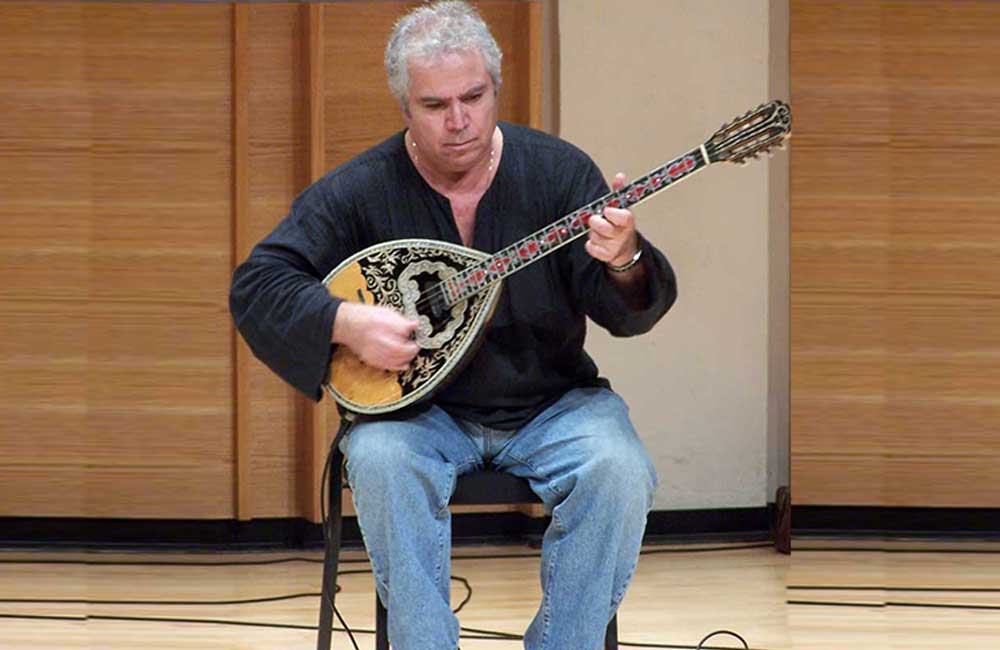
2
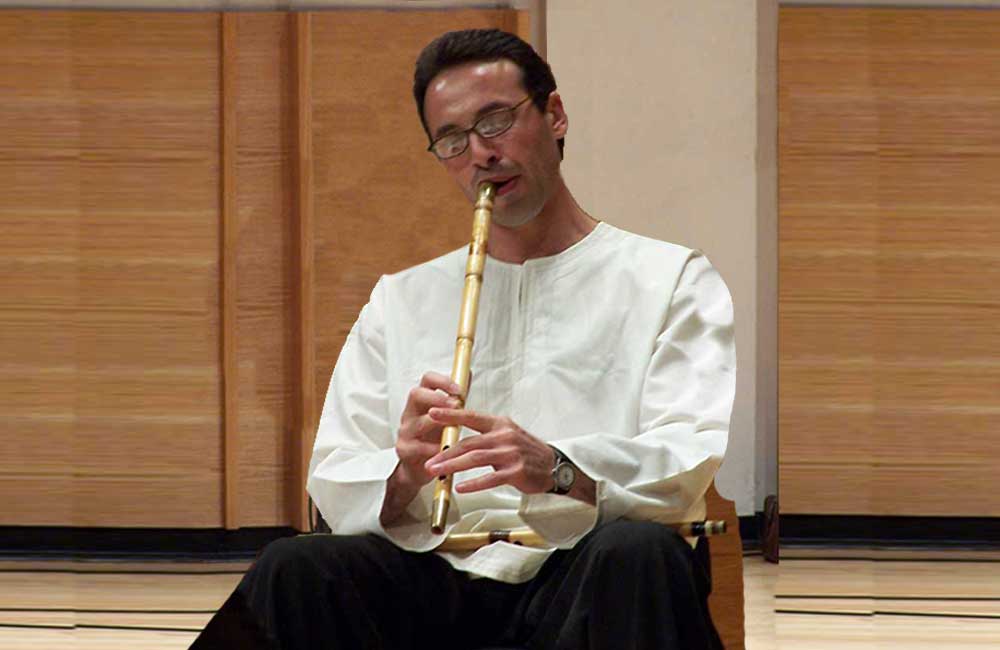
3
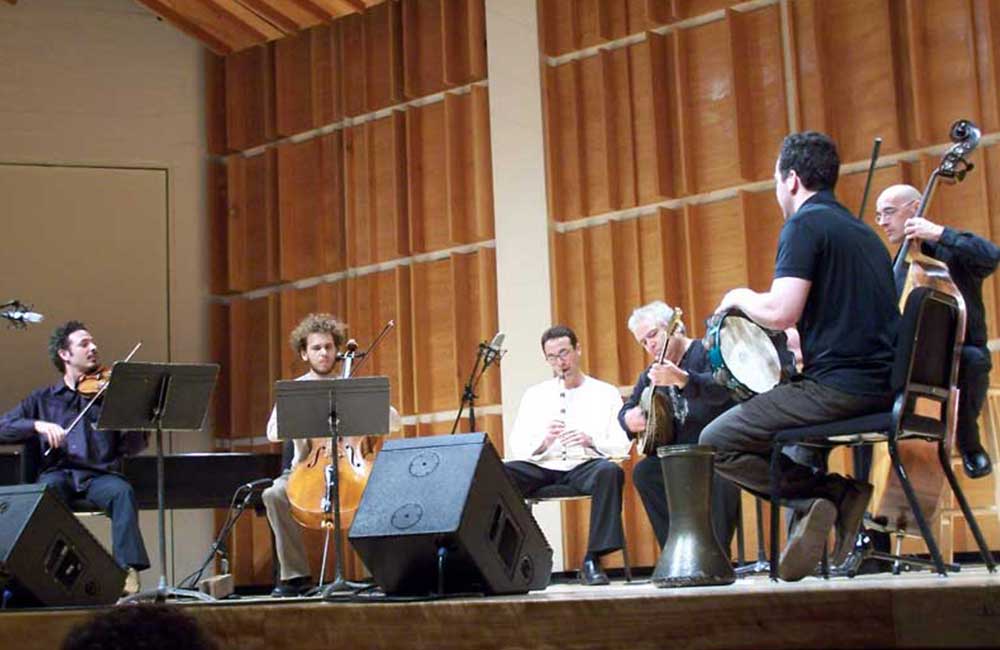
4
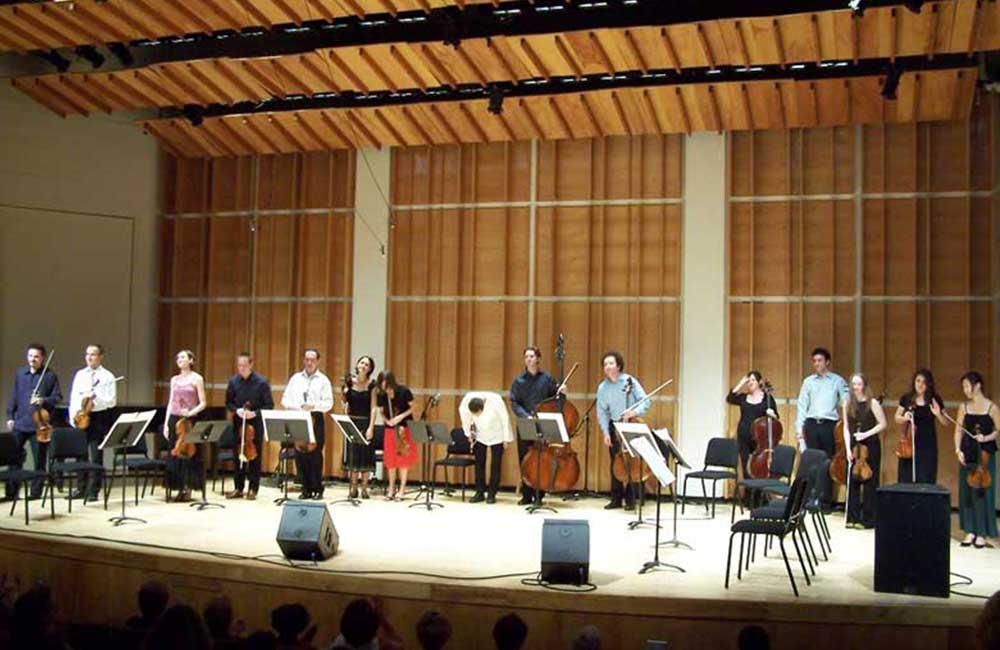
5
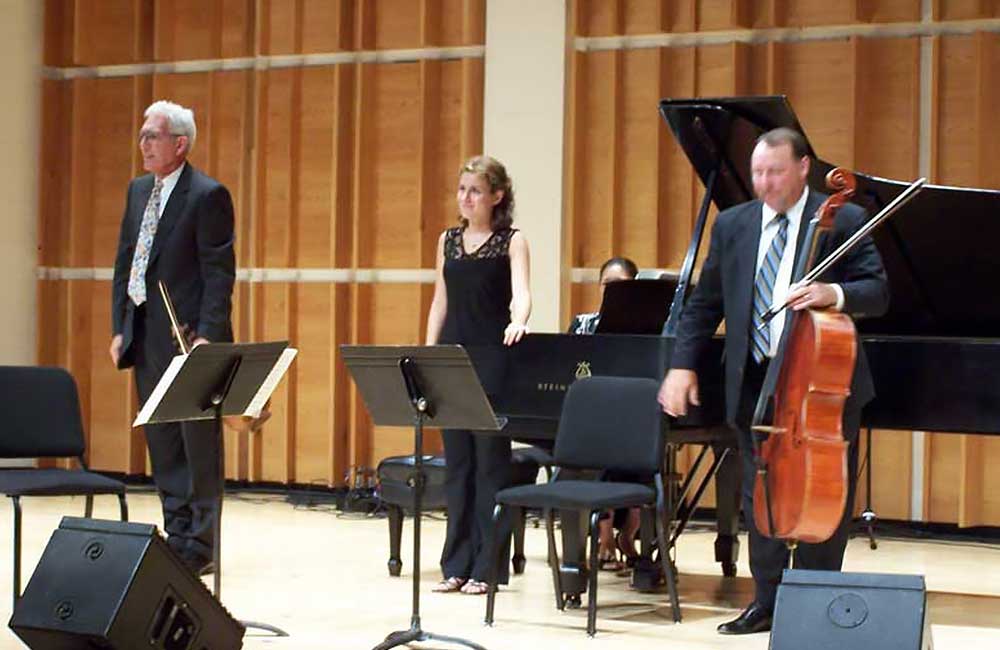
6
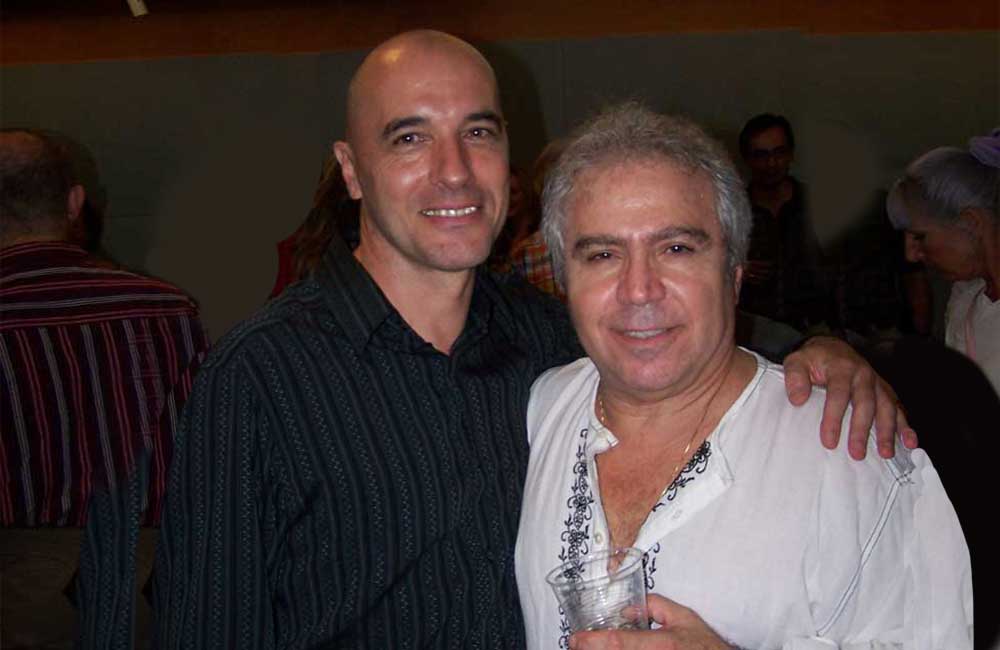
7
1) Patrick Derivaz, Musicians For Harmony’s Artistic Director (left), warms up with percussionist
Benny Koonyevsky.
2) Bouzouki virtuoso Avram Pengas.
3) Siamak Jahangiri, ney player.
4) The Knights string orchestra after after a performance of
Hossein Alizadeh’s Ney Nava.
5) Musique Sans Frontières: Colin Jacobsen,Rubin Kodheli, Siamak Jahangiri, Avram Pengas,
Benny Koonyevsky, and Patrick Derivaz (l-r).
6) Arnold Steinhardt, Anna Polonsky, and Peter Wiley take a bow after performing
Beethoven’s Piano Trio in E-flat.
7) Patrick Derivaz and Avram Pengas at the post-concert reception.
Photos by Mark Rabinow
Spring Benefit • May 12, 2005
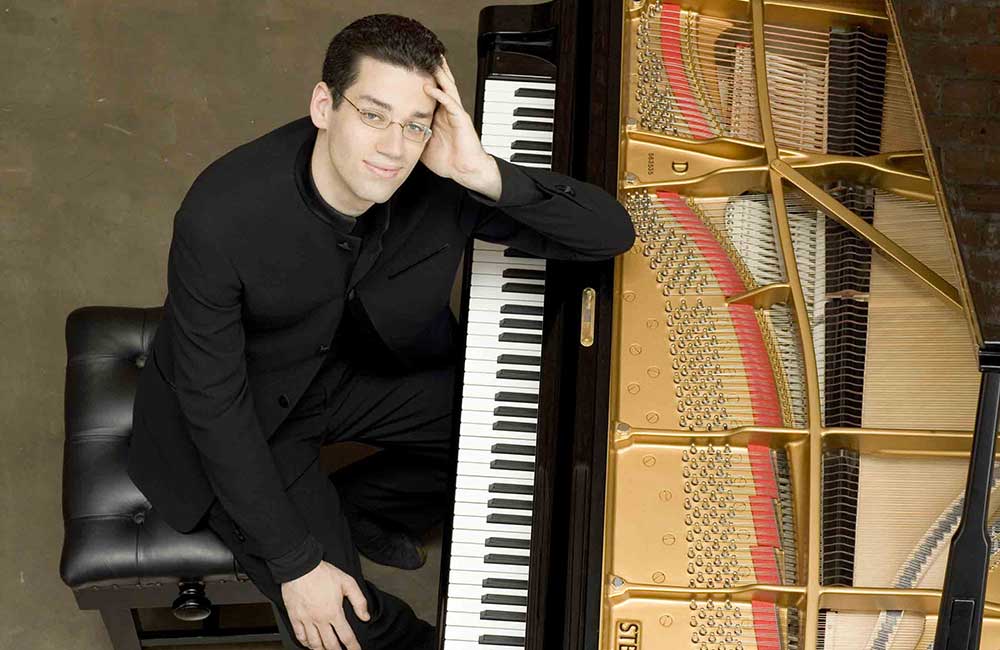
1
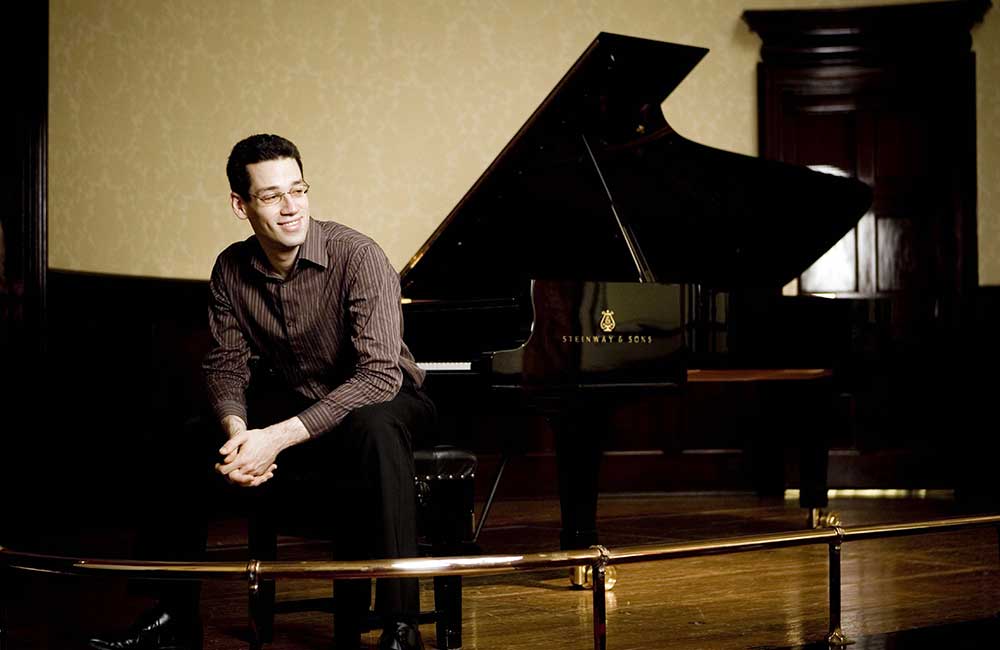
2
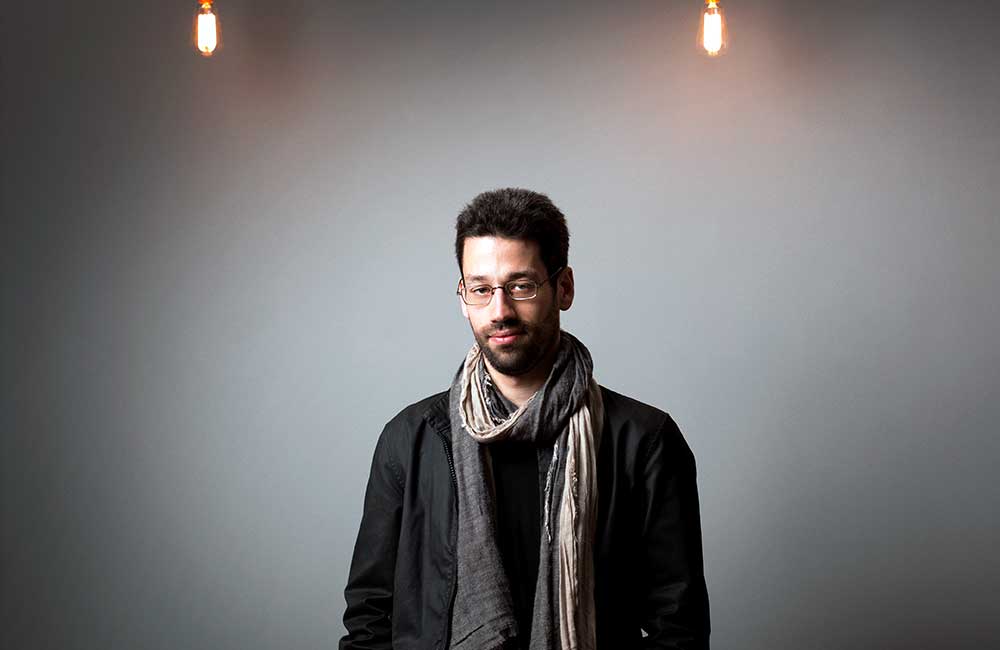
3
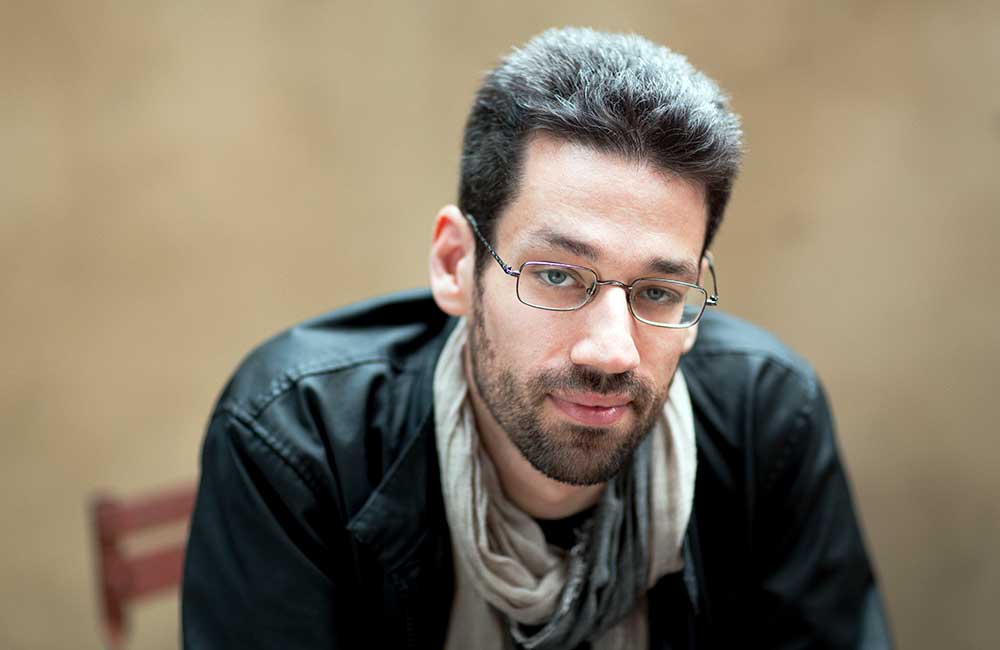
4
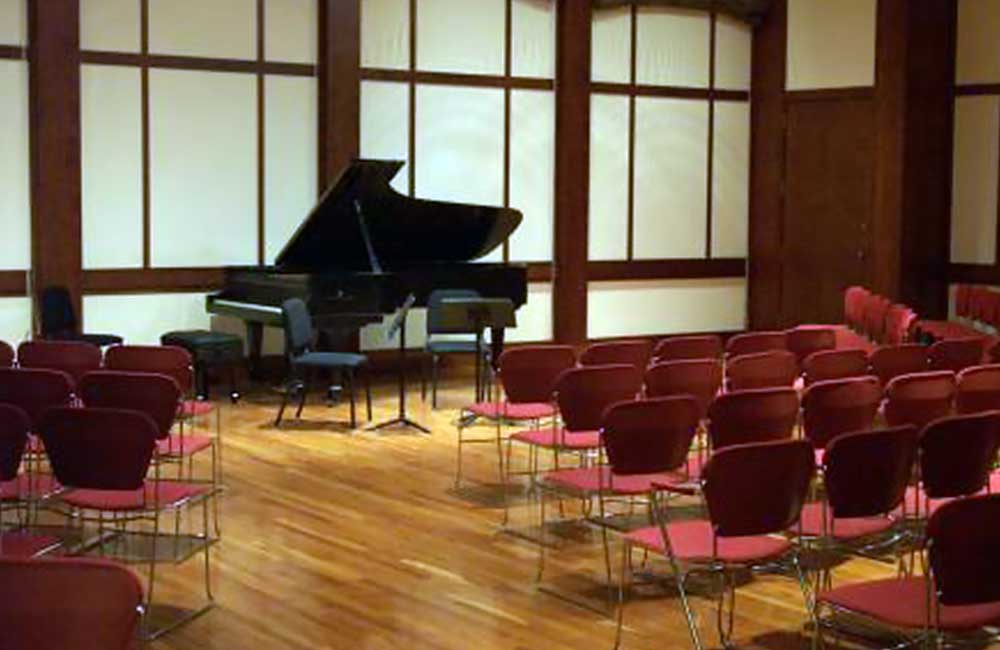
5
Our second spring benefit was held on May 12, 2005, at the Rose Studio at Lincoln Center, with a performance by pianist Jonathan Biss.
1) Jonathan Biss promotional photo. 2) Photo by Jillian Edelstein.
3) & 4) Photos by Benjamin Ealovega. 5) The Rose Studio, Lincoln Center.
Fall Concert • September 13, 2004

1
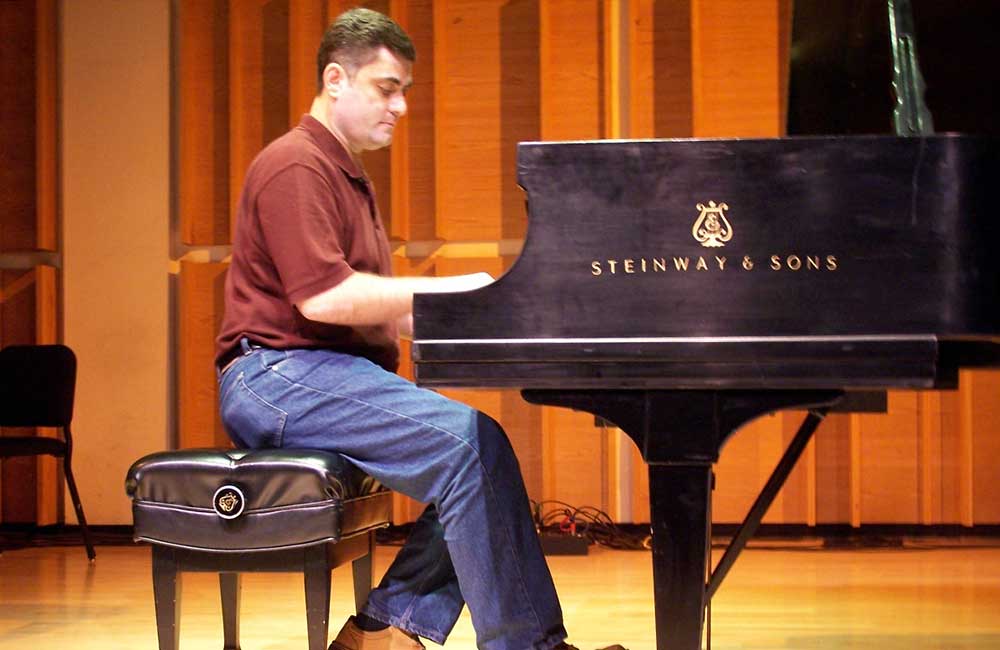
2
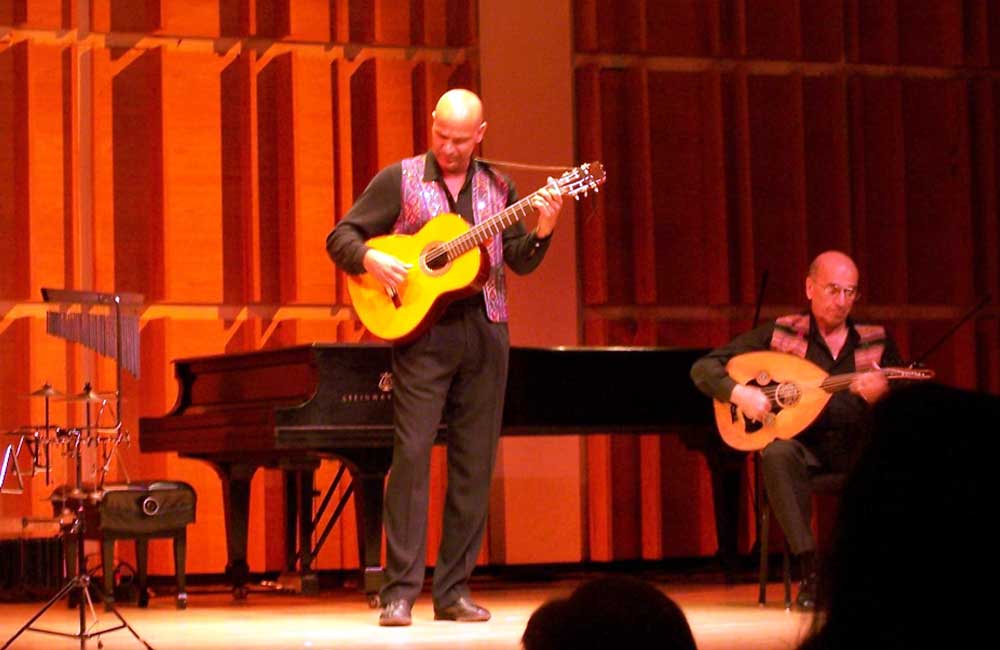
3

4
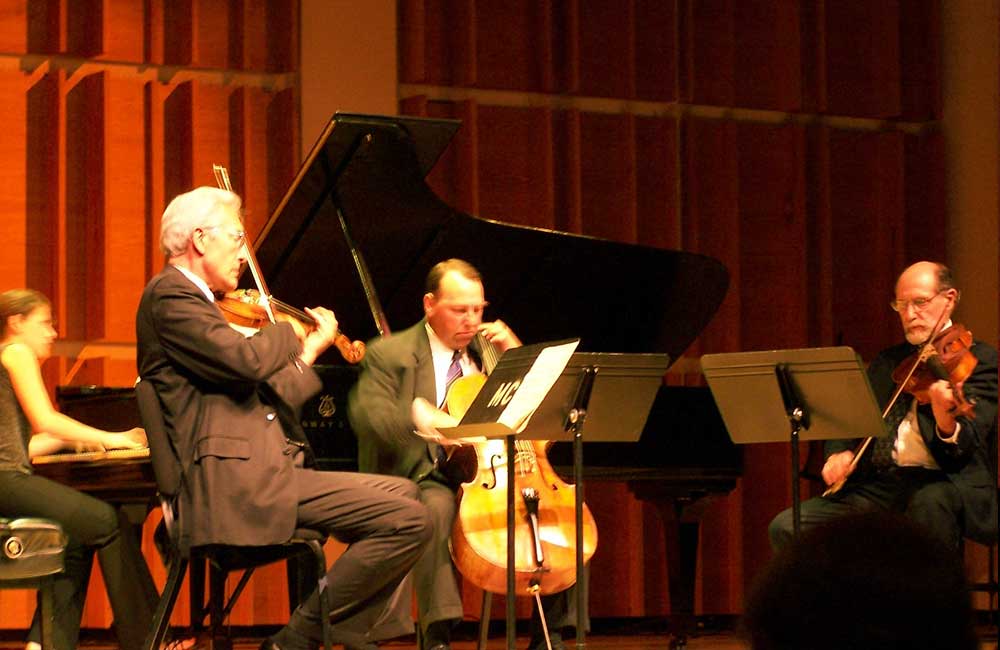
5
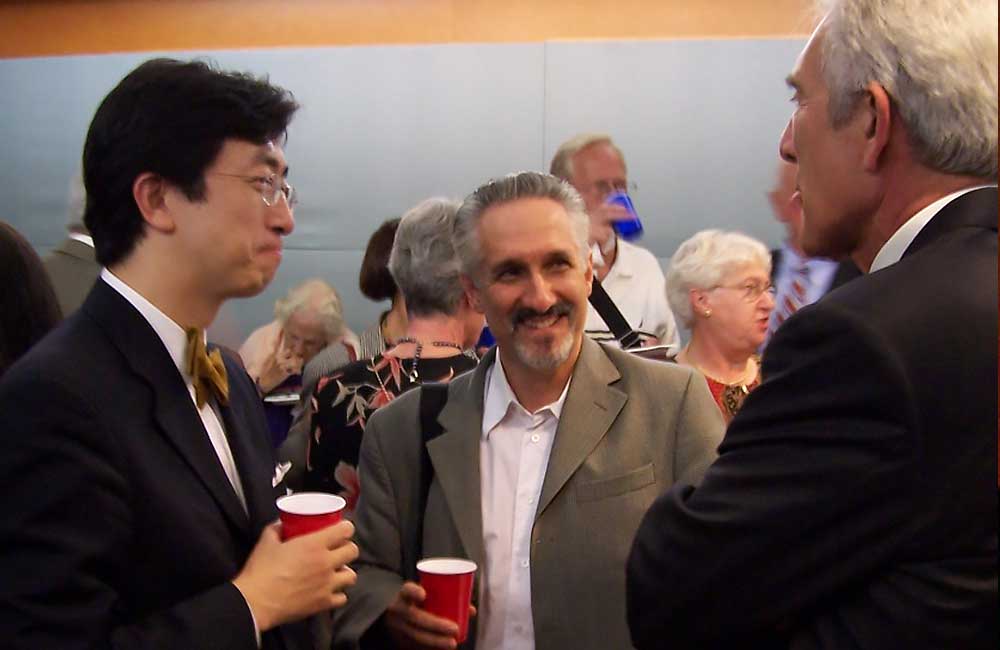
6
1) The Shanghai Quartet warms up for the concert.
2) Iraqi pianist Hassan Al-Mufti.
3) Members of the Gerard Edery Ensemble.
4) Albanian singer Justina-Marie performs with Musique Sans Frontières.
5) Anna Polonsky, Arnold Steinhardt, Peter Wiley, and Michael Tree perform Dvorák’s Piano Quartet No. 2 in E-flat.
6) Violinists Weigang Li (left) and Arnold Steinhardt (right) relax with luthier Dov Buck at the post-concert reception.
All photos by Mark Rabinow
Spring Benefit • March 2004
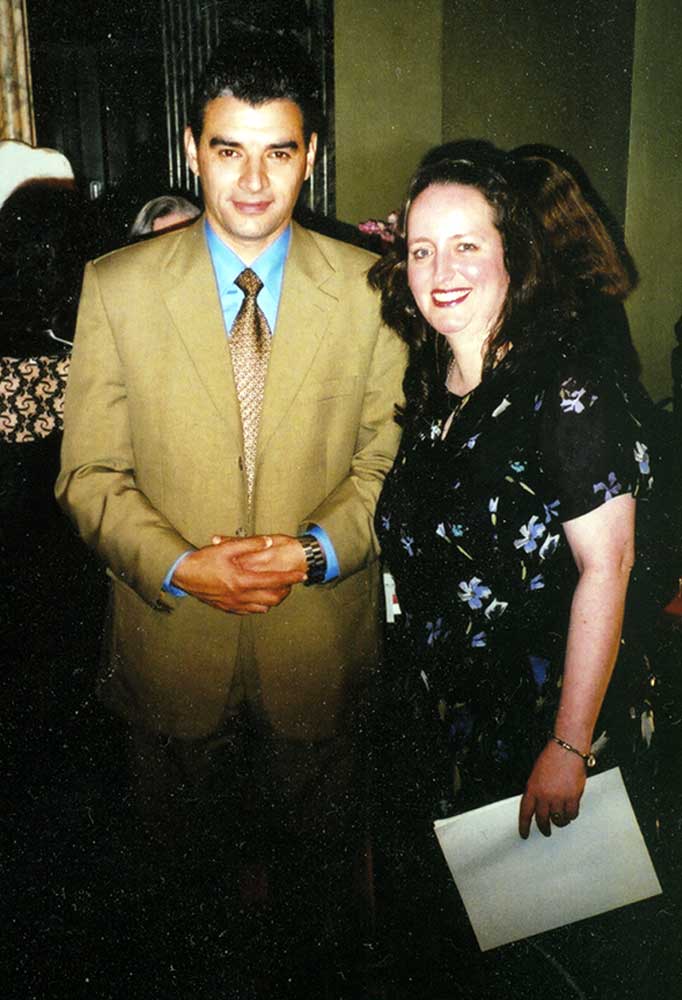
1
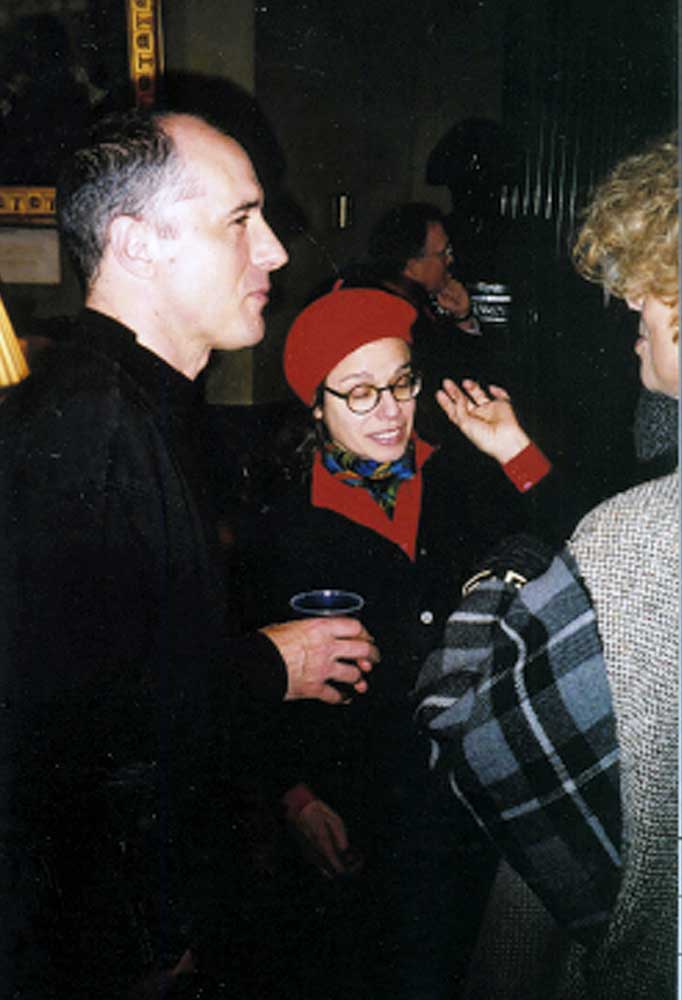
2
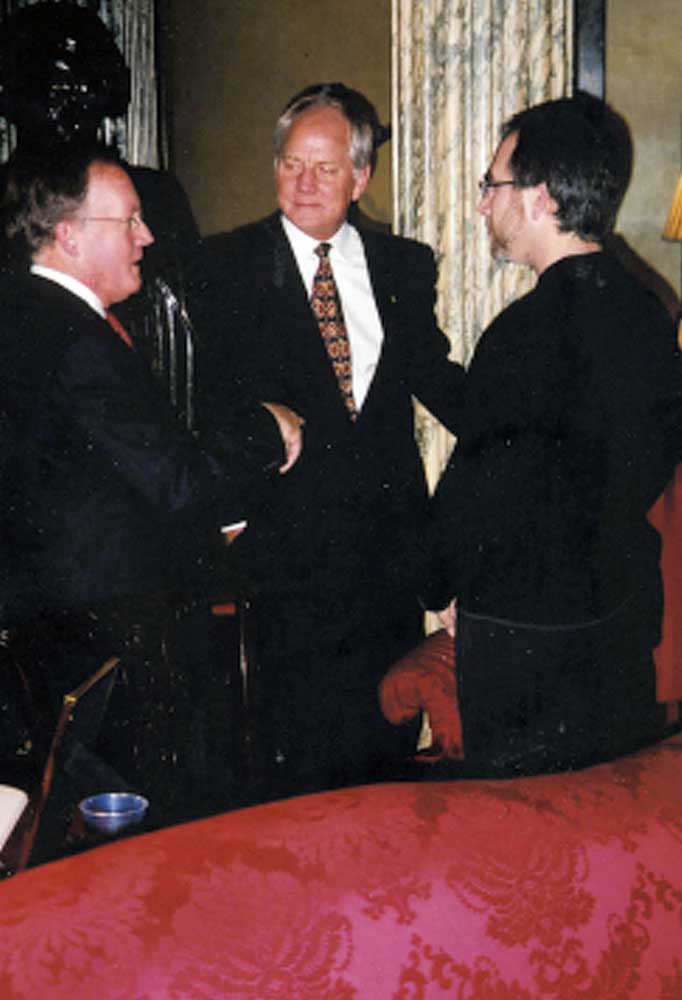
3
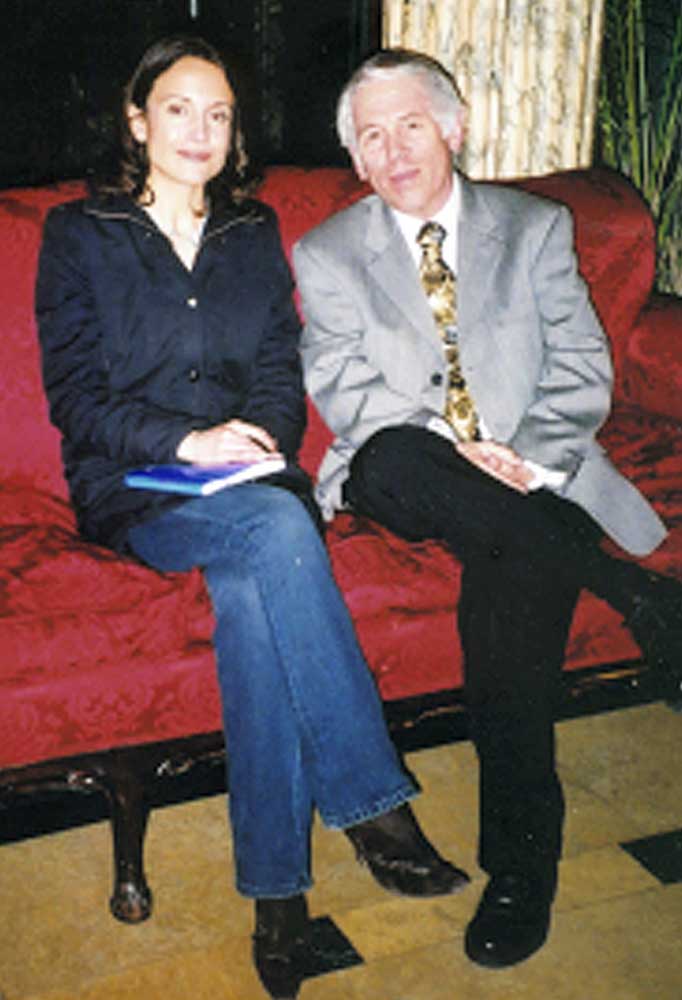
4
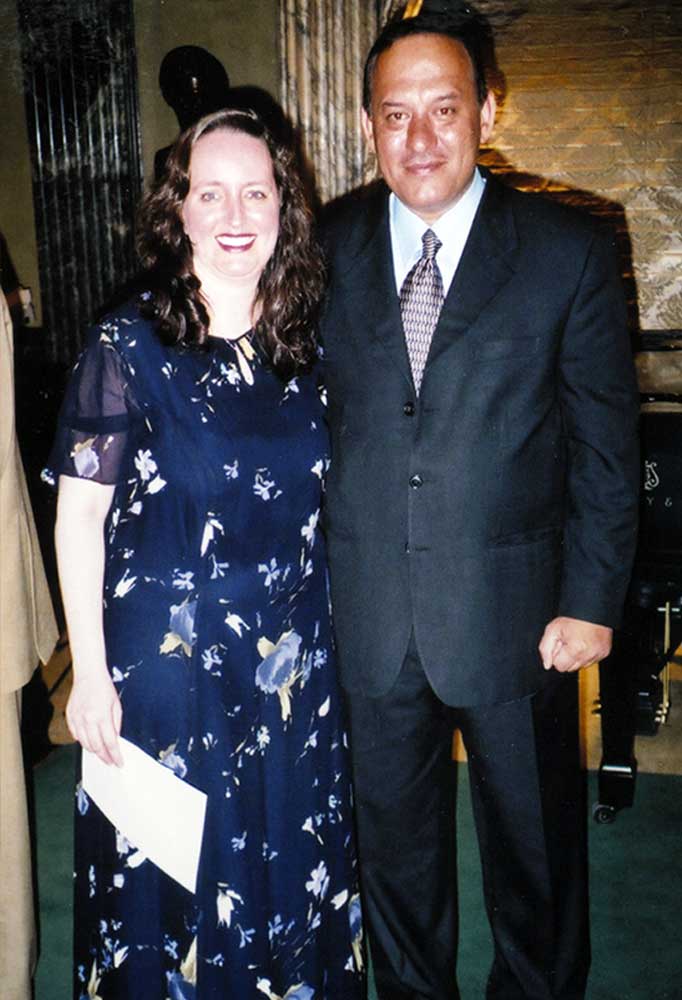
5
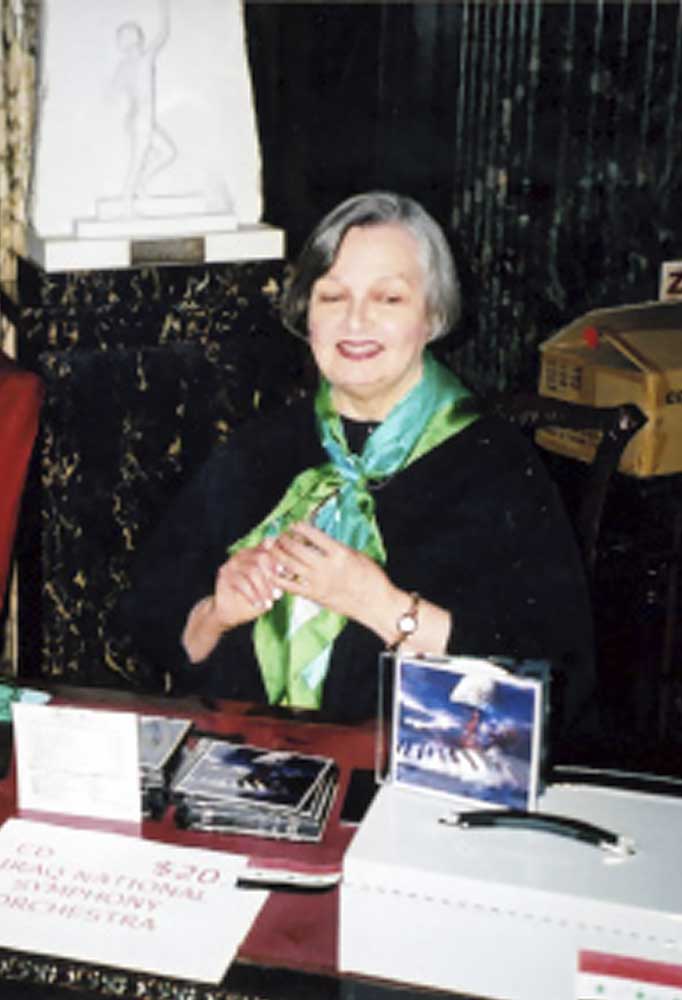
6
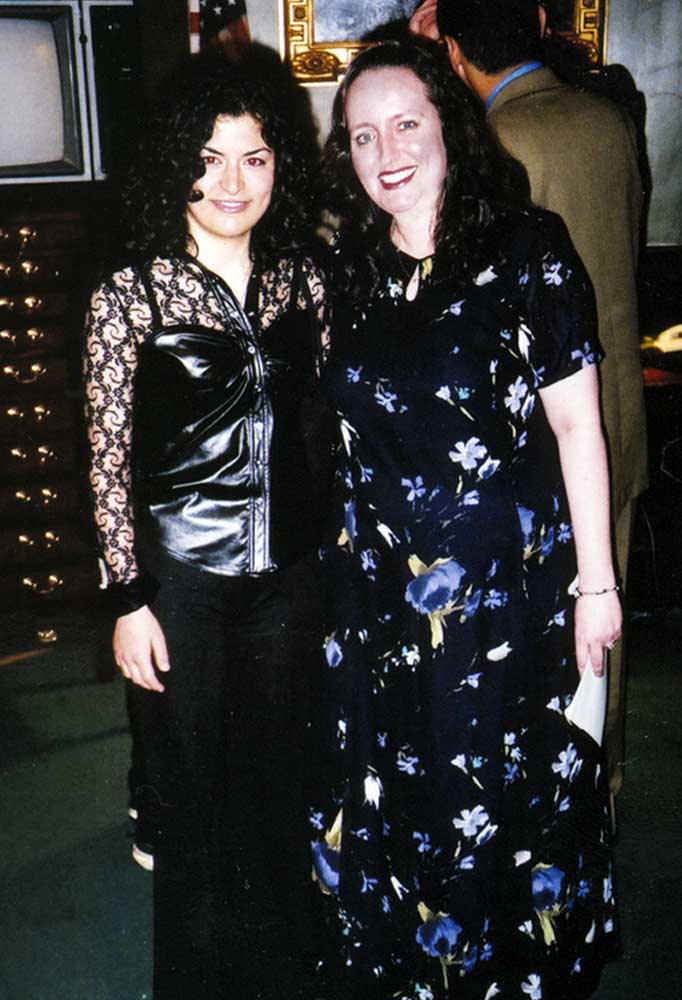
7
1) Majid Al-Ghazali, concertmaster of the Iraqi National Symphony Orchestra, with Allegra Klein, Executive Director of MFH.
2) Patrick Derivaz, Artistic Dir. of MFH, with Gail Silberman, Trustee.
3) Steinway’s Vice-President, Peter Goodrich, and President, Bruce Stevens, talk with MFH Trustee Benjamin Loeb.
4) Pianist Lincoln Mayorga with Anna Sunara.
5) Allegra Klein with Nabil Hani, INSO cellist and maker of “The Rose Violin.”
6) Volunteer Julie Van Ness sells CD’s of the Iraqi National Symphony Orchestra.
7) INSO violinist Annie Melconian with Allegra Klein.
Photos by Mark Rabinow
Trip to Iraq • 2003

1

2
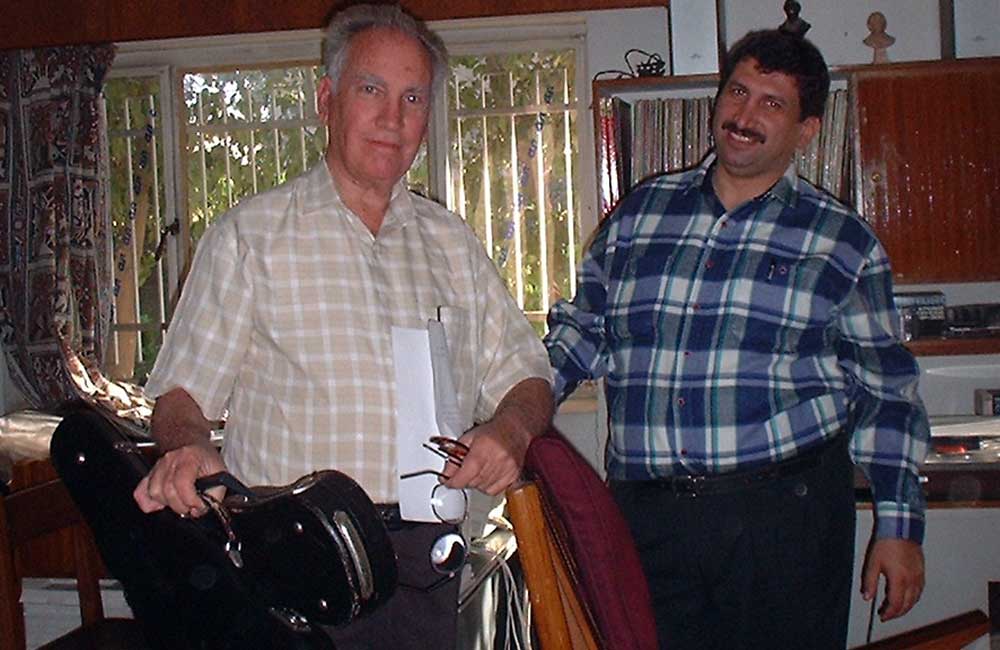
3
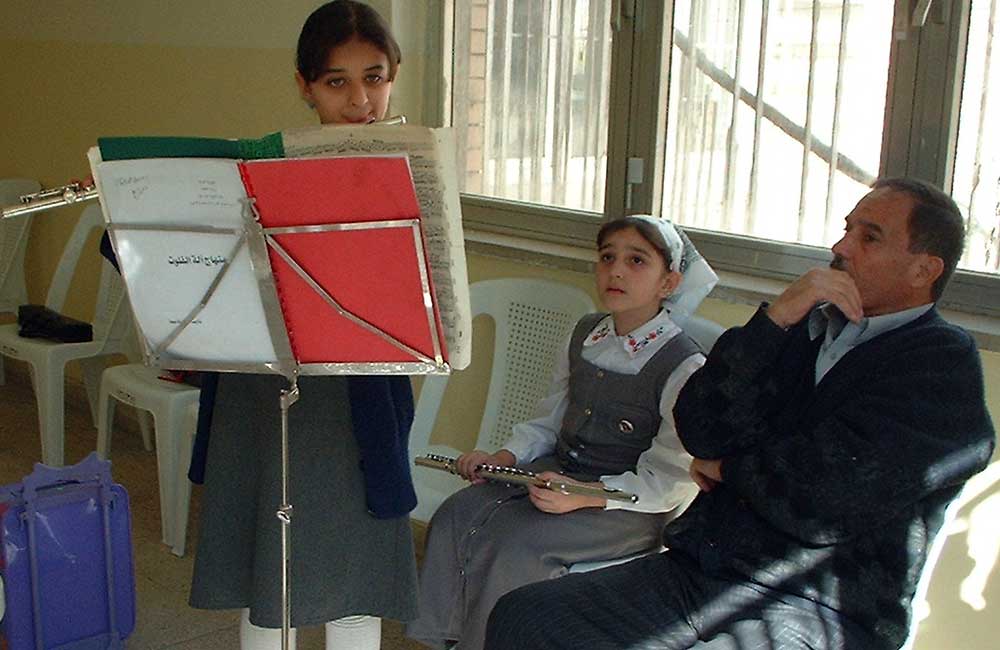
4
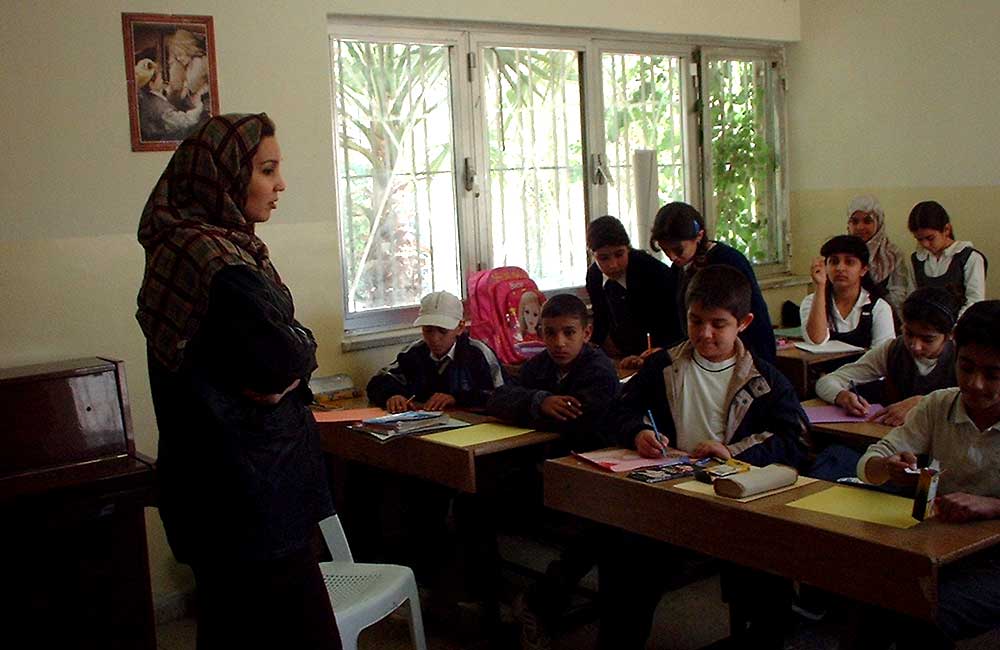
5
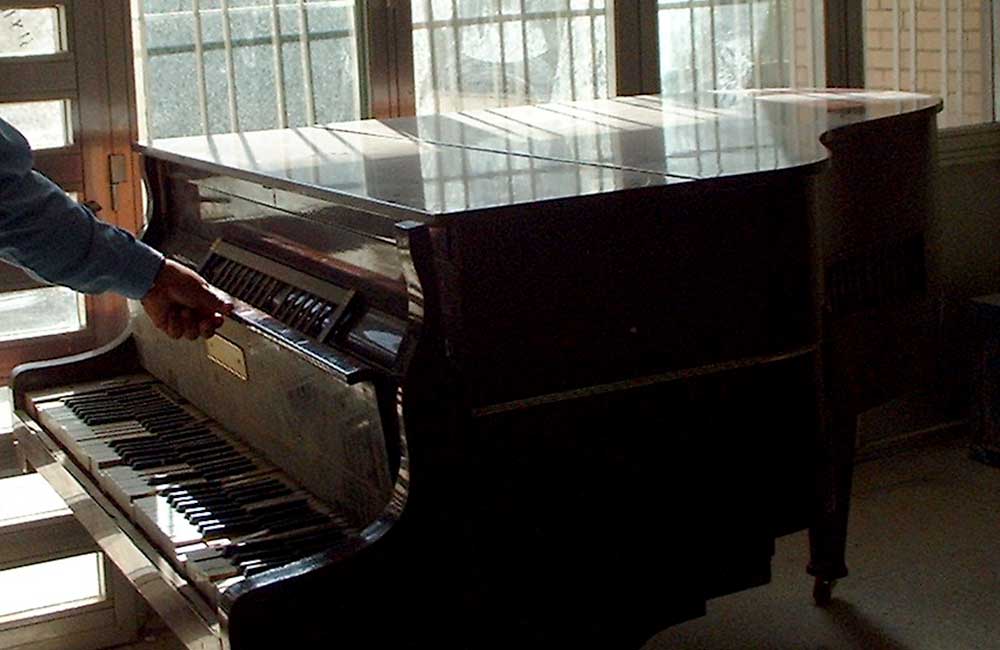
6
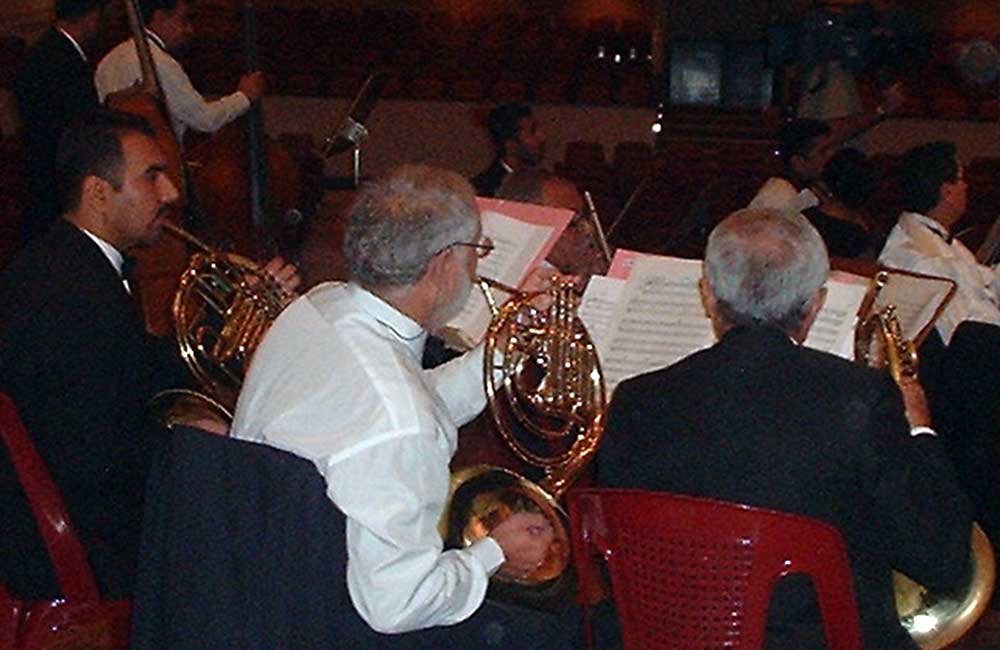
7
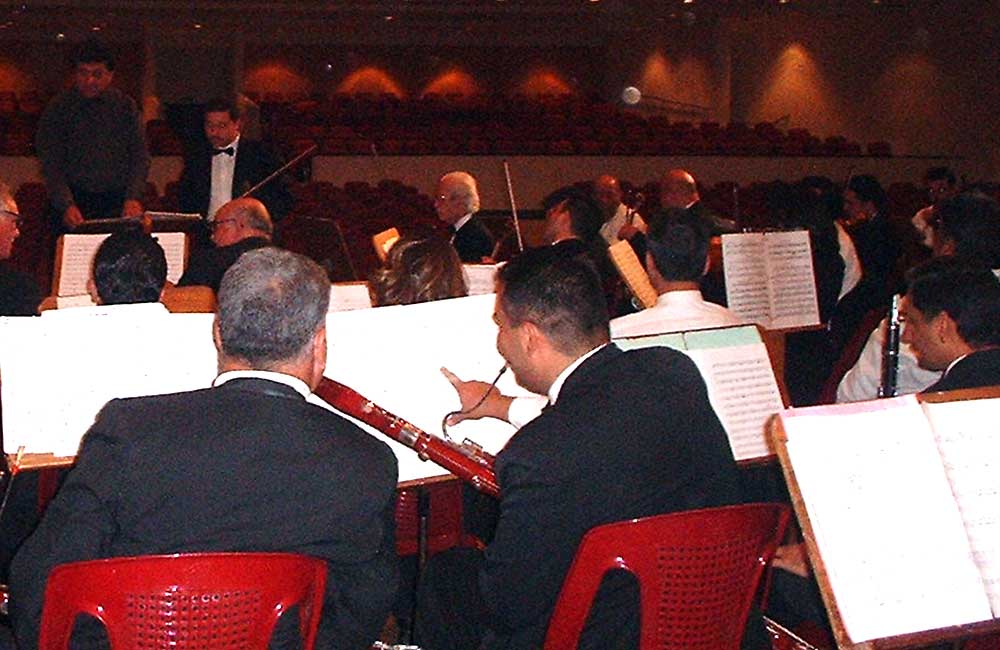
8
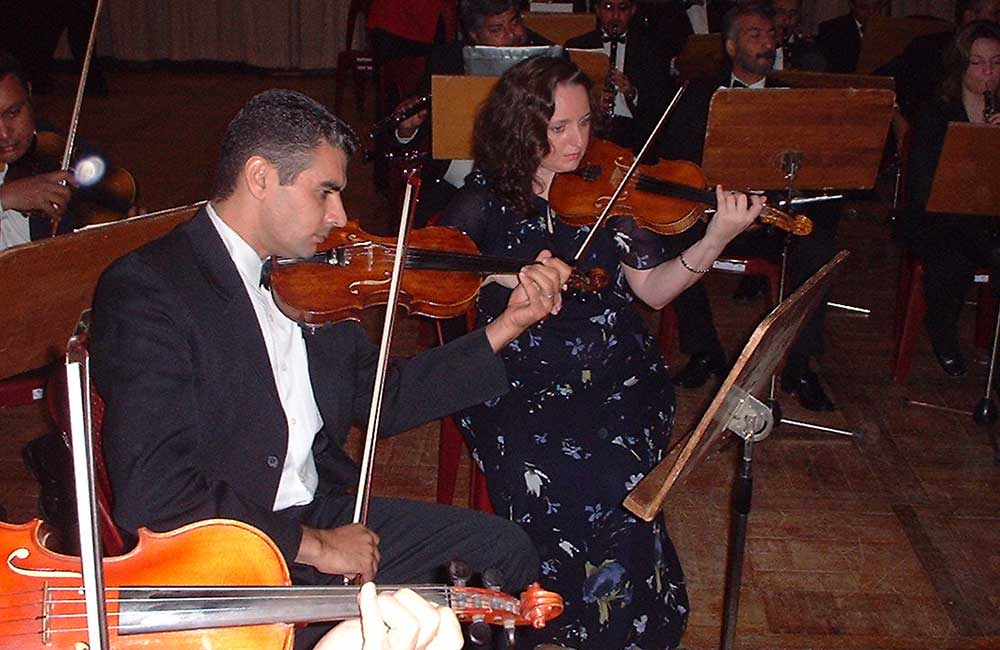
9
Here are photographs from Allegra’s trip to Iraq in November 2003. She has written about this in a letter published in Strings Magazine, and has more to tell about her exciting adventure.
1) Desert at Dawn 2) Overlooking the Tigris River
3) Munther Ha accepting donations 4) Music & Ballet School
5) Music & Ballet School 6) Music & Ballet School-Double P
7) INSO Rehearsal 8) INSO Rehearsal
9) INSO Rehearsal-Majid Al-Ghazal with Allegra Klein

Fall Concert • September 10, 2003
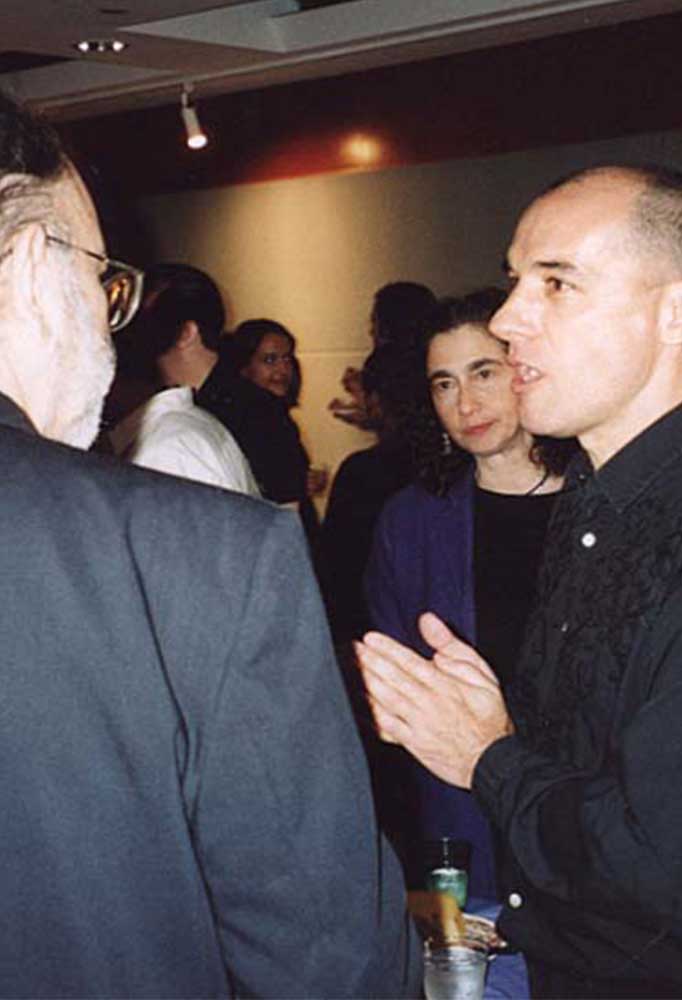
1
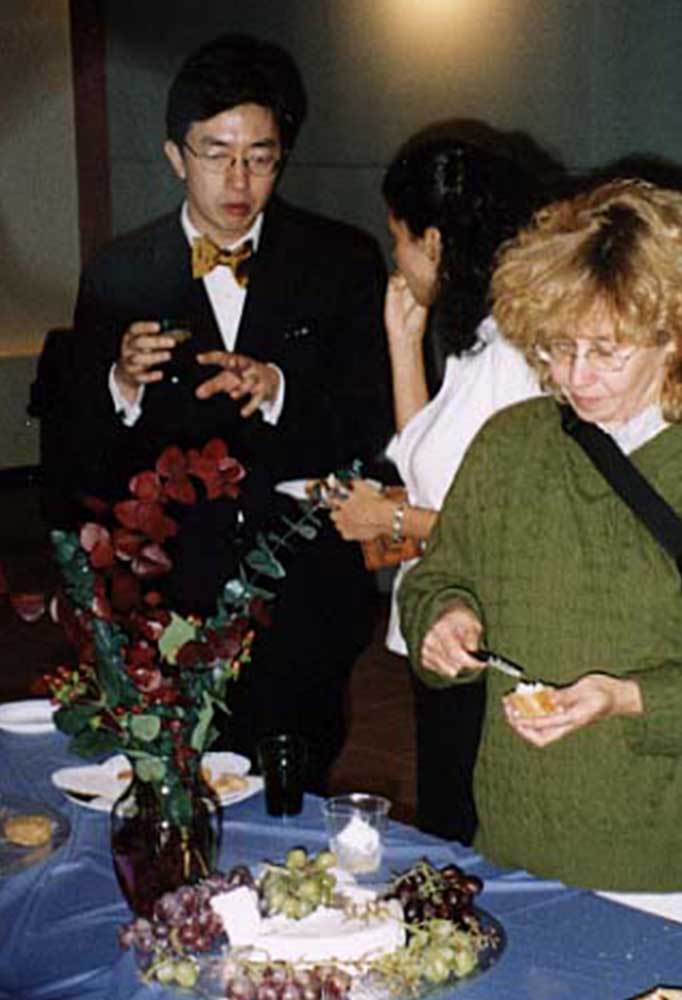
2
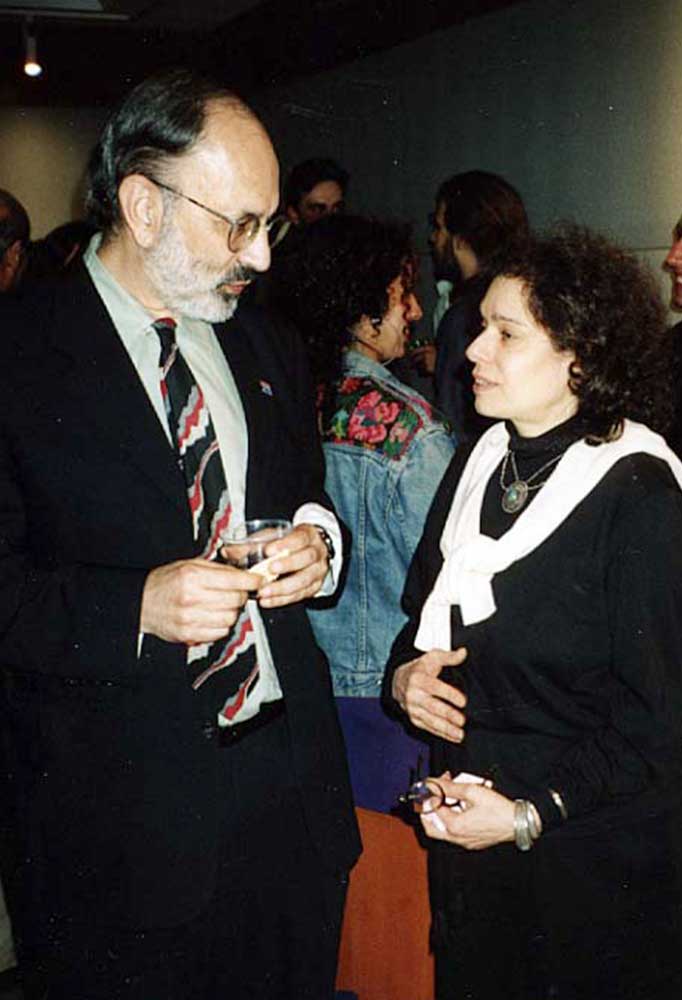
3
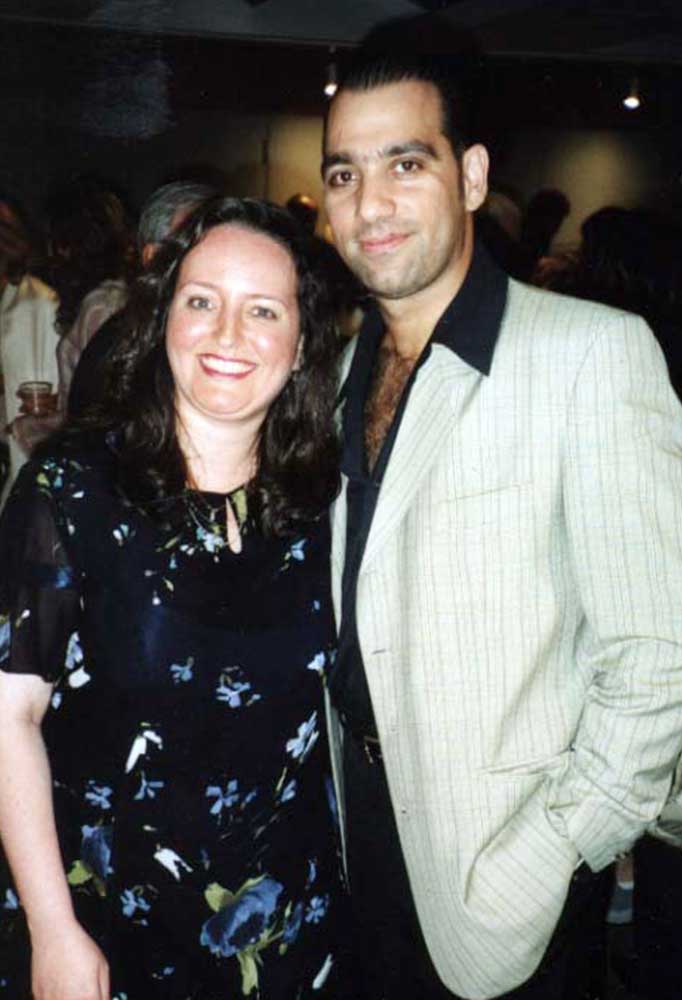
4
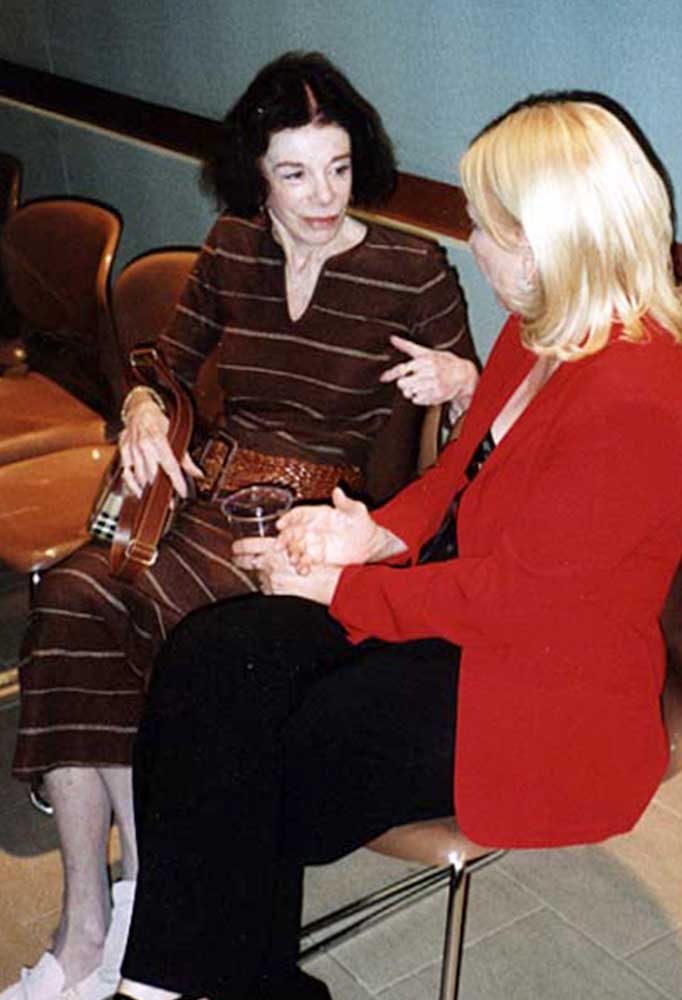
5
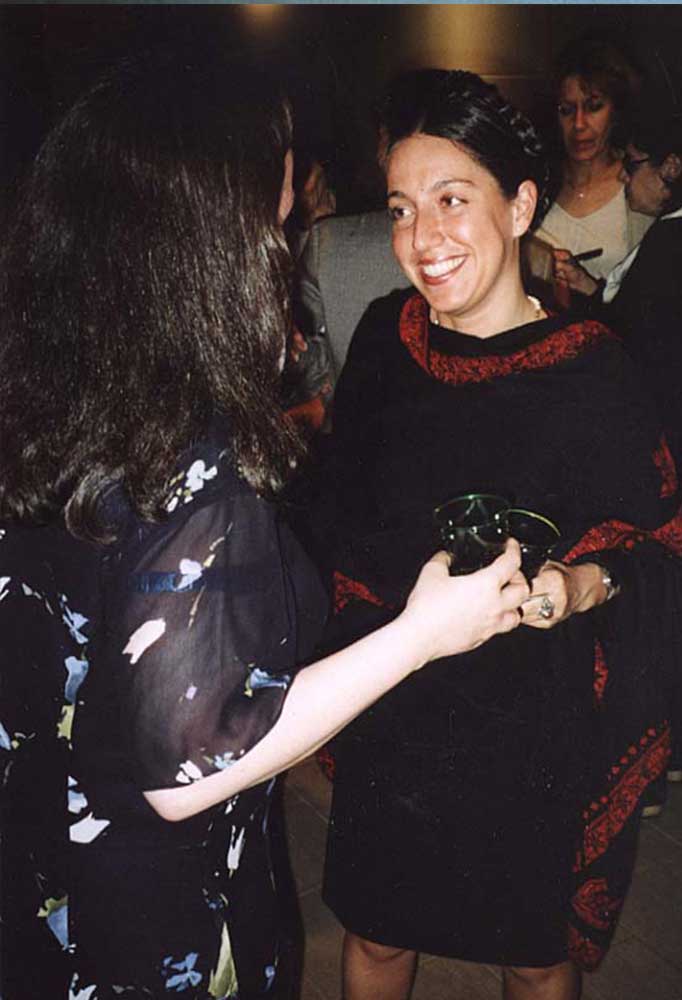
6
1) Alan Gross of Safe Horizon, Judy Gerratt of Music for a Cause (whose concert in June 2003 raised $1,000 for the Iraqi National Symphony Orchestra) and Patrick Derivaz, Artistic Director.
2) Weigang Li, violinist of the Shanghai Quartet.
3) Alan Gross, Gail Silberman, and Shane Shanahan from Musique Sans Frontières.
4) Allegra Klein and Omar Bashir.
5) Two of Musicians For Harmony’s dedicated volunteers.
6) Allegra Klein & Anna M. Pinna.
Photos by Mark Rabinow.
Premiere Concert • September 10, 2002
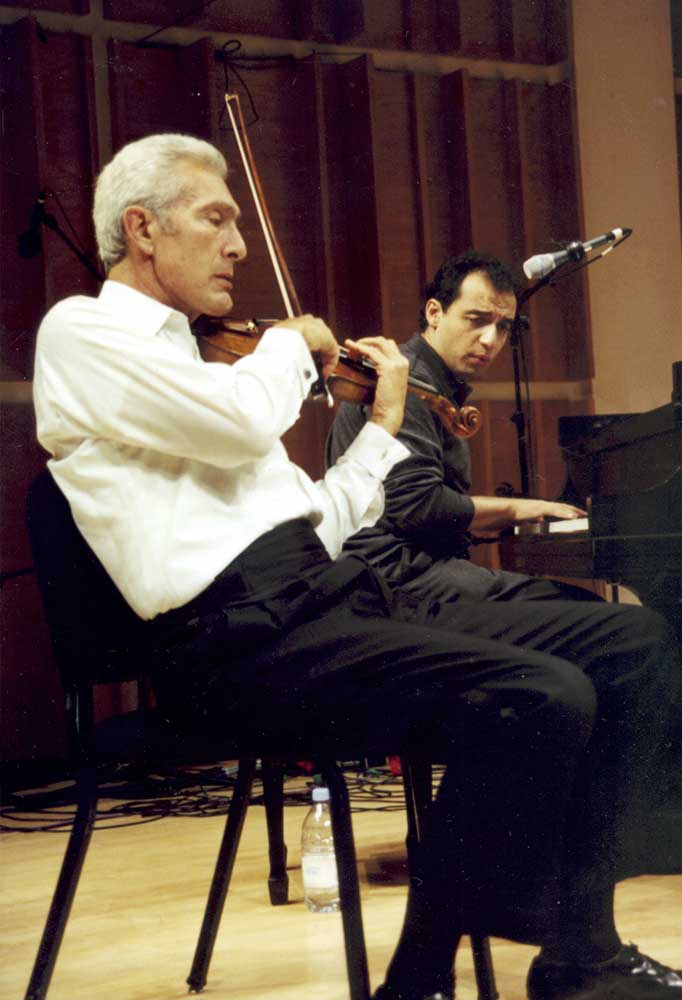
1
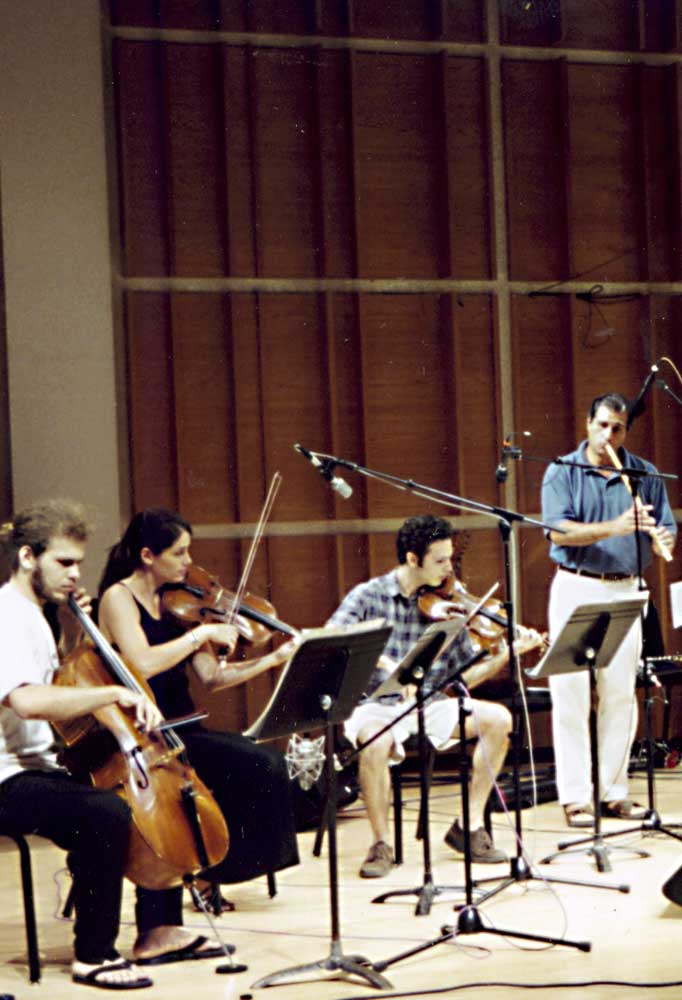
2
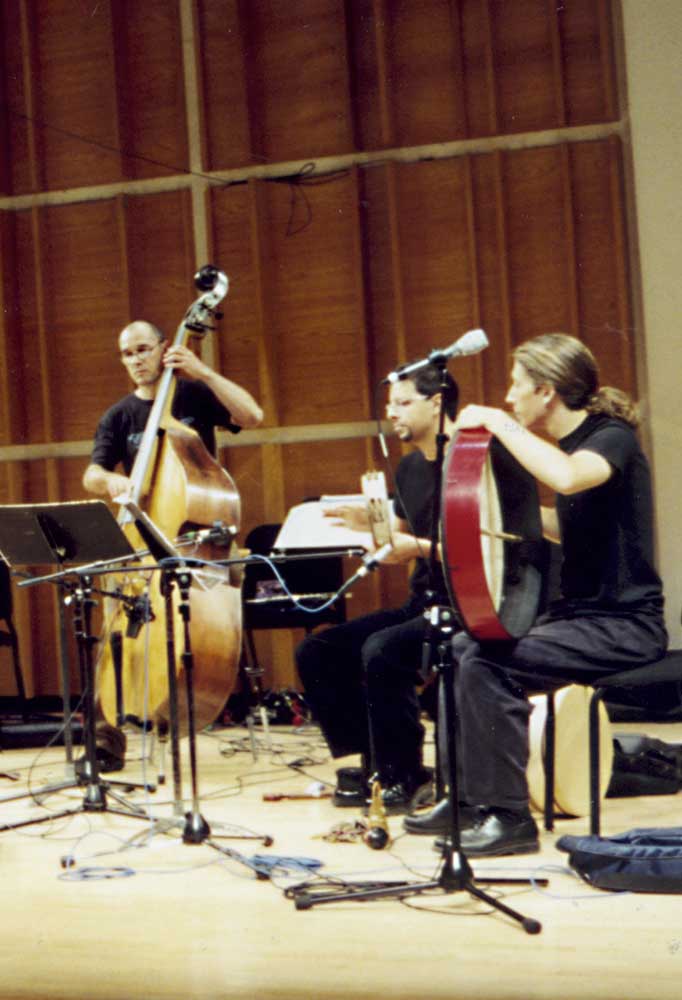
3
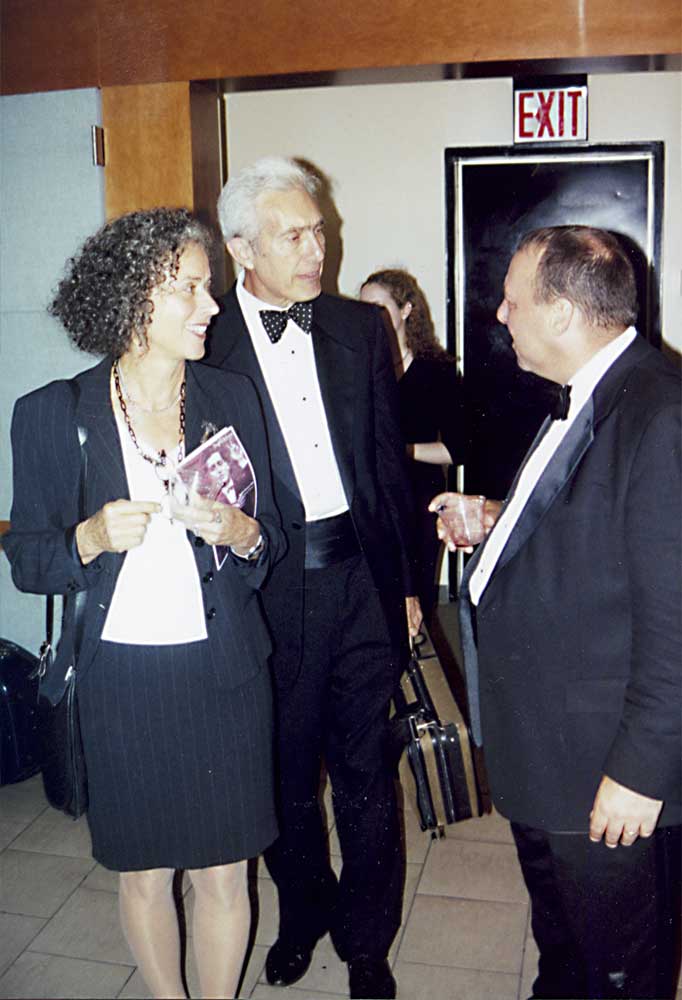
4
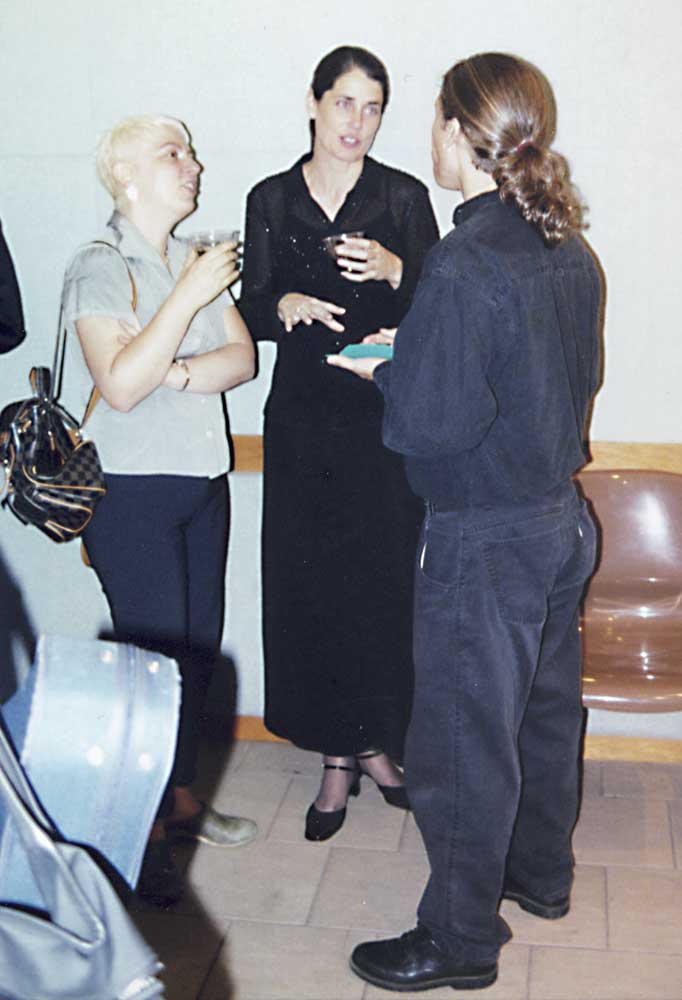
5
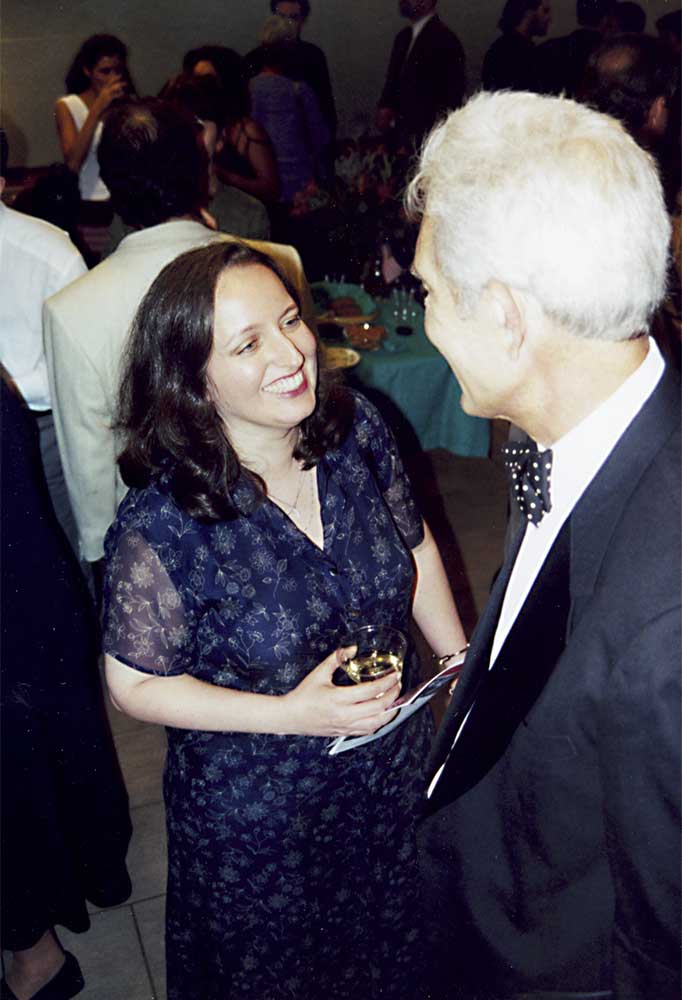
6
1) Violinist Arnold Steinhardt (left) and Egyptian singer/composer Kamel Boutros, who premiered a song about peace with verses in Hebrew and Arabic which Boutros wrote for the occasion.
2) Basam Saba (standing) plays with Musique Sans Frontières.
3) French bass player/composer Patrick Derivaz (left), founder of “Musique Sans Frontières,” which made its debut in the 2002 concert.
4) Arnold Steinhardt (center) and cellist Peter Wiley (right) of the Guarneri Quartet.
5) Albanian cellist Rubin Kodheli (right), a member of “Musique Sans Frontières,” at the reception following the concert.
6) Allegra Klein, Executive Director & Founder of MFH, with Arnold Steinhardt.
Photos by Mark Rabinow.



